Better Sailing
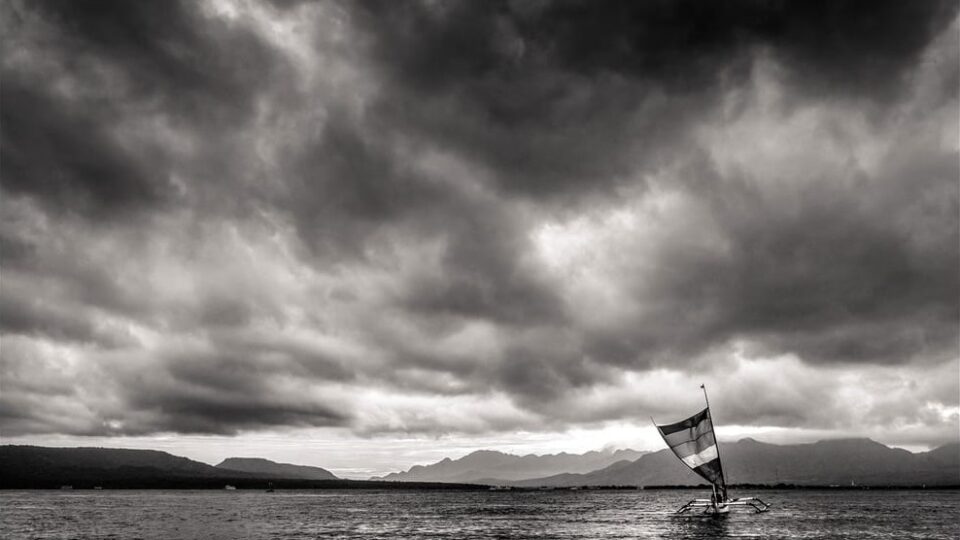

Is It Safe to Sail in a Thunderstorm?
As a matter of fact, a mariner’s worst nightmare is thunderstorms. They can form quickly, resulting in hazardous wind and wave conditions. Thunderstorms can bring gusting winds, lightning, waterspouts, and torrential downpours, turning a pleasant day of sailing into a nightmare. If you’re already at sea, lightning strikes, like collisions with whales or floating cargo, can’t be avoided, and thunderstorms are among nature’s most powerful forces. So, in this article, I’m going to examine if it’s dangerous to sail during a thunderstorm. If you want to know more about it, keep reading!
General Info about Thunderstorms
Squall line thunderstorms that have developed over land also occur at sea. Thunderstorms that originate at sea are most common in the early hours of the morning, around sunrise. Tropical thunderstorms, on the other hand, can strike at any time, often on a daily basis. This is because of the strong heating over land and an endless supply of moist tropical air from the sea. Note that a lightning bolt is the result of thunder. Lightning is a powerful current that lasts only a few seconds. In general, bolts of lightning can destroy electrical and navigation systems, vaporize antennas, create holes in the hull, and cause fires.
Although there are no special lightning warnings or advisories, all thunderstorms create lightning. A vessel struck by lightning can be disastrous, especially if it causes a fire or damage to the electronics. It’s advisable to stay in the interior of your boat and avoid touching metal or electrical devices. And, stay as low as possible in the boat if your boat doesn’t have a cabin. When thunderstorms are present, boaters should exercise extreme caution and have a plan of escape. Keep in mind that sailors are particularly vulnerable since they may not be able to reach port on time. It is therefore strongly advised that you do not go outside if thunderstorms are expected.
So, if you’re sailing and notice thunderstorms approaching, get to a port or a safe shelter as soon as possible. Finally, note that planning and training ashore are essential for boating safety. Remember that thunderstorms are usually only a few minutes long, so waiting it out is preferable to riding it out.

>>Also Read: Are Sailboats Safe?
Lightning Protection on a Sailboat
The following system must be installed on your boat to provide lightning protection: A sharp-pointed rod (lightning rod) must be attached to a good conductor of electricity at the boat’s highest point. Note that in case the mast is from metal you can use it. Run a thick copper wire (#8AWG) from the rod or mast to a metal keel. Without any bends, this wire should be straight. Mechanically, all connections must be sturdy. Metal keel plates must be bolted through the hull and have strong electrical contact with the water.
In theory, a properly grounded mast (lightning rod) will provide a protective cone. The rod’s point should extend at least 6 inches above whatever it is protecting. The cone then makes a roughly 60-degree angle with the vertical, with a radius of 1.5 to 2 times the height of the lightning rod at the waterline. If the entire boat is within this cone, the protection will be at least 99 percent of potential strikes. Note that the protection is 99.9% when the temperature is below 45 degrees.
If you’re caught in a thunderstorm, everyone should stay in the middle of the boat. Also, in case you have a microwave, put your hand-held VHF or GPS in there. If not, keep it at least a few feet away from anything metallic. In addition, don’t allow anyone to enter the water. Lastly, note that you shouldn’t touch or approach anything metallic.
How Possible Is It for a Sailboat to Get Hit by a Lightning?
When in the thick of a lightning storm, sailboat masts appear to be hit all the time. However, it is not true that they do. Many times, sailors caught in the middle of a thunderstorm are completely unaffected. At the same time, the water in their immediate vicinity is impacted dozens of times. When you’re sailing on a monohull sailboat, you have a 0.4 percent chance of being hit. And, the bigger the boat, the more lightning is likely to strike. That may not seem like a lot, but it’s still one out of every 1000 boats.
Okay, so the lighting isn’t the main problem. However, if you are hit, you will have serious problems, and it might be extremely dangerous. In case you have to change the position of your boat you can do it. However, make sure you’ve sailed in bad weather and can deal with it before attempting this. Also, have some contingency plans in place in case the worst happens.
Consequences of Lightnings on Sailboats
There’s no need to worry every time there’s any lightning nearby. Although it is possible, impact does not frequently result in fires. It is important to note that each impact is unique. Every time a lightning strike occurs, the intensity of the impact varies. However, in the vast majority of cases, the same thing occurs. To begin with, your rigging may be fried, perhaps completely destroyed. Damages to your electronic equipment are also possible. Moreover, bolts of lightning can remove parts of your wiring which will cause a fire or explosion of the batteries. Lastly, damages on the hull or blowing out thru-hull fittings are also possible.
Even if a lightning strike misses you, if the impact is close enough and powerful enough, damages to your electronics are likely to happen. This is because of the peak voltage and it’s possible to occur even if your devices are off. Furthermore, a full-fledged impact could bring your mast down, but this is quite rare. And, note that damages to your rigging will make it impossible to handle the sails.
During most thunderstorms, sailors are already below decks, seeking shelter from the rain. Lightning is still a concern for ten minutes or more after the rain stops and even when the sun comes out. As the storm approaches, lightning can also pose a risk. Note that the storm could be a long way away and the sky could be clear. And, it’s still feasible that a lightning strike would occur.
Preventing Damages Caused by Thunderstorms
In order to prevent damage to your sailboat caused by bolts of lightning and thunderstorms, you can use a piece of anchor chain to prevent the lightning. Wrap it around the mast like a cap shroud, then drop the end into the water. This causes a form of earth return, which is supposed to keep lightning strikes at bay. Note that an electrical charge dissipator can be installed in the masthead. This will prevent the mast from being dragged down by the impact.
Finding yourself without a means of navigation is one of the most likely and worst things that can happen after an impact. Lightning has the potential to ruin your GPS and even flip your compass. So, consider investing in a battery-powered backup GPS receiver. Note that you have to keep it away from any metal parts. It’s practical because you can use it in order to save waypoints such as the harbor entrance and shallows.
What to Do in a Thunderstorm
In case your batteries are dead and you can’t use your sails, you can start the engine. And, even if the mast and batteries are lost, you should start your engine to ensure that you maintain full control of your sailboat. But, on the other hand, you won’t be able to start your engine in case your batteries are fried. And, the worst-case scenario is if there are strong winds and you can’t use your sails. Also, you won’t be able to maneuver the bow into the wind so as to avoid capsizing. You should reef your sails immediately in the event of strong winds or unpredictably changing conditions. Don’t wait for the storm to really get going. Acting quickly will save you a great deal of time.
Bear in mind that you shouldn’t hold anything made of metal. When securing the boat avoid touching any metal pieces throughout the duration of the storm. This lowers your chances of being hit by an impact. Of course, you should have a fire extinguisher onboard. And, note that it’s safer for anyone to be below deck during a thunderstorm. In the event of an impact, this will be the safest location. Don’t forget that you should unplug all electronic devices. Remove all electronics’ wires and consider putting them in the oven. Many people say that this trick works.
Preparation
It’s possible for lightning to strike up to ten miles away from the cloud that caused it. Keep in mind that just because you’re in the middle of a thunderstorm doesn’t imply you’ll get struck. However, some sailors who were hit reported varying degrees of electrical equipment damage, but no structural or fire damage. Here’s what you should do in order to prepare yourself and your boat in the event of a thunderstorm:
- Turn off all electronics as the storm approaches. Modern devices and equipment have increasingly effective internal protection, but makers still recommend shutting it off.
- Touching metal on the boat, such as shrouds and guardrails, is never a good idea.
- In most cases, the light from a nearby strike will be blinding. So, consider sitting in the cockpit until you regain your night vision.
- Make a fix and write it down on a piece of paper. Use dead reckoning to update your log.
- Masthead units, VHF antennas, and lights are likely to be destroyed, so bring a good quality spare VHF antenna.
- Unplug all masthead components, including wind instruments and VHF antennas, and keep leads separate to prevent arcing.
- Following a strike, fluxgate compasses might lose their calibration. With a portable compass, double-check any electronic compass readings.
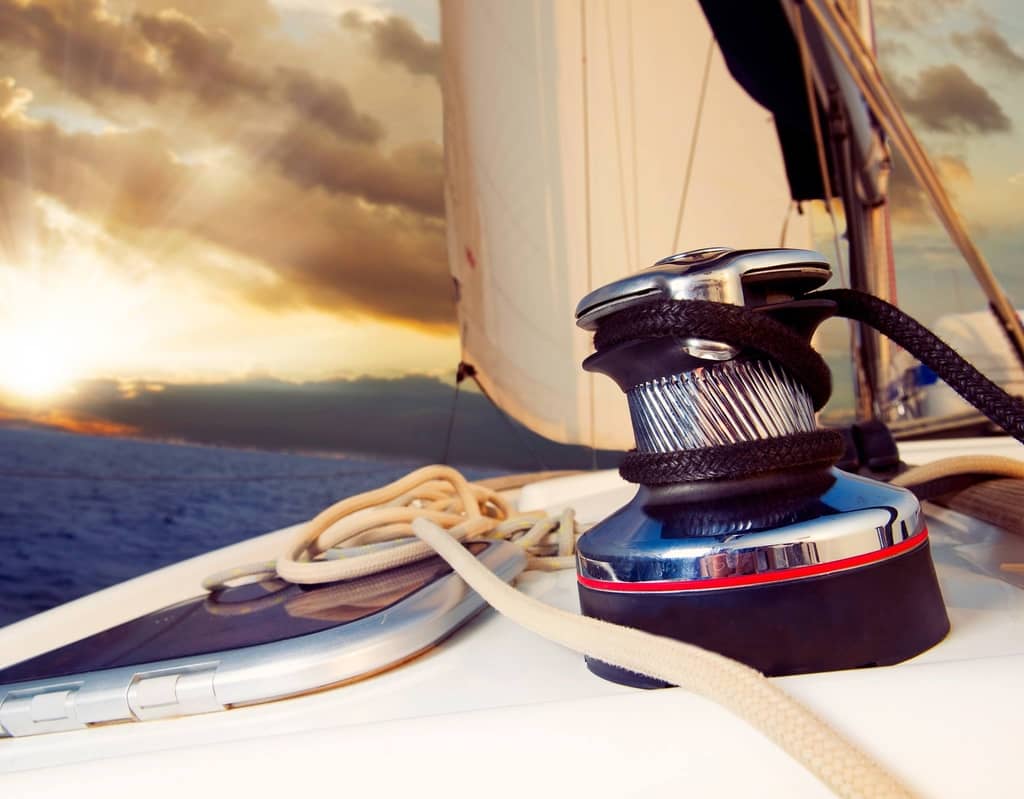
>>Also Read: Are Waterspouts Dangerous to Boats?
Storm Strategy
Once you’re in the middle of a thunderstorm, storm strategies can assist you to deal with it. There are a few tried-and-true options for reducing strain and motion by directing one of the boat’s ends (bow or stern) toward the waves. In all conditions, note that no single technique will work well for all boats.
Sailing with a storm jib and a deeply reefed mainsail or storm trysail is preferable. This method gives you the most control. In the waves, sails provide you the ability to turn and control your boat. Run ahead of the storm, with the stern facing the waves and perhaps a drogue to slow the boat down. Keep in mind that this tactic necessitates a large amount of sea room and active steering of the boat.
Another risk is that you would stay in front of an approaching storm instead of sailing away from it. So, what you can do on a narrow reach, is to heave-to with the jib trimmed to windward. Heaving-to is a good heavy-weather strategy, however certain boats perform better than others. While hove-to or beneath bare poles, deploy a sea anchor. A sea anchor is a miniature parachute attached to the bow by a line. A sea anchor keeps the bow of the boat up into the waves, preventing the boat from becoming beam to the seas.
Note that the load on the rudder when the boat is pushed aft is another source of concern. Another option is to lie ahull, or simply sit with the sails down. Because you lose control of your angle to the waves and may wind up beam to the ocean, this passive option is less reliable than the other techniques. Furthermore, without the assistance of sails, the motion of the boat rolling in the waves can be debilitating.
Facts about Thunderstorms
- It is a myth that a lightning never strikes the same spot twice. Several strokes of lightning can strike the same location in fast succession in a typical lightning strike. The fact that tall structures are sometimes attacked multiple times every year proves this.
- It is also a myth that there is no risk of being struck by lightning if it is not raining. Lightning bolts can strike up to 10 miles outside of the main storm’s rain area, and they do so often. According to new data on lightning deaths, the majority of deaths occur when the storm appears to be finishing.
- When compared to hurricanes and winter storms, thunderstorms only affect a small area. A typical thunderstorm has a diameter of 15 miles and lasts about 30 minutes. Around the planet, around 1,800 thunderstorms are active at any given time. That’s a total of 16 million every year!
- Thunderstorms are all harmful, no matter how tiny they are. Lightning is produced by every thunderstorm, and it kills more people each year than tornadoes. Some thunderstorms can also bring with them strong winds, hail, and tornadoes.
- If you’re onshore and lightning is approaching, you should lie down flat on the ground. In that situation, the best thing to do is crouch down, which means putting your feet together, squatting low, and tucking your head. Lightning creates electric currents along the ground’s surface that can travel over 100 feet and be lethal. While lying flat keeps you low, it also increases your chances of being impacted by ground currents. You want to be as low as possible while only touching a little portion of the ground. Getting indoors to adequate shelter would obviously be preferable.
- Thunderstorms are most common during the spring and summer months, and in the afternoon and evening hours, but they can happen at any time of day or night. Thunder and lightning can even occur during a snowfall!
- The National Weather Service issues a severe thunderstorm watch when the weather conditions indicate that a severe thunderstorm is likely to form. Winds of at least 58 miles per hour or hail at least three-fourths of an inch in diameter define a severe thunderstorm. When a severe thunderstorm is spotted or indicated by weather radar, a severe thunderstorm warning is issued.

>>Also Read: Is Sailing Dangerous?
Is It Dangerous to Sail in a Thunderstorm? – The Bottom Line
In general, it is dangerous to sail during a thunderstorm. Lightning strikes, on the other hand, are unusual. Unpredictable changes in wind direction and surprise wind gusts are the most dangerous aspects of thunderstorms for sailors. It is generally advised to avoid sailing during storms if at all feasible. As you may know, there are a lot of myths surrounding sailboat masts and electrical storms.
Of course, the true question is whether or not you can set sail when thunderstorms are expected. The basic answer is yes, but I would avoid it if at all possible. The more honest response is that it is entirely up to you. But, once again, I would suggest caution. The likelihood of being struck isn’t as high as most people imagine. Most people believe that in case they get caught in a thunderstorm the complete catastrophe will happen. But, that’s not the case. The most dangerous aspect of the storm is the unpredictable wind that comes with it. Most thunderstorms are accompanied by abrupt shifts in wind direction and speed. In some circumstances, the wind changes direction 180 degrees on a regular basis. It can result in extremely violent gybes, breaking the mainsail, or potentially causing mast damage.
Peter is the editor of Better Sailing. He has sailed for countless hours and has maintained his own boats and sailboats for years. After years of trial and error, he decided to start this website to share the knowledge.
Related Posts

Atlantic vs Pacific: Which is More Dangerous for Sailing?

Why Do Sailboats Lean?

How Does a Boat Sail Upwind? Unveiling the Mechanics of Against the Wind Sailing

How Does Sailing Work? The Physics of Sailing
- Buyer's Guide
- Destinations
- Maintenance
- Sailing Info
Hit enter to search or ESC to close.

What to Do When Sailing in a Storm: The Complete Guide

It’s your worst nightmare come to life. You’re sailing along in perfectly calm weather when suddenly, the skies gray, thunder booms in the distance and the waves get choppy. Even if you never end up in such a scenario, it’s still a good idea to be ready just in case. What should you do when sailing in a storm?
To stay safe on your sailboat in stormy conditions, remember these tips:
- Make a storm preparedness plan before you venture out
- Don’t freak out, especially when you’re sailing with other people
- Put on your life jacket if you’re not already wearing it and tell your crew to do the same
- Learn how to recognize a storm
- Seek a path that avoids the storm
- Lie ahull, in which you ride out the storm with the sail down
- Use your storm sails to maintain control and steering through rough conditions
- Heave-to, in which you trim your jib and then the main while lashing your helm for steerageway
- Check the weather forecast to avoid future dangers
In this in-depth, complete guide, we’ll walk you through all the above points in much greater detail. Let’s get started.
Sailing in a Storm? 9 Tips for Safe Travels
Have a storm preparedness plan at the ready.
As a sailor, you have to anticipate every possible scenario you might encounter on your boat, even the most unlikely and awful ones. Having a plan to get out of such situations gives you peace of mind. You’ll also have a set of steps to act on so you can hop right to it when trouble comes.
If you often sail with a group of others, sit down with your crew and come up with a storm preparedness plan. You might ask some crew members to man the back of your sailboat and others the front, or someone might unleash the storm sails and others the luff. Whatever it is you want to do on your sailboat, make a plan.
Having a storm preparedness plan doesn’t mean you can’t ever deviate from it. In some situations, it may be more appropriate to heave-to or sail away from the storm, and if so, that’s what you should do.
If this is your first storm aboard a boat, then it’s natural to feel nervous and very unsettled. That’s to be expected. Even seasoned sailors aren’t particularly comfortable handling storms, but they do what they have to.
If you’re captaining a crew especially, you must maintain your poker face. Internally, you can feel turmoil, but outside, you must be stoic, calm, and ready to tackle anything. Even if you’re by yourself, freaking out does nothing but misguide your energy towards your panic. You could also get yourself so worked up that you can’t think straight, causing you to make critical mistakes.
Remember the storm preparedness plan you came up with. Begin completing steps per that plan. Once that starts coming together for you, you should surely calm down.
Besides feeling panicky, make sure to prevent discord among your crew members. They may have agreed to work certain stations when you created your storm preparedness plan, but now that the time has come to actually enact the plan, some crew members might get annoyed or argumentative about their assigned tasks.
Remind your crew that everyone’s lives are at risk until you can get to safety. That should help them recall that there are more important things to worry about right now than who gets to do which task.
Wear Your Life Jacket
Make sure that when drawing up your storm preparedness plan that you remember to include life jackets in there somewhere. There should be enough life jackets for yourself as well as anyone else you have onboard your sailboat.
Not all life jackets are made the same. The U.S. Coast Guard approves of several types or classes of life jacket.
For potential sailing emergencies, we’d recommend Type I, or offshore life jackets. These are ideal when riding in remote waters, rougher seas, and open ocean when you may be stranded for a while. The reflective tape and eye-catching color grab attention. Also, if you or a crew member were to become unconscious after a storm-related boating accident, a Type I life jacket would turn you over so your face is up and out of the water.
You might also invest in a Type II life jacket, which is a near-shore vest. Don these life jackets if riding in inland waters where the conditions are calm and you may be rescued fast. You won’t necessarily be flipped up by your life vest if it’s a Type II, so all your crew members must be conscious when wearing this life jacket.
Know How to Recognize a Storm
You’re no weatherperson, but if you’re a trained sailor, then you should have a knack for predicting storms. Well, predicting maybe isn’t the right word, as you’re using your senses to gauge your surroundings and determine when a weather event may come.
How do you do that? Here are some signs that a thunderstorm could soon roll in on the water:
- The cirrus clouds travel quickly. If you don’t know, cirrus clouds are the shorter, singular clouds that have edges like hair. These clouds are also always at a higher altitude.
- The moon or sun develops a halo around it. This is a sign of humidity, which is typically a predictor of a storm. Look at the brightness of the halo to get a feel for what kind of weather you’re expecting. If the halo is dimmer, the storm won’t be that bad, but a bright halo indicates very inclement weather ahead.
- Look at the birds in the sky, especially the puffins, tropic birds, cormorants, frigate birds, sea ducks, and gulls. Are they all moving away from the sea towards the shoreline? That’s happening for a reason. A storm is imminent.
- Invest in a barometer, a weather tool that tracks your air pressure. If the barometer suddenly gives you a low reading, then the air pressure likely decreased because of an impending storm.
Move from the Storm If You Can
Now that you know a storm is on its way, you have some decision-making to do, and fast. You can either head towards the open ocean or towards shore. Which choice is the smarter one will vary depending on how far you are from the shoreline and the storm. If the shore is 100 miles away but the storm is 25 miles, then veering from it towards open ocean is your smartest bet.
If you have your heart set on getting to shore, make sure you have a clear path in that direction that doesn’t intersect with the storm. If your sailboat gets gripped by tough winds or hard waves, it could catapult into the shoreline, causing massive damage. Sometimes, it’s better not to risk it.
If Not, Lie Ahull
You can’t always avoid or maneuver away from the storm, especially if it comes on suddenly and you weren’t gauging the weather using the tips above. If not, then add the next three tactics to your storm preparedness plan as a Plan B, C, and D.
Lying ahull means you and your crew undo all the sails and lay them flat against your boat. This will prevent the wind from wrestling you in an unintended direction. Otherwise, you just sit and wait for the storm to pass.
Just because your sails are down does not mean your sailboat can’t capsize or that you’re in total control. You’re still at risk, so you should choose when you want to lie ahull strategically. If you’re expecting a day of moderate yet frequent storms, then lying ahull is a good idea. You and your crew can easily pull the sails down, and doing so doesn’t exert much energy.
Once the storms are finally over, you can begin making your way back to shore, hopefully without sustaining any damage to your boat.
If you’re caught in a particularly nasty storm, we would not advise you to lie ahull. You’re essentially a sitting duck when you do this, so conditions must be relatively safe. Otherwise, you’re much better off trying a few other tactics.
Or Use Your Storm Sails
For example, you can rely on your storm sails. If you’ve never used your storm sails before, here’s an introduction. The storm sail or jib attaches to an inner forestay, which is removable if necessary.
Some sailors use a flat-cut headsail as a storm sail and others a reefed roller genoa. The latter is generally not recommended. Since it’s not flat, the roller genoa can become baggy when the sail’s draft moves. This can also make your sailboat heel.
To lift your storm sail when needed, use a halyard. Your storm sail should be sheeted so it’s in a close-haul position. Jot down where the sail’s track is so you can determine pennant length at the stay base. When bad weather calls for you to use your storm sail, you can then connect your pennant to your stay base, hoisting your storm sail when you do.
The International Security Assistance Force or ISAF has published a set of rules known as the Offshore Special Regulations for Storm and Heavy Weather Sails. The rules encompass your sailboat’s storm sail, so keep these in mind when using the sail:
- Cut the luff by almost half (40 percent) when raising a reefed mainsail instead of a trysail.
- Measure the foretriangle to height squared. Then, ensure your staysail, also known as a heavy-weather jib, doesn’t exceed that height squared by more than 13.5 percent.
- You also need to know your forestay length, as the luff can’t be more than 65 percent of it.
- Calculate your foretriangle in height squared, then confirm your storm jib isn’t more than five percent of that.
- You must be able to sheet your trysail without the boom.
- The boom length by the luff length must be larger than the trysail, which needs an area less than 17.5 percent.
- You can’t rely solely on your luff groove when attaching the storm jib.
- You cannot use a high-tech fiber sail as your storm sail.
Or Even Heave-to
The third strategy we’d suggest when sailing in a storm is the heave-to. This is a means of stopping your boat, especially in conditions where the air is especially heavy and your sails could use a break.
If you’ve never done a heave-to before, first, you want to trim your jib so it’s facing the opposite (and yes, the wrong) side it usually does. Next, you want to trim your main, doing so hard. By lashing your helm after that, your sailboat has steerageway. This is just the least amount of speed needed for your helm to work.
Your sailboat, which moves up to get steerageway, will also go forward. This happens because your jib attempts to put downward pressure on the bow. Your bow then moves away from the wind, allowing the main to fill and propel your sailboat.
As you move, your lashed helm should move you in the direction of the wind. Your main sail will also soften. That’s when the jib goes into action, moving the bow as it had tried before. Your main sail fills back up so the rudder moves the bow towards the wind.
Your boat should be far enough from the wind, at least 60 degrees, that your speed is reduced to no more than 2 knots. Your sailboat also becomes more stable, especially compared to lying ahull.
You may have issues with the heave-to depending on which sails are up and how blustery the winds are on that particular day. You might need a sea anchor, attached near the bow, to keep your boat mostly still for the heave-to.
Never Sail Without Knowing the Weather
Using the advice and information in this article, you were able to navigate your sailboat safely back to shore in stormy conditions. You and your crew all admit it was quite an experience, and not one you’d like to repeat again anytime soon.
You don’t necessarily have to. Long before you ever have to look at the clouds and the birds around you to determine whether it will storm, you can use a weather app or website. We would recommend you make this a habit on the days you plan to set sail.
It’s not enough to check the forecast earlier in the week and then head out on the weekend. Weather forecasts change all the time, and you must be prepared. Look at the forecast at the beginning of the week, sure, but then also two days before you go out.
The night before your sailing trip, check the forecast again. Look hour by hour to see what kind of weather is predicted in your area. If your weather service offers a radar, use this too, as it shows when storms may roll in and when they would be their worst.
If inclement weather is on the forecast, we’d strongly dissuade you from sailing. Yes, there’s always a chance the forecast might be incorrect, but is it really worth chancing it? All it takes is surviving one scary experience at sea in a storm to say no, it isn’t.
Conclusion
Is a storm a-brewing while you’re out on the sea in your sailboat? The best way to avoid a storm is to never go out in inclement weather at all. If it’s already too late for that, then you can try a variety of tactics to get through the storm, such as the heave-to, lying ahull, or raising your storm sails. In some cases, you can sail back to shore or into open ocean to dodge the storm altogether.
The most important element of storm survival on your sailboat is the full understanding, communication, and cooperation among you and your fellow crew members. Stay safe!
I am the owner of sailoradvice. I live in Birmingham, UK and love to sail with my wife and three boys throughout the year.
Recent Posts
How To Sail From The Great Lakes To The Ocean
It’s a feat in and of itself to sail to the Great Lakes. Now you want to take it one step further and reach the ocean, notably, the Atlantic Ocean. How do you chart a sailing course to get to the...
Can You Sail from the Great Lakes to the Gulf of Mexico by Boat? 
You have years of boating experience and consider yourself quite an accomplished sailor. Lately, you’ve been interested in challenging yourself and traveling greater distances than ever before. If...
- 2024 BOAT BUYERS GUIDE
- Email Newsletters
- Boat of the Year
- 2024 Freshwater Boat and Gear Buyers Guide
- 2024 Boat Buyers Guide
- 2024 Water Sports Boat Buyers Guide
- 2023 Pontoon Boat Buyers Guide
- Cruising Boats
- Pontoon Boats
- Fishing Boats
- Personal Watercraft
- Water Sports
- Boat Walkthroughs
- What To Look For
- Best Marine Electronics & Technology
- Watersports Favorites Spring 2022
- Boating Lab
- Boating Safety

What to do in a Lightning Storm on a Boat
- By Mike Telleria
- Updated: February 10, 2020
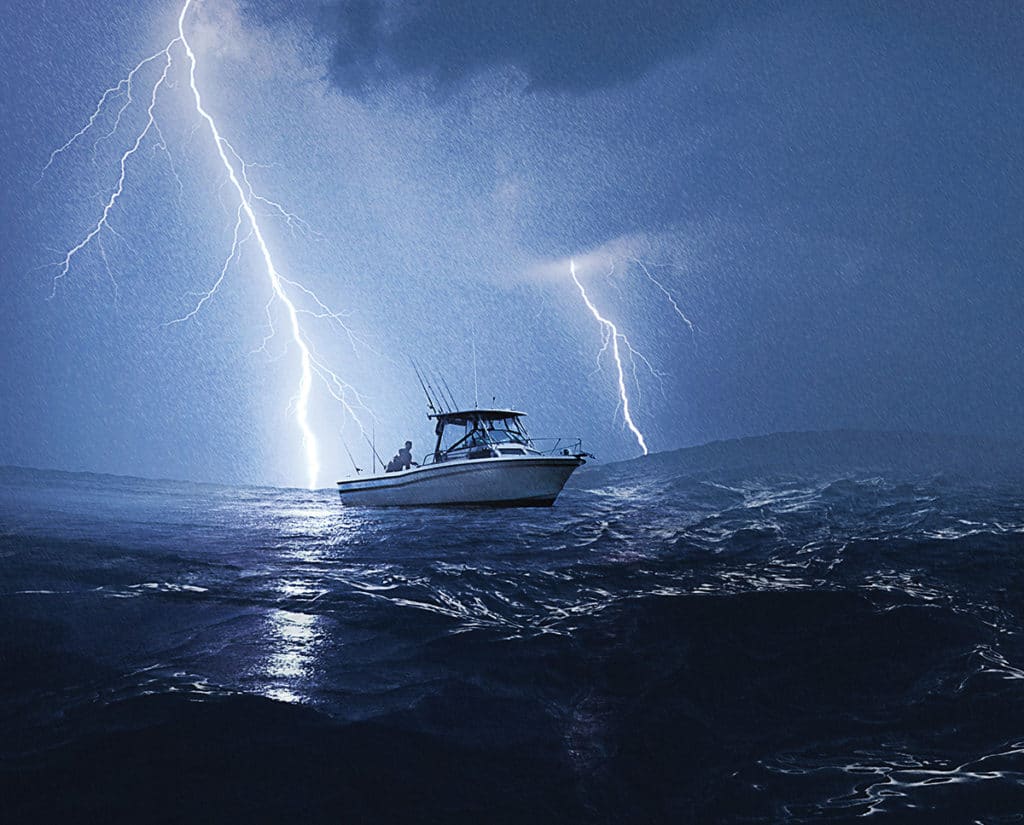
Powerful, dangerous, highly unpredictable — all are common descriptions of lightning storms. A direct strike that results only in ringing ears and a few roasted electronics would be considered lucky. Unlucky would be through-hulls blown out, a sunk boat or worse — possibly serious injury or death.
Many powerboaters like to think that they’ve got the speed to simply outrun or get out of the way of lightning storms , or they figure they’re safe if they go boating only when it’s clear and sunny. That’s an attitude aided by the low odds of a boat being struck by lightning, which BoatU.S. pegs at about one out of 1,000 boats in any given year.
No worries, right, mate? Wrong.
Engines can malfunction ; big lightning storms can leave no room to escape; sunny mornings can turn into dark, threatening afternoons. If yours is the only boat in the area during a lightning storm, the odds of being struck go way up, leaving you and your crew vulnerable to millions of volts raining down from the skies. Lightning and boats do not mix. While manufacturers can build in a degree of protection, lightning protection begins with boaters being informed and prepared to act in the event of a thunderstorm or actual strike. You should know the following techniques and strategies.

Boating in a Thunderstorm is Bound to Happen at Some Point
A strategy of boating only on sunny, cloudless days may work well in places like Idaho and California, but that would mean almost never using the boat in places such as Florida, Louisiana and much of the Midwest. For example, most of Florida — the Sunshine State — has at least 70 to 80 thunderstorm days per year, with some parts having more than 100 thunderstorm days per year (with increased activity during the summer months).
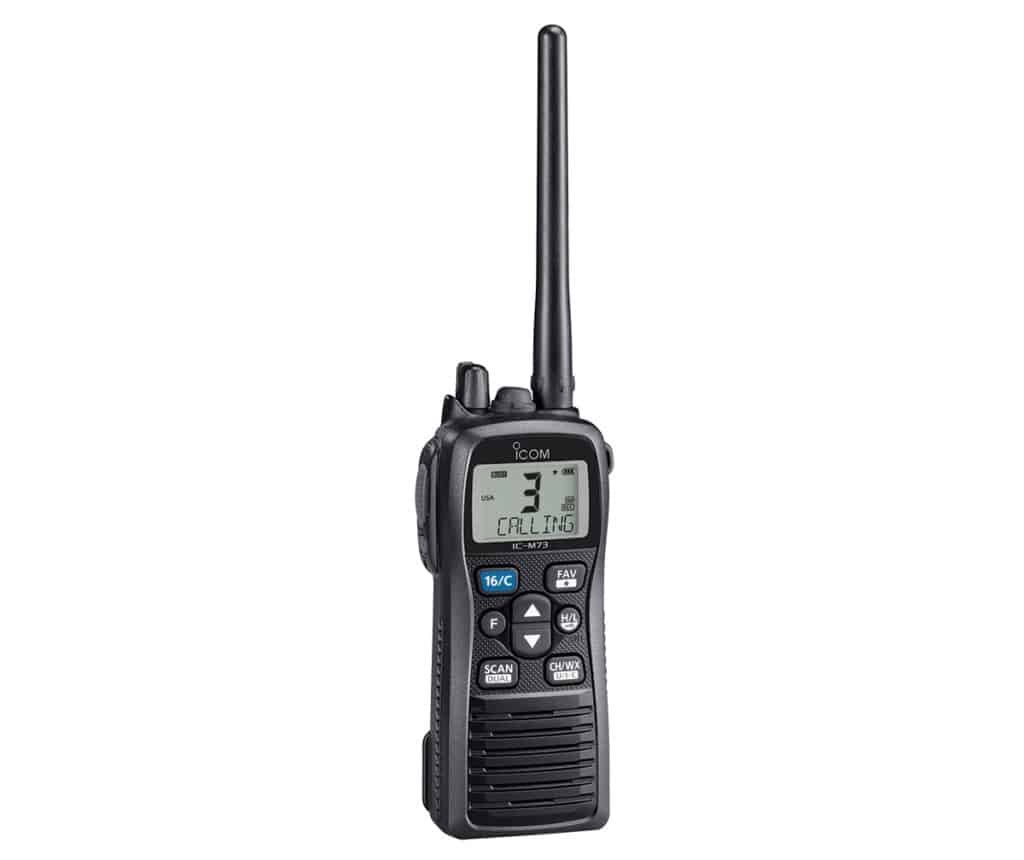
Absolutely, boaters should track VHF , Internet and television weather reports and make responsible decisions about whether to go boating depending on the likelihood of lightning storms. Short-term forecasts can actually be fairly good at predicting bigger storms, but small, localized storms might not be reported. This is when knowing how to read the weather yourself can come in handy. (The U.S. Power Squadrons offers great weather courses for boaters, and there are many books that cover the basics.)
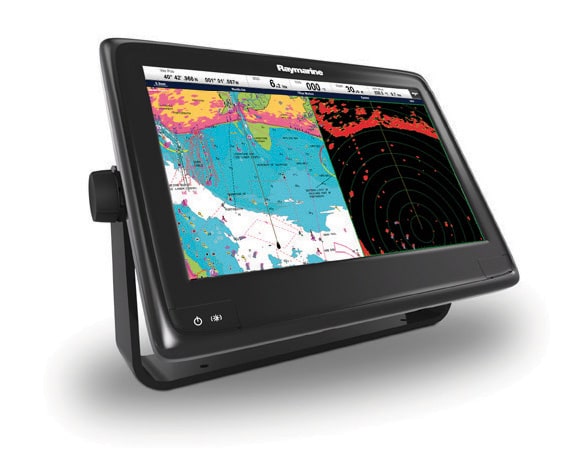
Lightning strikes typically occur in the afternoon. (Florida estimates 70 percent occur between noon and 6 p.m.) A towering buildup of puffy, cotton-white clouds that rise to the customary flat “anvil” top is a good indication to clear the water and seek shelter — or move out of the storm’s path if possible. That’s if the storm is at least somewhat off in the distance (most storms are about 15 miles in diameter and can build to dangerous levels in fewer than 30 minutes). If lightning and thunder are present, just count the seconds between the lightning and corresponding thunder and then divide by 5 — this will provide a rough estimate of how many miles away the storm is.

A storm that builds directly overhead might be less obvious until those pretty white clouds that were providing some nice shade moments ago turn a threatening hue of gray as rain dumps on you and the wind starts to howl or, worse yet, boom with thunder and lightning that are right on top of each other. Now is the time for a mad dash to the dock and shelter if close by. Like the National Weather Service says: “When thunder roars, go indoors!” You really don’t want to be on a boat struck by lightning. If out on open water or too far from shore and shelter, it’s time to hunker down and ride it out.

Caught in Thunderstorm on a Boat
Boaters who have been struck by lightning often begin their stories with “I was caught in this storm … ” before they share their miraculous or harrowing tales of survival and destruction (BoatU.S. has a number of first-person storm stories archived online: boatus.com/seaworthy/swthunder). Even though getting caught in a storm is not always avoidable, there’s still plenty that boaters can do to minimize the chance of a strike and lessen injury and damage if there is a strike.
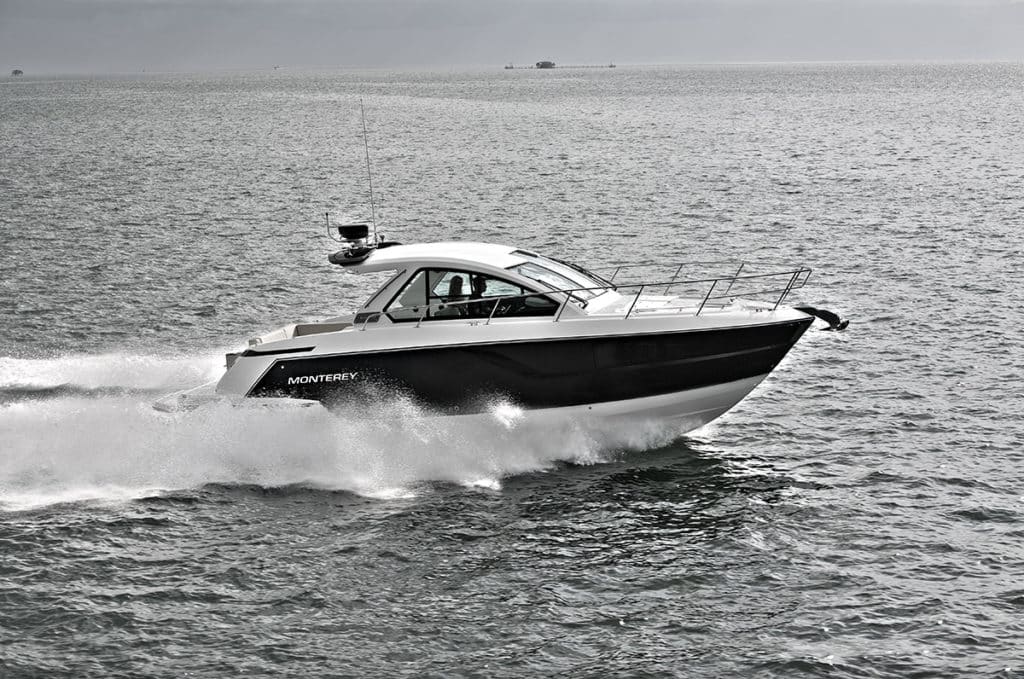
How to Stay Safest in a Thunderstorm
We all learn in grade school that it is not safe to be outside during a lightning storm. We also learned that lightning seeks the highest point, and on the water that’s the top of the boat — typically a mast, antenna, Bimini top, fishing rod in a vertical rod holder or even the tallest person in an open boat. If possible, find a protected area out of the wind and drop anchor . If the boat has an enclosed cabin, people should be directed to go inside and stay well away from metal objects, electrical outlets and appliances (it’s a good idea to don life jackets too). Side flashes can jump from metal objects to other objects — even bodies — as they seek a path to water.

A Microwave Oven is a Faraday Cage
Lowering antennas, towers, fishing rods and outriggers is also advised, unless they’re part of a designated lightning-protection system. Some boaters also like to disconnect the connections and power leads to their antennas and other electronics, which are often damaged or destroyed during a strike or near strike.
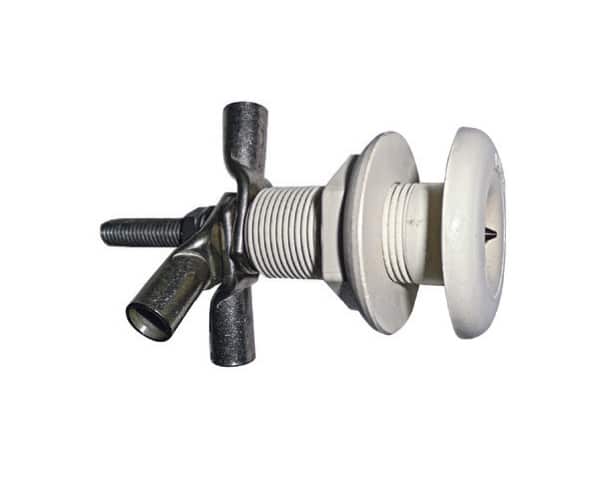
Under no circumstances should the VHF radio be used during an electrical storm unless it’s an emergency (handhelds are OK). Also, be careful not to grab two metal objects, like a metal steering wheel and metal railing — that can be a deadly spot to be if there’s a strike. Some boaters opt to steer with a wooden spoon and keep their other hand in a pocket if forced to man the helm during a storm, while others like to wear rubber gloves for insulation.
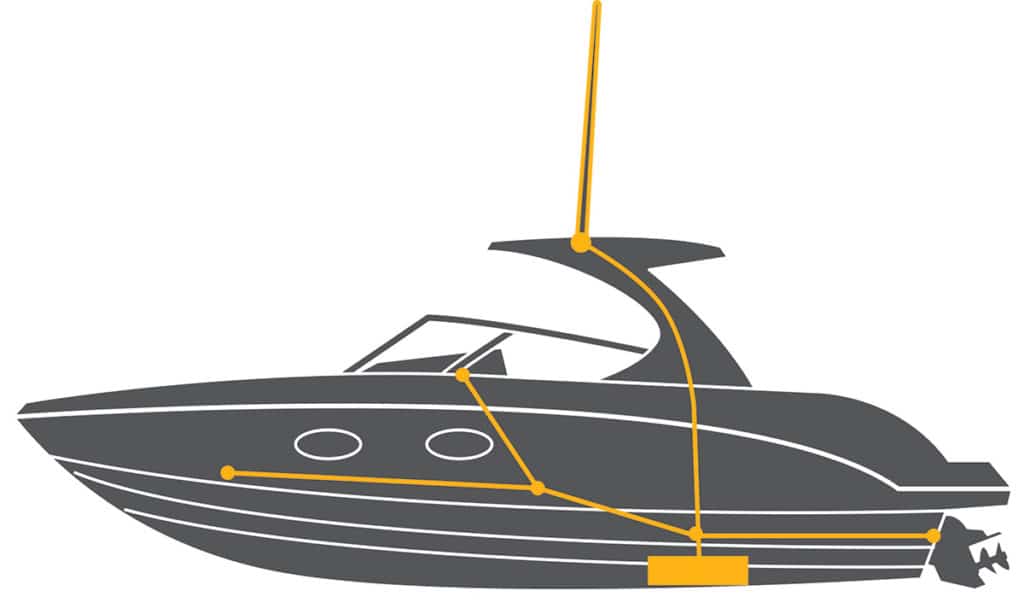
Surviving Lightning Strikes While Boating
An open boat like a runabout is the most dangerous to human life during lightning storms, since you are the highest point and most likely to get hit if the boat is struck. If shore is out of reach, the advice is to drop anchor, remove all metal jewelry, put on life jackets and get low in the center of the boat. Definitely stay out of the water and stow the fishing rods.
If all goes well, the storm will blow past or rain itself out in 20 to 30 minutes. It’s best to wait at least 30 minutes until after the last clap of thunder to resume activities.
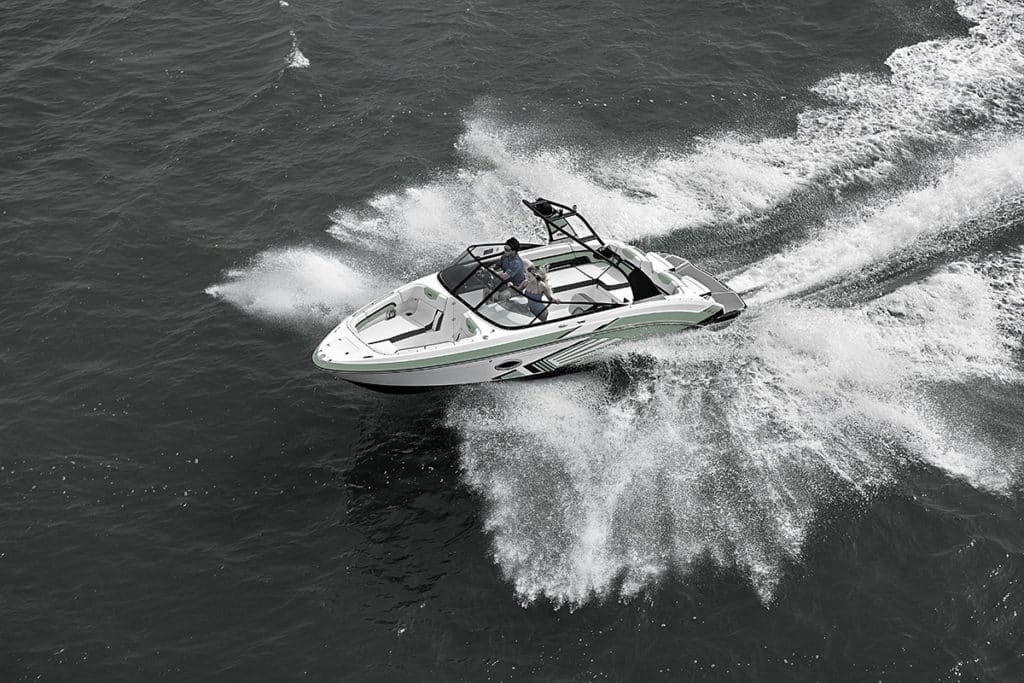
There’s a Zap For That
What to do when your boat is struck by lightning.
Knowing what to do in a storm and having the best lightning-protection system installed on the boat is by no means a guarantee that lightning won’t strike. The immediate checklist for a direct hit is very short:
1. Check for unconscious or injured persons first. If they’re moving and breathing, they’ll likely be OK. Immediately begin CPR on unconscious victims if a pulse and/or breathing is absent — there’s no danger of being shocked by someone just struck by lightning.
2. In the meantime, have someone check the bilges for water. It’s rare, but lightning can blow out a transducer or through-hull — or even just blow a hole in the boat. Plug the hole, get the bilge pumps running, work the bail bucket — whatever it takes to stay afloat. An emergency call on the VHF is warranted if the situation is dire. If the radio is toast, break out the flare kit.
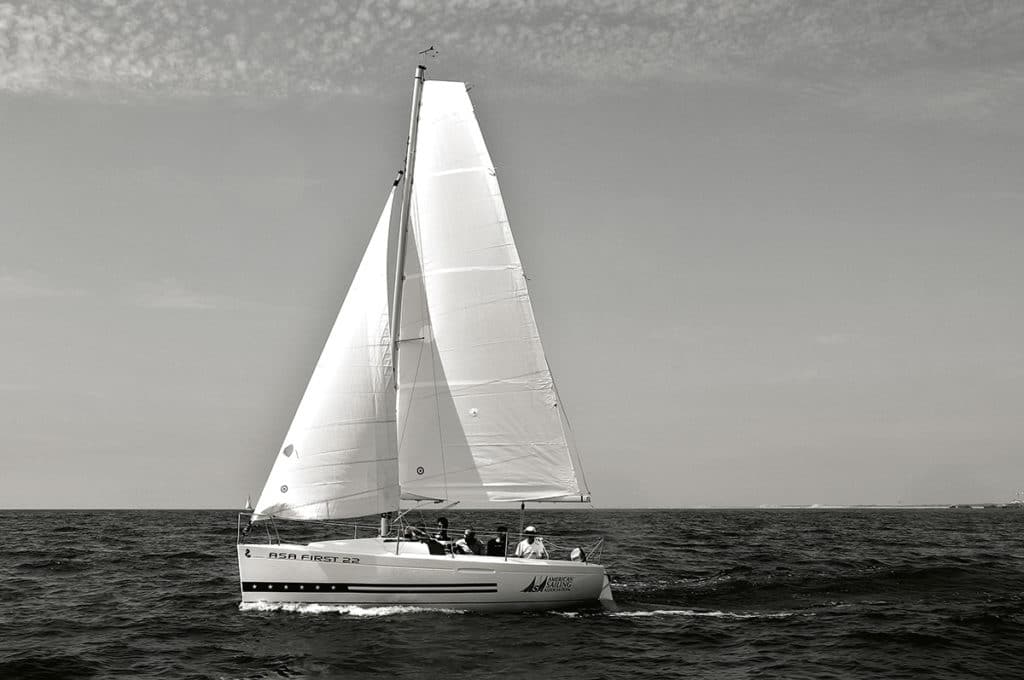
If there are no injuries and no holes or major leaks below, just continue to wait it out. Once the danger has passed, check the operation of the engine and all electronics. Even a near strike can fry electronics and an engine’s electronic control unit, cutting off navigation, communication and even propulsion. Some boaters stash charged handheld VHF and GPS units and a spare engine ECU in the microwave or a tin box for this very reason. These makeshift Faraday cages have saved equipment.
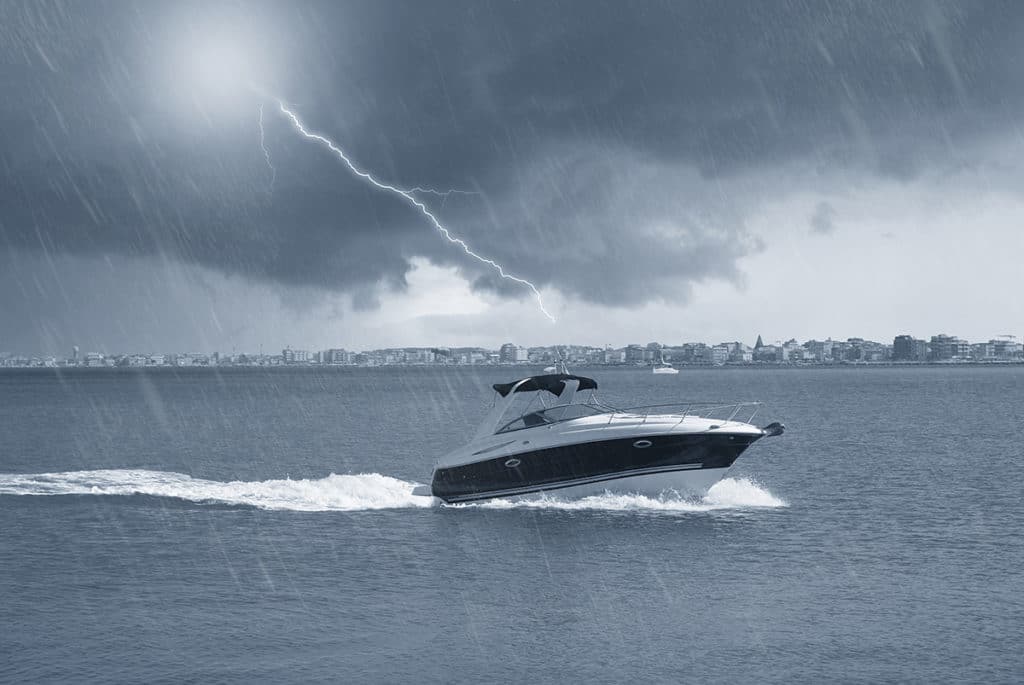
One in 1,000 Boats Are Hit by Lightning Per Year
Obvious damage will need to be assessed and set right. Even those lucky enough to come away completely unscathed after lighting storms, with no apparent damage should have a professional survey done just to be sure. Minor damage to through-hulls can result in slow leaks, and all manner of electrical wackiness can emerge — sometimes much later. It’s best to catch these issues right away and get that information to the insurance folks for coverage.
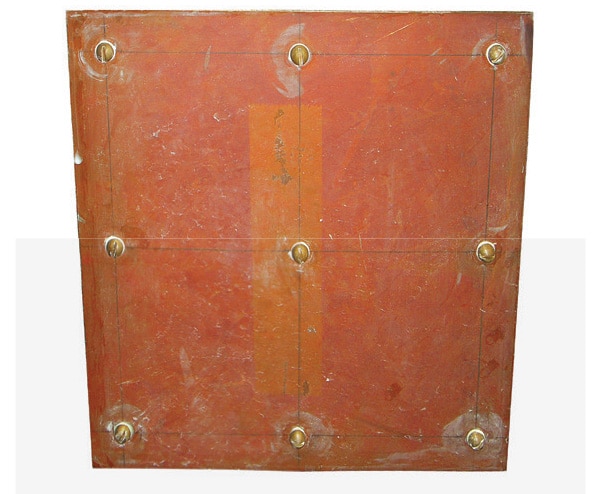
Is Just a Ground Plate Enough?
On many levels, robust insurance coverage plays a huge role in your lightning-protection plan. Knowing how to avoid lighting storms and read the weather are certainly important, being ready for action in the event of a storm or strike is crucial, and an upfront investment in lightning protection can lessen destruction. When it comes to dealing with the aftermath of a damaging strike, however, extensive lightning strike coverage can’t be beat.
Take it from a luxury trawler owner who sustained more than $1 million in damage from a strike: “Boat insurance turns out to be the best investment we have made in the past 10 years!” he said. “We will never again grumble about writing a check for an insurance premium.”
- More: Boating Safety , How-To , spring fitting-out
More How To

Eight Tips for Waxing Your Boat
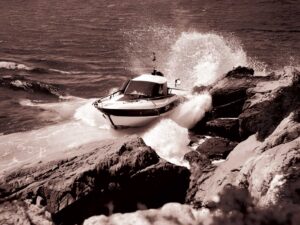
What to Do if Your Boat’s Engine Dies

I Learned About Boating From This: Capsize, Rescue and Lessons Learned
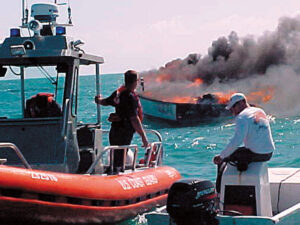
Should You Abandon Ship During a Boat Fire?
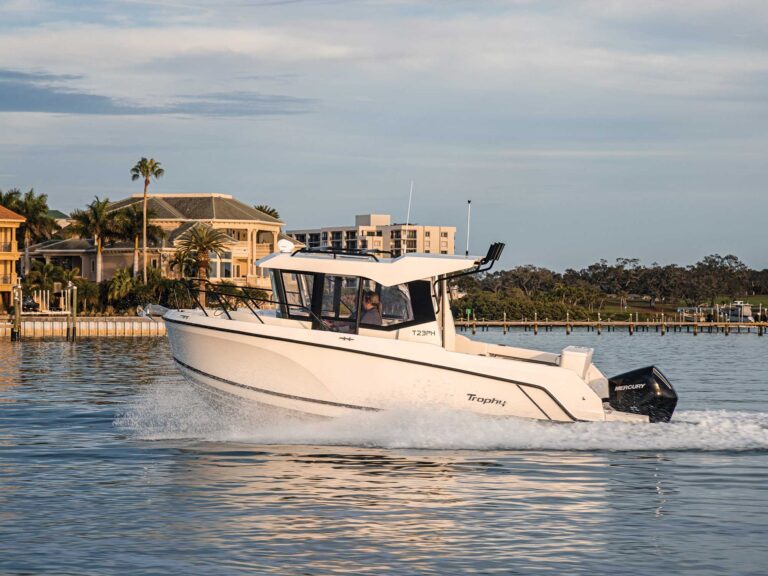
Boat Test: 2024 Bayliner Trophy T23 Pilothouse
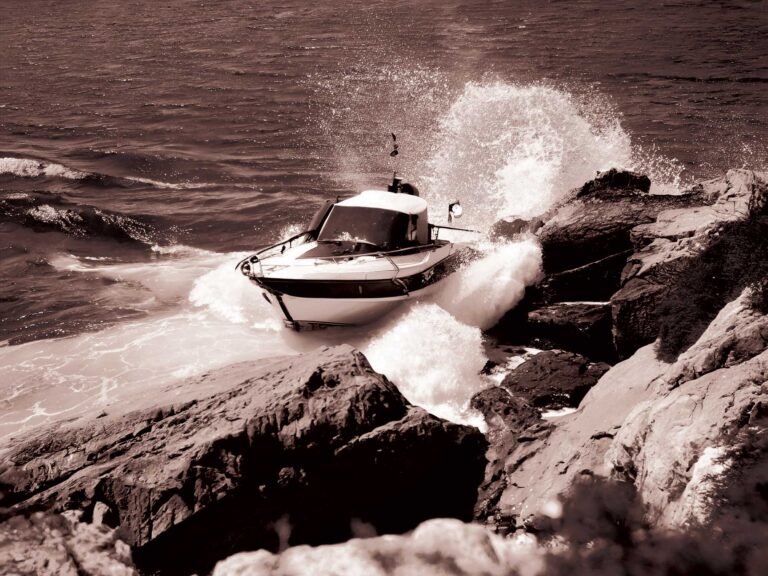
Boat Test: 2024 Nuova Jolly Prince 33 CC

ProTournament Elite Gen 3 Chargers

- Digital Edition
- Customer Service
- Privacy Policy
- Cruising World
- Sailing World
- Salt Water Sportsman
- Sport Fishing
- Wakeboarding
Many products featured on this site were editorially chosen. Boating may receive financial compensation for products purchased through this site.
Copyright © 2024 Boating Firecrown . All rights reserved. Reproduction in whole or in part without permission is prohibited.
Boating in a Thunderstorm: How to Stay Safe in a Storm
As a boater, you’re likely aware of how quickly the weather can change. And there’s a good chance that you enjoy being out on the water in several different conditions. But what about thunderstorms? How can you protect yourself and your loved ones from intense elements like heavy rain, lightning, and hail while boating? Is it best to race back to shore or take cover where you are? What can you bring with you to help you prepare? Below, we’ll walk through the answers to these questions and provide our best thunderstorm boating safety tips .
Understanding the Dangers of Thunderstorms While Boating
Being out on the water in the rain may be uncomfortable, but at the same time, it’s fairly safe. When that rain also includes lighting and thunder, however, things change. Water and lightening are a dangerous combination. It’s more likely for lightning to hit a boat on the water than a spot on land. And that strike can lead to electrocution, fire, and loss of electronics.

Along with lighting, heavy rains lower visibility, and strong winds create intense waves. These combined conditions make water one of the worst places to be during a thunderstorm.
Tip #1: Check the Weather Before Hitting the Water
Prevention is often the best plan of action when it comes to thunderstorm boating safety. If you see a chance of a storm when you’ll be on the water, we strongly recommend you reconsider your boating plans.
Use your discretion when planning your trip. Traditional weather apps may show an accurate prediction or leave you confused about whether or not you should go out.
Marine weather apps provide a deeper image into forecasts, often showing radar imagery, barometric pressure, wave cap size, and more. Each of these can be used to further determine the likelihood of thunderstorms or other types of severe weather taking place.
If you’re looking for a radio option, tune into the NOAA National Weather Service’s Marine WX Radio .
Read Next: Best Marine Weather Apps
Tip #2: Learn to Keep a “Watchful Weather Eye”
Weather isn’t always predictable. When you fully understand what the beginnings of a thunderstorm look like, you can prepare for the ones that aren’t forecasted.
Typical thunderstorm warning signs include :
- Large, puffy clouds that darken
- Winds that change direction quickly
- Sudden cooling in air temperature
- Lower atmospheric pressure
You should head to shore if you notice any combination of these signs. If you aren’t convinced that a storm will begin, you can stay near a landing while you watch the weather. If conditions improve, head back out. If they worsen, head to dry land.
Tip #3: Make an Onboard Thunderstorm Boating Safety Plan
Despite your best efforts, you may still end up on the water during a storm someday. Having a plan to protect yourself and your guests when stuck on the water is essential.
To start, consider your nearby shore options. If there’s a landing that’s safe to approach, head there as soon as you can. Getting off the water should always be your primary goal when thunderstorms arise.
If you must stay in your boat, the Coast Guard recommends that you:
- Ensure all riders are wearing their life jackets
- Seat guests on the floor in the center of the boat
- Turn on running lights
- Keep bilges empty
- Move toward shore at the minimum speed that allows forward motion
- Hit waves at a 45-degree angle
- Deploy anchor if stopping is necessary.
The National Weather Service also recommends that you:
- Stay inside the boat cabin if available
- Avoid touching metal and electrical devices
Consider creating a thunderstorm safety kit to keep on board, including:
- Life jackets for every rider
- On board first aid kit
- Radio (in case cell phones aren’t accessible)
- Fire extinguisher
- Visual and sound signaling devices
- Anchor with a line attached
- Oars or paddles
Once you’ve created your safety plan, ensure all passengers know the steps . You may even want to print a copy of your plan to keep in your glove compartment for a visual reminder. Even kids can be involved in preparation — teach them the signs of thunderstorms and the safest places to be so they’re prepared in the event of an emergency.
Read Next: How to Create a Float Plan
We don’t want the fear of thunderstorms to keep you from boating. Nonetheless, it’s important to be prepared for the worst weather conditions every time you hit the water. Always check the weather before you head out, watch the clouds, winds, and temperature throughout the day, and have a “thunderstorm boating safety plan” ready. By taking these few steps to prepare for bad weather, you and your guests will be better protected no matter what type of weather comes your way.
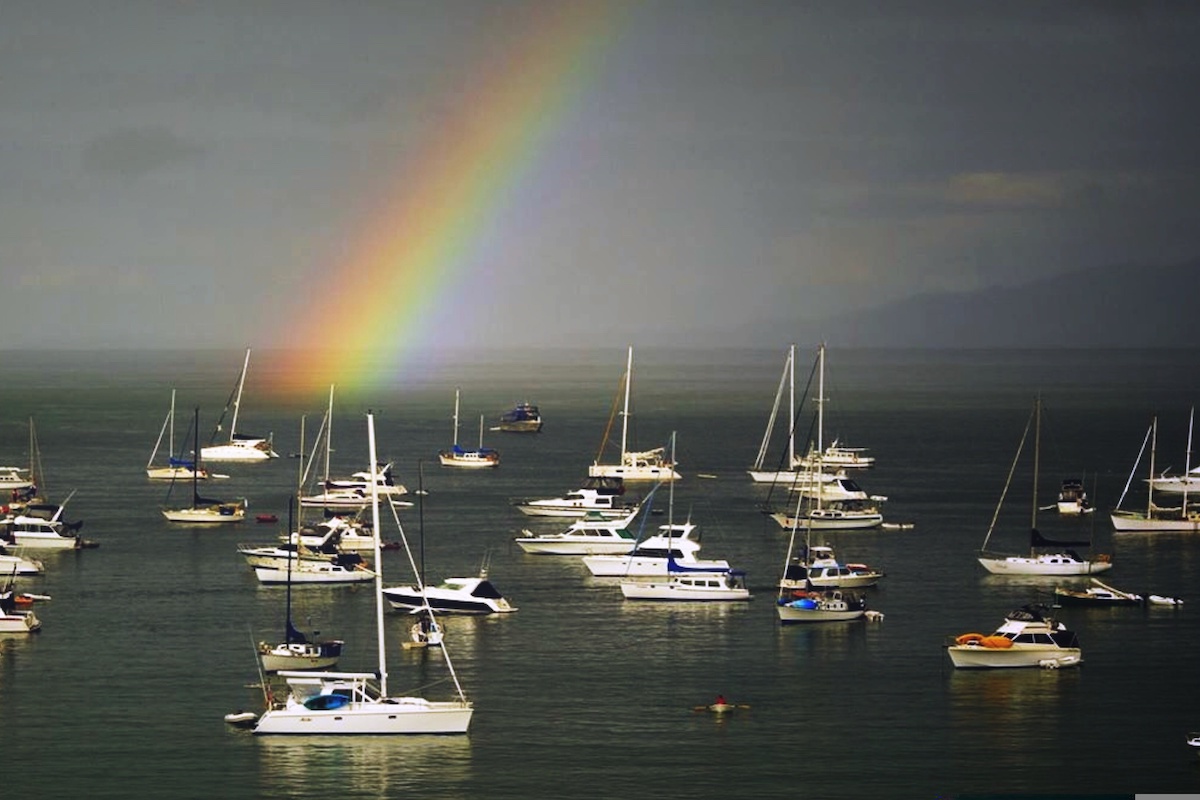
Join Our Newsletter!
Get community news, buying bargains, and how-to guides at your fingertips.

- Rivers and Lakes
- Severe Weather
- Fire Weather
- Long Range Forecasts
- Climate Prediction
- Space Weather
- Past Weather
- Heating/Cooling Days
- Monthly Temperatures
- Astronomical Data
- Beach Hazards
- Air Quality
- Safe Boating
- Rip Currents
- Thunderstorms
- Sun (Ultraviolet Radiation)
- Safety Campaigns
- Winter Weather
- Wireless Emergency Alerts
- Weather-Ready Nation
- Cooperative Observers
- Daily Briefing
- Damage/Fatality/Injury Statistics
- Forecast Models
- GIS Data Portal
- NOAA Weather Radio
- Publications
- SKYWARN Storm Spotters
- TsunamiReady
- Service Change Notices
- Be A Force of Nature
- NWS Education Home
- Pubs/Brochures/Booklets
- NWS Media Contacts
NWS All NOAA
- Organization
- Strategic Plan
- Commitment to Diversity
- For NWS Employees
- International
- National Centers
- Social Media
National Program
Safe Boating and Thunderstorms
US Dept of Commerce National Oceanic and Atmospheric Administration National Weather Service Safety 1325 East West Highway Silver Spring, MD 20910 Comments? Questions? Please Contact Us.
Is It Dangerous to Sail in a Thunderstorm?
About 10 years ago I found myself in a major thunderstorm in the middle of a lake with a 20 ft mast and nothing around. But is it dangerous? Let's find out.
Is it dangerous to sail in a thunderstorm? Sailing in a thunderstorm can be dangerous. However, lightning strikes are uncommon. The most dangerous factor in thunderstorms for sailors are unpredictable changes in wind direction and unexpected wind gusts. It is recommended to avoid sailing during storms in general, if at all possible.
There's a lot of myth and legend surrounding electrical storms and sailboat masts. In this article, I'll go over the facts for you. We'll also discuss a couple of solid and easy safety tips for when you find yourself amidst the turmoil.
At the end of the post I'll tell you a cool personal story about my own thunderstorm experience.

On this page:
Should you avoid sailing in thunderstorms, what happens when a sailboat gets hit by lightning, what to do in a lightning storm on a boat, how to prevent impacts on your boat, what to do if you get hit, my experience with lightning.
The real question, of course, is whether or not you can set sail when thunderstorms have been predicted. The simple answer is: yes, but if you can avoid it, I would.
The more real answer is: it's up to you. But again, I would advise being cautious.
The chances of being hit aren't as great as most people believe (I'll explain below). I've developed a formula that represents the way most people feel about the combination of lightning and sailboats:
Sailboat mast + lightning = A.D. wherein A.D. stands for assured destruction.
All kidding aside, the biggest danger isn't the lightning, but the unpredictable wind that goes with it.
Most thunderstorms combine with very sudden changes in wind direction and wind speed. In some cases, the wind constantly changes direction 180 degrees. It can cause very powerful gybes, destroying the mainsail or even damaging the mast. And of course, you could get caught off guard, resulting in injury or a man overboard situation.
Do Sailboats Actually Get Hit by Lightning?
Sailboat masts look like they must get hit all the time when in the middle of a lightning storm. But it's not at all obvious that they do. There are a lot of examples where sailors in the middle of a large electrical storm aren't hit at all. At the same time, the water around them gets hit dozens of times. I have experienced the exact same thing myself.
Statistically, you have about a 0.4% chance of being hit when you're on a monohull sailboat. The larger the boat, the more likely you'll attract lightning.
That doesn't sound like a lot, but it's still every 4 in 1000 boats. There are also a lot more startled sailors than lottery winners out there. Still, it's less common than I thought.
Okay, so the lighting itself isn't the major issue. However, IF you get hit, you will experience some real problems, and it can be potentially very dangerous.
If you absolutely need to move your boat, you definitely can. But please make sure you have some experience with heavy weather sailing. Also, have some procedures in place for when the worst case happens.
But personally, if I don't have to go anywhere, I probably wouldn't bother risking it.
Below I'll go into more detail on what happens when a sailboat actually gets hit by lightning, and what you can do to avoid it.
You don't have to panic when there's some lightning around. Impact doesn't usually cause fires, although it can happen.
I want to say right off the bat that every impact is different. The strength of a lightning impact differs every time. But in most cases, the same thing roughly happens. I've heard from one sailor that got struck once that the following happens:
- your rigging may be fried, sometimes destroying it completely
- it will take out all your electronic equipment
- it will take out (part of) your wiring, which may cause a fire
- your batteries will probably explode
- an impact may blow out thru-hull fittings and damage the hull
- there are reports of extensive hull damage
When a lightning strike misses you, but the impact is close by and powerful enough, your electronics could still be taken out.
A full-blown impact may take down your mast, although this is very uncommon. But changes are your rigging gets damaged to the point you can't use your sails anymore. (Which you probably couldn't do anyway because of the wind).
Your electronic equipment will be damaged in some way or another by the peak voltage. Even if you switch them off. Your wiring may be damaged as well, and can even start a fire (although this is uncommon).
Your battery may partially explode. This is one of the more risky things that is actually likely to happen. Exploding batteries are pretty dangerous, and could start a fire.
An impact can also damage your hull and sink your boat by blowing out thru-hull fittings or creating cracks.
Turn on the engine - in case your batteries are fried and you can't use your sails. You should turn your engine on to make sure you keep full control over your vessel, even when you lose the mast and batteries. If your batteries get fried, you won't be able to start your engine and are without power. If there are heavy winds and you can't use your sails, you are completely helpless. You will be unable to steer the bow into the wind to avoid capsizing.
Sails down - In case of heavy winds or unpredictable changes, reef down your sails immediately. Don't wait for the heavy weather to really kick in. Acting quickly will save you A LOT of trouble.
Don't hold anything that's made from metal - Once the ship is secured, make sure you don't touch any metal parts for the duration of the storm. This reduces the chance of you getting fried on impact.
Get the fire extinguisher - Fires are uncommon, but make sure you have it at hand.
Stay down below as much as possible - If you're not needed above deck, or if you've decided to sit it out, stay below deck. This will be the safest place in case there's an impact. The hull will act as a sort of Faraday cage (not entirely, but close enough).
Unplug all electronics - Now that you've secured power and control over the boat and yourself, it's time to worry about your gear. Unplug all electronics - I mean physically pull the wiring out of them.
Put small electronics in the oven - I think this is just superstition, but some people say you should put all loose electronics inside the oven to protect them. You probably could give it a try, there's not really anything better to do.
The DIY method: create an easy path for the lightning by taking a piece of anchor chain. Wrap it around the mast, a cap shroud, and then take the end and place it in the water. This creates a kind of earth return, which is said to prevent lightning strikes.
The PRO method: You can install an electrical charge dissipator in the mast head. It looks like a brush. It will avoid the impact to be drawn down by the mast. If you're interested, I found this one on Amazon with great reviews and for a good price.
Quick tip: One of the most likely (and worst) things that can happen after impact, is finding yourself without a means to navigate. Lightning can easily destroy your GPS, and even flip your compass around.
You may consider getting a small backup GPS receiver that runs on batteries. If Store it separately and away from any metal parts. If you're interested, I found this one by Garmin on Amazon with good reviews and for a great price .
You can use it to store waypoints, like the harbor entry and shallows. In my opinion the best backup.
Let's say you're just unlucky in life - you get hit. What now? How to act?
- immediately check for any fires
- and put them out ASAP
- if you have engine power, try and motor to safer waters
- make sure you retain control over the vessel unless it endangers you
- make sure the bilge is dry and there are no holes in the hull
- if you or a crew member is hit, they could suffer from cardiac arrest - If so, reanimate immediately.
A friend and I were sailing the IJsselmeer, which used to be the inland sea of The Netherlands. We were almost one week in. It started out as a quiet night. We were at anchor at a peaceful, small lake next to the IJsselmeer. Halfway through our bottle of wine, the boat started rotating around the anchor.
We climbed out of the cabin. We were spinning around at a high speed, and everywhere around us, flashes of lightning came down crashing from the sky. We were the only sailboat on the lake at that time, and it was frightening, to be honest (I was still young). We phoned up a friend, hysterically, and he checked the weather forecast for us. I remember screaming at him, fearing for my life, 'what way does the storm move?!'.
The storm was here to stay for several more hours. We decided to head for safe harbor in the middle of the night. We had no lights. I was the helmsman, my friend stood on the bow, trying to find a safe path in the shallow waters. We navigated by sight best we could. He shouted back directions at me, trying to win the argument from the heavy winds.
In the end, we weren't hit and everything turned out just fine. Man, it was an adventure.
I hope this article will be helpful if you find yourself in such a situation. At the time, I'd really wish there was an article like this out there - luckily we had a helpful and reliable friend on standby.

Jurriaan Gerretsen
How serious are you in publishing articles like this with a serious mistake.
It states: “Statistically, you have about a 0.4% chance of being hit”. Which is put into context: “That doesn’t sound like a lot, but it’s still every 4 in 100 boats.” In fact 0.4% is 4 in a thousand and not 4 in a hundred. …..
Shawn Buckles
Hi Jurriaan, Thanks for pointing out the error. I have corrected it. Must have mistyped. As much as I try to catch all errors, sometimes one slips through.
Thanks again, Shawn
Philip Mayo
Thank you Shawn! Very interesting article. Something I had never thought about but it is a little scary to think about. That’s a crazy story story about when you and your freind were caught in a thunderstorm when you were younger. I think I would’ve been freaked out too! Where did you wind up tying up the boat after moving it? Also, did you use the motor (if you had one) to move the boat or the sails?
Great article Shawn. Thanks for the tips
Leave a comment
Own your first boat within a year on any budget.
A sailboat doesn't have to be expensive if you know what you're doing. If you want to learn how to make your sailing dream reality within a year, leave your email and I'll send you free updates . I don't like spam - I will only send helpful content.
Ready to Own Your First Boat?
Just tell us the best email address to send your tips to:
Yachting Monthly
- Digital edition

Sailing in lightning: how to keep your yacht safe
- In partnership with Katy Stickland
- July 22, 2022
How much of a concern is a lightning strike to a yacht and what can we do about it? Nigel Calder looks at what makes a full ‘belt and braces’ lightning protection system

Storm clouds gather at Cowes, but what lightning protection system, if any, does your boat have for anchoring or sailing in lightning? Credit: Patrick Eden/Alamy Stock Photo
Most sailors worry about sailing in lightning to some extent, writes Nigel Calder .
After all, going around with a tall metal pole on a flat sea when storm clouds threaten doesn’t seem like the best idea to most of us.
In reality, thunder storms need plenty of energy, driven by the sun, and are much less frequent in northern Europe than in the tropics.
However, high currents passing through resistive conductors generate heat.
Small diameter conductors melt; wooden masts explode; and air gaps that are bridged by an arc start fires.

Sailing in lightning: Lightning is 10 times more likely over land than sea, as the land heats up more than water, providing the stronger convection currents needed to create a charge. Credit: BAE Inc/Alamy Stock Photo
On boats, radio antennas may be vaporised, and metal thru-hulls blown out of the hull, or the surrounding fiberglass melted, with areas of gelcoat blown off.
Wherever you sail, lightning needs to be taken seriously.
Understanding how lightning works, will help you evaluate the risks and make an informed decision about the level of protection you want on your boat and what precautions to take.
Most lightning is what’s called negative lightning, between the lower levels of clouds and the earth. Intermittent pre-discharges occur, ionising the air.
Whereas air is normally a poor electrical conductor, ionised air is an excellent conductor.
These pre-discharges (stepped leaders) are countered by a so-called attachment spark (streamer), which emanates from pointed objects (towers, masts, or lightning rods) that stand out from their surroundings due to their height.

Summer is the season for lightning storms in the UK. Here, one finds early at Instow, Devon. Credit: Terry Matthews/Alamy Stock Photo
This process continues until an attachment spark connects with a stepped leader, creating a lightning channel of ionised air molecules from the cloud to ground.
The main discharge, typically a series of discharges, now takes place through the lightning channel.
Negative lightning bolts are 1 to 2km (0.6 to 1.2 miles) long and have an average current of 20,000A.
Positive lightning bolts are much rarer and they can have currents of up to 300,000A.
Preventing damage when sailing in lightning
A lightning protection system (LPS) is designed to divert lightning energy to ground (in this case the sea), in such a way that no damage occurs to the boat or to people.
Ideally, this also includes protecting a boat’s electrical and electronic systems, but marine electronics are sensitive and this level of protection is hard to achieve.
Lightning protection systems have two key components: First, a mechanism to provide a path with as little resistance as possible that conducts a lightning strike to the water.
This is established with a substantial conductor from an air-terminal to the water.

Components of an external and internal lightning protection system. Credit: Maxine Heath
This part of the LPS is sometimes called external lightning protection.
Second, a mechanism to prevent the development of high voltages on, and voltage differences between, conductive objects on the boat.
This is achieved by connecting all major metal objects on and below deck to the water by an equipotential bonding system.
Without this bonding system high enough voltage differences can arise on a boat to develop dangerous side flashes.
The bonding system can be thought of as internal lightning protection.
Rolling ball concept
Lightning standards, which apply ashore and afloat, define five lightning protection ‘classes’, ranging from Class V (no protection) to Class I.
There are two core parameters: the maximum current the system must be able to withstand, which determines the sizing of various components in the system, and the arrangement and number of the air terminals, aka lightning rods.
Let’s look at the arrangement of the air terminals first. It is best explained by the rolling ball concept.
A lightning strike is initiated by the stepped leaders and attachment sparks connecting to form the lightning channel.
The distance between the stepped leader and the attachment sparks is known as the breakdown distance or striking distance.
If we imagine a ball with a radius equal to the striking distance, and we roll this ball around an object to be protected, the upper points of contact define the possible lightning impact points that need to be protected by air terminals.

Lightning protection theories and classifications rely on a ‘rolling ball’ concept to define requirements, areas of risk and protected areas. Credit: Maxine Heath
The air terminal will theoretically provide a zone of protection from the point at which the terminal connects with the circumference of the rolling ball down to the point at which that circumference touches the water.
The shorter the striking distance, the less the radius of the rolling ball and the smaller the area within the protection zone defined by the circumference of the rolling ball.
The smaller the protection zone, the more air terminals we need. So, we use the shortest striking distance to determine the minimum number and location of air terminals.
Class I protection assumes a rolling ball radius of 20m; Class II assumes a rolling ball radius of 30m.
Continues below…

Lightning: why we were struck
A personal investigation into how and why a catamaran was hit by lightning

‘Lightning destroyed the boat’s electronics’
Paul Tinley recounts a truly shocking lightning experience aboard his Beneteau 393 Blue Mistress and the subsequent insurance claim

Expert advice: boating emergency
A boating emergency is the sort of thing that everyone taking to the water should be prepared for even if,…

How batteries can explode – and how to avoid it
Marine electrical expert Nigel Calder explains why boat batteries emit hydrogen and how to minimise the dangers
Boat building standards are based on a striking distance/rolling ball radius of 30m (Class II).
For masts up to 30m above the waterline, the circumference of the ball from the point at which it contacts the top of the mast down to the water will define the zone of protection.
For masts higher than 30m above the waterline, the ball will contact the mast at 30m and this will define the limit of the zone of protection.
If Class I protection is wanted, the radius of the ball is reduced to 20m, which significantly reduces the zone of protection and, on many larger recreational boats, may theoretically necessitate more than one air terminal.
Protection classes
With most single-masted monohull yachts, an air terminal at the top of the mast is sufficient to protect the entire boat to Class I standards.
The circumference of the rolling ball from the tip of the mast down to the surface of the water does not intercept any part of the hull or rig.
However, someone standing on the fore or aft deck might have the upper part of their body contact the rolling ball, which tells us this is no place to be in a lightning storm.
Some boats have relatively high equipment or platforms over and behind the cockpit.

Protection classes to protect your boat while anchored or sailing in lightning
These fittings and structures may or may not be outside the circumference of the rolling ball.
Once again, this tells us to avoid contact with these structures during a lightning storm.
Ketch, yawl, and schooner rigged boats generally require air terminals on all masts, except when the mizzen is significantly shorter than the main mast.
The external LPS
The external LPS consists of the air terminal, a down conductor, and an earthing system – a lightning grounding terminal.
The down conductor is also known as a primary lightning protection conductor.
All components must be sized to carry the highest lightning peak current corresponding to the protection class chosen.
In particular, the material and cross-sectional area of the air terminal and down conductor must be such that the lightning current does not cause excessive heating.
The air terminal needs to extend a minimum of 150mm above the mast to which it is attached.

A graph depicting NASA’s record of yearly global lightning events. The Congo once recorded more than 450 strikes per km2
It can be a minimum 10mm diameter copper rod, or 13mm diameter aluminum solid rod.
It should have a rounded, rather than a pointed, top end.
VHF antennas are commonly destroyed in a lightning strike.
If an antenna is hit and is not protected by a lightning arrestor at its base, the lightning may enter the boat via the antenna’s coax cable.
A lightning arrestor is inserted in the line between the coax cable and the base of the antenna.
It has a substantial connection to the boat’s grounding system, which, on an aluminum mast, is created by its connection to the mast.
In normal circumstances, the lightning arrestor is nonconductive to ground.
When hit by very high voltages it shorts to ground, in theory causing a lightning strike to bypass the coax – although the effectiveness of such devices is a matter of some dispute.
Down conductors
A down conductor is the electrically conductive connection between an air terminal and the grounding terminal.
For many years, this conductor was required to have a resistance no more than that of a 16mm² copper conductor, but following further research, the down conductor is now required to have a resistance not greater than that of a 20mm² copper conductor.
For Class I protection, 25mm² is needed. This is to minimise heating effects.
Let’s say instead we use a copper conductor with a cross-sectional area of 16mm² and it is hit by a lightning strike with a peak current corresponding to Protection Class IV.

Sailing in lightning: This catamaran relies upon cabling to ground from the shrouds but stainless steel wire is not a good enough conductor. Credit: Wietze van der Laan
The conductor will experience a temperature increase of 56°C. A 16mm² conductor made of stainless steel (for example, rigging ) will reach well over 1,000°C and melt or evaporate.
Shrouds and stays on sailboats should be connected into a LPS only to prevent side flashes.
The cross-sectional area of the metal in aluminum masts on even small sailboats is such that it provides a low enough resistance path to be the down conductor.
Whether deck- or keel-mounted, the mast will require a low resistance path, equivalent to a 25mm² copper conductor, from the base of the mast to the grounding terminal.
Grounding terminal
Metal hulled boats can use the hull as the grounding terminal. All other boats need an adequate mass of underwater metal.
In salt water this needs a minimum area of 0.1m². In fresh water, European standards call for the grounding terminal to be up to 0.25m².
A grounding terminal must be submerged under all operating conditions.
An external lead or iron keel on monohull sailing boats can serve as a grounding terminal.

This owner of this Florida-based yacht decided to keep the keel out of the equation when is came to a grounding plate. High electrical currents don’t like sharp corners, so a grounding plate directly beneath the mast makes for an easier route to ground. Credit: Malcolm Morgan
In the absence of a keel , the cumulative surface area of various underwater components – propellers, metal thru-hulls, rudders – is often more than sufficient to meet the area requirements for a grounding terminal.
However, these can only be considered adequate if they are situated below the air terminal and down conductor and individually have the requisite surface area.
Metal through-hulls do not meet this requirement.
If underwater hardware, such as a keel, is adequate to be used as the grounding terminal, the interconnecting conductor is part of the primary down conductor system and needs to be sized accordingly at 25mm².
Propellers and radio ground plates
Regardless of its size, a propeller is not suitable as a grounding terminal for two reasons.
First, it is very difficult to make the necessary low-resistance electrical connection to the propeller shaft, and second, the primary conductor now runs horizontally through the boat.
The risk of side flashes within the boat, and through the hull to the water is increased.

Sailing in lightning: GRP hull, fairing filler and iron keel will have carried different voltages during the strike – hence this damage
An engine should never be included in the main (primary) conducting path to a grounding terminal.
On modern engines, sensitive electronic controls will be destroyed in a lightning strike, and on all engines, oil in bearings and between gears will create resistance and therefore considerable heat which is likely to result in internal damage.
However, as it is a large conductive object, the engine should be connected to the internal lightning protection system.
Internal lightning protection
On its way to ground, lightning causes considerable voltage differences in adjacent objects – up to hundreds of thousands of volts.
This applies to boats with a functioning external lightning protection system but without internal protection.
Although the lightning has been given a path to ground along which it will cause as little damage as possible, dangerous voltages can be generated elsewhere, resulting in arcing and side flashes, threatening the boat and crew, and destroying electronic equipment.
We prevent these damaging voltage differences from arising by connecting all substantial metal objects on the boat to a common grounding point.

One of the holy grails of marine photography – a direct lightning strike on a yacht’s mast. Credit: Apex
The grounding terminal is also wired to the common grounding point.
By tying all these circuits and objects together we hold them at a common voltage, preventing the build-up of voltage differences between them.
All conductive surfaces that might be touched at the same time, such as a backstay and a steering wheel, need to be held to the same voltage.
If the voltages are the same, there will be no arcing and no side flashes.
The bonding conductors in this internal LPS need to be stranded copper with a minimum size of 16mm².
Note that there can be bonding of the same object for corrosion prevention, lightning protection, and sometimes DC grounding.
We do not need three separate conductors.
Electronic Device Protection
With lightning protection systems, we need to distinguish electric circuit and people protection from device protection.
Even with an internal LPS, high induced voltages may occur on ungrounded conductors (such as DC positive) which will destroy any attached electronics.
A mechanism is needed to short high transient voltages to ground.
This is done with surge protection devices (SPD), also known as transient voltage surge suppressors (TVSS) or lightning arrestors.

Marine-specific SPDs are few in number and domestic models are not suitable for boats
In normal circumstances these devices are non-conductive, but if a specified voltage – the clamping voltage – is exceeded they divert the spike to ground.
There are levels of protection defined in various standards depending on the voltages and currents that can be handled, the speed with which this occurs, and other factors.
This is a highly technical subject for which it is advisable to seek professional support.
Most SPDs are designed for AC circuits.
When it comes to DC circuits there are far fewer choices available to boat owners although there are an increasing number for solar installations that may be appropriate.
There is no such thing as a lightning-proof boat, only a lightning-protected boat, and for this there needs to be a properly installed LPS.

Nigel Calder is a lifelong sailor and author of Boatowner’s Mechanical and Electrical Manual. He is involved in setting standards for leisure boats in the USA
Even so, in a major strike the forces involved are so colossal that no practical measures can be guaranteed to protect sensitive electronic equipment.
For this, protection can be provided with specialised surge protection devices (SPDs).
The chances of a direct lightning strike on a yacht are very small, and the further we are north or south of the equator, the smaller this chance becomes.
It’s likely your chances of receiving a direct lightning strike are very much higher on a golf course than at sea.
‘Bottle brush’-type lightning dissipators are claimed by sellers to make a boat invisible to lightning by bleeding off static electrical charge as it builds up.
The theory rests upon the concept that charged electrons from the surface of the earth can be made to congregate on a metal point, where the physical constraints caused by the geometry of the point will result in electrons being pushed off into the surrounding atmosphere via a ‘lightning dissipator’ that has not just one point, but many points.
It is worth noting that the concept has met with a storm of derision from many leading academics who have argued that the magnitude of the charge that can be dissipated by such a device is insignificant compared to that of both a cloud and individual lightning strikes.
It seems that the viable choices for lightning protection remain the LPS detailed above, your boatbuilder’s chosen system (if any), or taking one’s chances with nothing and the (reasonable) confidence that it’s possible to sail many times round the world with no protection and suffer no direct strikes.
Whichever way you go, it pays to stay off the golf course!
Enjoyed reading Sailing in lightning: how to keep your yacht safe?
A subscription to Yachting Monthly magazine costs around 40% less than the cover price .
Print and digital editions are available through Magazines Direct – where you can also find the latest deals .
YM is packed with information to help you get the most from your time on the water.
- Take your seamanship to the next level with tips, advice and skills from our experts
- Impartial in-depth reviews of the latest yachts and equipment
- Cruising guides to help you reach those dream destinations
Follow us on Facebook , Twitter and Instagram.

Sailing Your Sailboat In A Storm: The Ultimate Guide
No one in their right mind chooses to direct their sailboat into a storm, and you shouldn’t either!
There’s a reason that so many songs about sailing and sailing quotes are based around storms at sea – they’re dramatic and terrifying and awe-inspiring. So inspiring that people feel the need to write about them.
In our 4 years of full-time sailing, we have only been caught out a few times. It’s never fun when you are but each time it happens you build trust in yourself and how your sailboat handles storm conditions.
The good news is that you can prepare yourself and your sailboat for storms without having to head out into one. There are several steps you can go through to ensure that if and when the time comes, you’re ready.
Sailing in stormy conditions can be a daunting experience for even the most experienced sailors. However, with the right knowledge, preparation, and mindset, you can navigate through the raging tempest and emerge safely on the other side.
In this ultimate guide, we will equip you with the essential skills and advice to sail your sailboat confidently in stormy weather.
Whether you’re an experienced sailor looking to refine your storm tactics or a beginner eager to explore the world of sailing, this guide will provide you with the tools to face the fury of nature head-on.

As an Amazon Associate, we earn from qualifying purchases. We also earn from other affiliate programs. This means we may receive a small commission on products purchased through our links at no extra cost to you.
Table of Contents
Pre-storm sailing checks, storm sails, your sailboat in big waves.
- Post Storm Assessment
Conclusion: Your Sailboat In A Storm

The key to sailing in a storm is being prepared. We knew this, and yet the first time we got caught in big weather we weren’t prepared at all, and we felt really stupid for it.
Don’t be us!
You should be prepared for bad weather every single time you leave the safety of the harbour. You never know when the weather will change on you and you should always know exactly what you’ll do when that happens.
Here are a few things you can do while the weather is calm to help you prepare for the worst case scenario.
The Science of Storms
Understanding the dynamics of storms, including their formation, movement, and intensification, will enable you to make informed decisions before you even leave the anchorage.
You don’t need to become a weather expert, but you should learn how to read the weather using various sailing forecasts, and be aware of all the different tools available to you.
Another key skill is knowing weather patterns in the specific area you’re sailing in. Ask local fishermen and sailors how to spot bad weather and ‘read the skies’ as well as the forecasts.
In Greece, for example, you can predict the onset of the Meltemi winds by watching for dew on the deck. You can also learn a lot from watching the fishing boats. If they suddenly flock to port it’s a sure sign there will be bad weather on the way!
Preparing Your Sailboat
Properly equipping your sailboat before setting sail is crucial for handling a storm.
We always do pre-sail checks before setting off on a passage, but after days of sailing in calm weather, it’s easy to get complacent. Especially when there’s a favourable forecast.
This was our biggest mistake in one of the big storms we got stuck in. We usually stow our paddleboards, but we were forecast great weather and decided to tie them down on deck instead. We lost one over the side after a huge wave ripped it out of the lines and washed it overboard. Luckily it wasn’t anything more important.
You need to check for things like working bilge pumps, check your marine batteries and that you have a healthy running engine, do regular rigging inspections, check your sailboat mast , and check the quality of your lines and sails. These sorts of things should all be part of your going-to-sea checklist and are easy to keep on top of because they’re so vital.
The things that are easier to forget, but just as important, are things like ensuring hatches and portholes are properly closed and fastened, cupboards are all latched, and everything is stowed away safely.
I read a really interesting account of a couple who got caught in a severe storm. When a wave hit their top-loading fridge flew open spilling the contents everywhere. Eggs all over the floor made it impossible to move around below deck safely, and serious injuries occurred.
Think of everything, every time! And make it part of your daily routine.
Safety Equipment

Alongside your regular boat checks should be regular safety equipment checks.
To begin with, you should make sure you have all the safety equipment onboard before heading out to sea. This includes things like lifejackets , tethers, jackstays, liferafts, EPIRBS, grab bags, flares, etc.
You should make sure you inspect safety equipment regularly. Keep on top of things like recharging lifejackets and getting liferafts inspected regularly. Make sure your life sling is free to run. Make sure you have a sailing knife somewhere handy.
You should also know how to use your safety equipment and regularly practice your man overboard drills.
S eamanship Techniques
Once you find yourself sailing through a storm, it’s vital to know how to handle your sailboat effectively. This requires knowing your boat and how it handles best and will take some practice.
You can practice in calm weather, you don’t need to be in the middle of a storm to figure out certain techniques (and you shouldn’t be!) Make storm tactic practice a regular part of your sailing routine, and make sure the crew is aware of what you’ll do if heavy weather creeps up on you.
We’ll take a more in-depth look at different storm tactics below!
Crew Safety and Communication
In a storm, the safety of you and your crew is paramount. Before you head out to sea you should always brief your crew so they know all the major systems onboard. Imagine you got knocked unconscious – what would they need to know to get you and the boat to safety?
They should all have appropriate safety equipment and know your rules on using it. It’s important they trust and respect you as the skipper, because if things get tough out there you’ll want them to follow your orders.
You need to make sure they are comfortable with the way you run your ship. It’s easy to bark orders that are difficult to understand when you’re under pressure, so it’s up to you as captain to practice good communication skills onboard.
Mental Preparedness
Sailing in stormy conditions can be mentally and physically demanding. Often the sailboat is fine in a storm, but the people onboard fall apart long before the boat will.
Storms bring rough seas, and rough seas bring seasickness, anxiety, fear, and panic. You need to know what you’ll do if one or more of your crew becomes able to play their role.
When we got caught in big seas on a passage from Croatia to Greece Adam was flat on his back with seasickness for most of the journey. Luckily I knew the boat well enough to single-hand for large chunks of time, and he knew how to handle his seasickness well enough that he could take short watches while I slept.
Being prepared for this mentally by knowing the boat and our own capabilities played a huge role in the fact we managed to get the boat to safety.
Storm Tactics

Make sure you carefully think through your storm tactics and share them with your crew before you head out to sea. Here are a few storm tactics that might be worth practicing on calmer sails, so you know exactly what to do when bad weather hits.
This seems like a daft one to put first, but hypothermia will kill you much quicker than a storm. Luckily when we got really caught out it was summer and the temperatures were high, but even so we very quickly realised how stupid we were for heading out without decent sailing foulies.
The night was a very cold, very wet one. We survived it, but we vowed we would have all the proper kit before ever heading out to sea again.
As a minimum, make sure you have easily accessible layers (you do not want to be rummaging around below in a bad sea state), a decent sailing jacket and waterproof trousers, non-skid shoes, or even better, sailing boots .
For colder climates, it’s wise to consider a sailing drysuit .
Before the storm picks up make sure you’re kitted out. One rogue wave that sneaks overboard before you have your waterproof layers on could be a real killer.
One of the first steps to take in any sailboat when the weather picks up is to reef the sails . It’s unlikely that a storm will go from 0 knots to 60 (though obviously this can happen!) so as the wind builds, so should the reefs in your sails.
Reefing is simply making the sail area smaller. Different boats will have different points at which they need to reef, and your sail set up will be different too. Offshore sailors often have three reefing points in their sails so they can make them as small as possible.
Reefing the mainsail is hardest. You might need to go up to the mast to drop the sail a portion of the way down before trimming the sail again.
Foresails like jibs are often on furlers, and can be furled away as small as you like. You’ll just want to be careful the sails are balanced so you don’t have to work too hard on the helm.
Once your sailboat is fully reefed and still struggling in the wind speeds you’re getting, it’s time to consider putting up your storm sail.
Your storm sail is a vital piece of safety gear on board.
Storm sails are specialized sails designed to be used in extreme weather conditions, particularly during storms or heavy winds. They are smaller, stronger, and more heavily reinforced than regular sails, allowing a sailboat to maintain control and reduce the risk of damage or capsize in challenging weather.
Here are the main types of storm sails commonly used:
- Storm Jib: The storm jib is a small headsail that is hanked or attached to the forestay closer to the deck. It is typically made of heavy-duty fabric and has a high-cut clew (lower corner) to prevent interference with the deck or waves. The storm jib is used when the wind becomes too strong for the regular headsail, providing better control and stability.
- Storm Trisail: A storm trisail is a triangular sail that is hoisted on a separate mast track, usually on the aft side of the mast. It is set independently from the mainsail and provides an alternative to using the main in extreme conditions. The storm trisail is typically made of heavy-duty fabric and has a shorter luff (leading edge) than the regular mainsail.
- Storm Staysail: A storm staysail is a small sail set between the mast and the forestay. It is usually hanked or attached to a removable stay or a dedicated inner forestay. The storm staysail provides additional stability and control when conditions are too severe for other sails. It is typically made of heavy-duty fabric and has a high-cut clew to avoid interference.
Storm sails are designed to handle high winds and heavy seas, allowing a sailboat to maintain some degree of maneuverability and control.
They are usually constructed from stronger and more durable materials, such as heavy Dacron or woven synthetic fibers, and often feature reinforced stitching and webbing to withstand the increased loads and forces experienced in stormy conditions.
It’s important to note that deploying storm sails should be done in advance of extreme weather and in accordance with the manufacturer’s recommendations. P
roper training and experience are crucial for effectively using storm sails, as they require careful sail handling and adjustments to maintain the boat’s balance and stability.

Heaving to in a sailboat is a valuable technique used to effectively manage challenging weather conditions, especially in a storm. It allows you to temporarily pause your boat’s forward progress, stabilize it, and create a safe and controlled environment.
It’s basically putting the brakes on your sailboat.
Here’s a step-by-step guide on how to heave to in a sailboat, but bear in mind that every sailboat is slightly different so you will need to play around a bit with your individual boat in calm weather to work out what works best for your boat and crew.
- Assess the conditions: Determine if heaving to is the appropriate strategy for the current situation. Heaving to is most effective in moderate to heavy winds and moderate seas. If conditions are extreme or dangerous, it may be safer to consider alternative tactics or seek shelter.
- Prepare the boat: Before executing the maneuver, prepare your sailboat by reefing the sails. Reduce the sail area to a level that provides sufficient control while minimizing the boat’s forward motion. Typically, this involves reefing the mainsail by lowering it partially or completely and adjusting the headsail accordingly.
- Decide on the tack: Choose the tack to heave to based on factors such as wind direction, sea state, and the boat’s handling characteristics. The tack selection can vary depending on the boat’s design and personal preference. In general, choose the tack that allows the boat to face into the wind with the mainsail backed.
- Head up into the wind: Turn the boat into the wind by steering toward the chosen tack. This maneuver will cause the boat’s forward momentum to decrease as it approaches a position directly facing into the wind.
- Backwind the headsail: Once the boat is pointing into the wind, backwind the headsail to help balance the forces acting on the boat. To do this, ease the headsail sheet, allowing it to fill on the opposite side of the boat from its normal position. This action will counteract the forward drive and assist in keeping the boat stationary or with minimal drift.
- Adjust the rudder: Set the rudder position to maintain balance and control. Depending on the boat’s design and behavior, you may need to experiment with the rudder angle to achieve the desired heaving to effect. In some cases, you may need to lock the helm in position or use a tiller-tamer device to maintain the rudder angle.
- Fine-tune and monitor: Once in the hove-to position, make any necessary adjustments to the sails, rudder, and other controls to achieve a stable and comfortable balance. Monitor the boat’s behavior, making sure it only drifts very slowly.
The boat won’t actually stop. It will typically lie about 60 degrees off the wind, sailing at around 1 knot, and sliding to leeward.
The motion will be much less than under sail, and dramatically more stable and pleasant than dropping all sails and lying ahull. You will also be using up less sea room than if you run before the storm at great speed.
Heaving to provides a stable platform in which you can wait out a storm, take a break, or perform necessary tasks while minimizing the boat’s motion and maintaining control.
It’s important to note that the specific technique may vary depending on your sailboat’s design and the prevailing conditions, so always consult your sailboat’s manual or seek guidance from experienced sailors for your particular boat type.
Drogue Or Sea Anchor
A drogue or sea anchor is a device used in boating and sailing to provide stability and control in heavy weather or when facing strong currents, winds or waves. Its primary purpose is to reduce a boat’s drift and help maintain a more stable position relative to wind and waves.
Here are the key points and benefits of using a drogue or sea anchor:
- Reducing drift: In stormy conditions, strong winds and currents can cause a boat to drift uncontrollably, potentially leading to loss of steering and stability. By deploying a drogue or sea anchor, the device creates drag in the water, effectively slowing down the boat’s drift and providing a steadier position.
- Enhancing stability: When a drogue or sea anchor is deployed from the stern of a boat, it helps to stabilize the vessel by reducing yawing (side-to-side motion) and rolling caused by wind and waves. This stability can be crucial for crew safety, preventing excessive motion and reducing the risk of capsizing or broaching.
- Improving safety: In extreme conditions, using a drogue or sea anchor can significantly improve overall safety on board. It reduces the risk of broaching (where the boat is turned broadside to the waves) and pitch-poling (when the boat’s bow is driven under a breaking wave), both of which can lead to dangerous situations. The device helps to create a controlled environment, minimizing the chances of damage, injuries, or loss of control.
We have never needed to use our drogue, but we have been close even in the Mediterranean, so it’s good to be prepared.
If you don’t have one but you find yourself in storm conditions where you need one, then doing something like hanging lines from the stern of the boat can actually make quite a big difference,

Sailing in big waves is not for the faint of heart, but if you trust your boat and your captain it can be an exciting experience!
One of the hardest things about sailing in big waves is steering. Your most experienced helmsman should be on the helm when the weather gets rough. Reading the waves is vital.
One of the key things to remember is that you must not sail on a reach across tall, breaking waves. If they hit you at the right angle and at the right time there is every possibility they could roll the boat. It’s a good idea to be familiar with capsize ratio and what this could mean for you.
If you have to sail upwind (we would do everything possible to avoid this!) then aim towards the parts of the wave that aren’t breaking. There is huge force in breaking waves and you want to avoid them if you can. Or you might lose your paddleboard!
Tack in smooth water if possible, and try to keep the speed up as you’re going over the waves so you don’t lose steerage.
The best option is to sail on a broad reach. Even though we knew this we still attempted to sail upwind to reach our destination and it simply wasn’t possible in our older, heavy displacement boat. Instead, we turned downwind and ran all the way to Italy. It wasn’t where we needed to go (far from it) but as soon as we turned downwind the ride got a whole lot more comfortable and manageable.
When running downwind you will just need to be careful you don’t broach and turn the boat beam on to a wave. This might mean you need to deploy a drogue to slow the boat down.
Post-Storm Assessment
After the storm has passed, it’s essential to assess any damage and evaluate your performance. Someone we know sailed through the night in a storm and when he reached port he carried out a rigging inspection (knowing how much strain had been put on it).
He’s lucky the mast didn’t come down while he was up there, as there were some pretty serious points of failure just about to give. If he’d gone out sailing without checking it out first he could have been in big trouble!
Along with checking the boat for any damage it’s a great idea to do a storm debrief with your crew. Think through the things you managed really well and the things you would have done differently (there’s always something!)
Every scenario is so different, so it’s great to build up a mental picture of things that worked in certain situations and things that didn’t. Next time you get caught in bad weather you’ll be even better prepared.

In conclusion, sailing in a storm is undoubtedly one of the most challenging and intense experiences a sailor can face. It will test your skills, courage, and resilience to the core.
Yet, it is also during these tempestuous moments that the true spirit of sailing shines through. The stormy seas teach us invaluable lessons about ourselves and our abilities as sailors. It’s where I have really built confidence in my sailboat and my own strengths.
While the prospect of sailing in a storm may seem daunting, it is important to remember that with proper preparation, knowledge, and seamanship, it is possible to navigate through even the fiercest of storms. You’ll probably give up long before your sailboat will!
Understanding weather patterns, having a well-maintained vessel, and equipping oneself with the necessary safety gear are crucial steps to minimize risks.
During a storm, it is essential to remain calm and focused. Keep a clear mind, assess the situation, and make informed decisions. Trust your instincts and rely on your training and experience. Remember that storms are temporary, and your skill as a sailor will guide you towards safer waters.
Sailing in a storm also fosters a profound connection with nature. It reminds us of the immense power and unpredictability of the sea. As the winds howl and the waves crash, there is an undeniable sense of awe and respect for the forces at play.
While I wasn’t holding on for dear life, I did have time to stare in awe at the power of the ocean and it was quite an incredible feeling to be in the middle of it all. It’s the main reason people think of sailing as dangerous , and I could see why in that moment!
Lastly, sailing in a storm builds character. It teaches us perseverance, adaptability, and problem-solving skills. It cultivates a sense of resilience and fortitude that extends far beyond the realm of sailing.
In the end, while sailing in a storm may not be for the faint of heart, it is an experience that pushes us to our limits and reveals the true strength within us. But please don’t head out into one on purpose – one will find you soon enough!
It is in the face of adversity that we grow as sailors and as individuals. So, if you ever find yourself caught in a storm at sea, embrace the challenge, trust your skills, and let the storm propel you towards a greater understanding of yourself and the remarkable world of sailing.
If you’re looking for something a little more uplifting to read after this article then check out the best ocean captions for Instagram , which are a lot more light hearted and fun that talking about storms!
Similar Posts

Do Sailors Get Seasick?

Sailing The Peloponnese In Greece

How To Start A Life At Sea
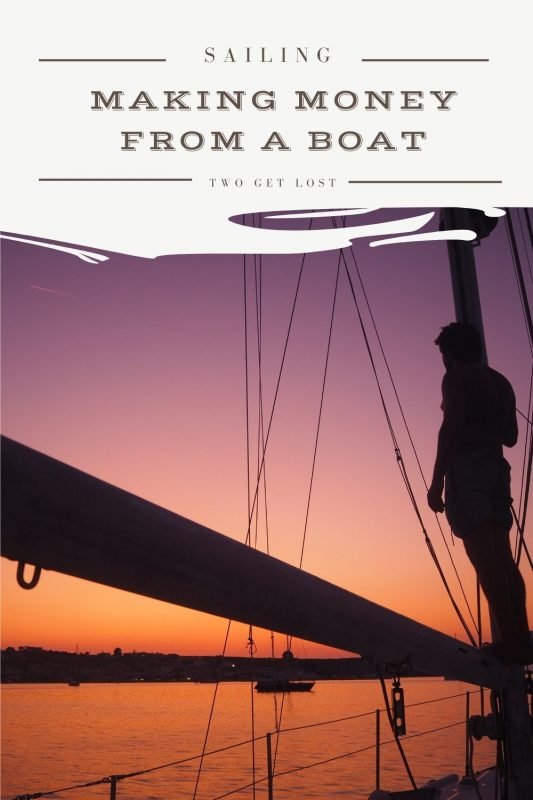
How to Make Money While Living on a Sailboat

How To Keep A Sailing Log

Sailing In Argostoli, Kephalonia: A Cruisers Guide
A Complete Guide To Sailing In A Storm
Sailing in a storm can be a challenging experience but with the right preparation and techniques, it can be navigated safely in most instances.
While it's best to avoid storms when sailing, there are times when storms cannot be avoided.
To sail in a storm:
- Prepare the sailboat for a storm
- Monitor the weather conditions
- Adjust the sailboat to stabilize the vessel in the storm
- Maintain communication with the coast guard
The number one priority when sailing in a storm is safely navigating through the water during these bad weather conditions.
1. Prepare The Sailboat For A Storm
The first step of sailing in a storm is to prepare the sailboat for storm weather conditions.
To prepare a sailboat for a storm:
- Check the rigging & sails : Assess the rigging and sails overall condition. Ensure they are in full working order with no issues with maneuverability or rips in the sails. There should be a storm sail onboard too in preparation for sailing in the storm
- Ensure safety equipment is onboard : Ensure there are liferafts, life jackets for everyone onboard, life buoys, heaving lines, sailing jackets, flashlights, flares, VHF radios, chartplotter/GPS, first aid kits, and fire extinguishers
- Remove the boat canvas/bimini top : In preparation for sailing in a storm, remove the boat canvas/bimini top to prevent it from getting damaged or destroyed or causing injury to passengers onboard
- Ensure loose items are tied down : Any loose items like lines on the deck should be tied down and secured before sailing in a storm. Loose items can become dislodged and damaged or cause injury to passengers onboard if they are not secured during a storm
- Ensure the sailboat's engine is in great condition : Ensure the sailboat's motor is in perfect condition with sufficient oil and fuel to operate during the storm
Preparing the sailboat for a storm will take approximately 30 minutes to complete. This timeframe will vary depending on the size of the vessel and the amount of equipment needed to be purchased and installed onboard.
In preparing for sailing in a storm, there is certain sailboat equipment needed. The equipment needed for sailing in a storm includes a storm sail, heaving lines, sailing jackets, life jackets, life buoys, liferafts, first aid kit, Chartplotter/GPS, fire extinguishers, VHF radio, and flares.
The benefits of preparing the sailboat for a storm are a sailor will be prepared for any issues caused by the storm and a sailor will have the necessary safety equipment to help keep everyone onboard safe during the storm.
One downside of preparing the sailboat for a storm is it can be costly (over $500) especially if the sailor does not have all the right equipment needed to withstand the stormy weather. However, this is a small downside.
2. Monitor The Weather Conditions
The second step of sailing in a storm is to monitor the weather conditions regularly.
To monitor the weather conditions:
- Connect to the VHF radio weather channel : Connect to channel 16 on the VHF radio as this channel provides storm warnings and urgent marine information for boaters
- Use a chartplotter : Modern chartplotters will have marine weather data for boaters to monitor the weather conditions and check windspeeds, rainfall levels, wave height and other relevant marine weather data
- Check a marine weather forecast provider website : If you have internet access on the sailing trip, connect to a marine weather provider for marine weather forecast information in your area
In sailing, weather conditions are considered a storm when the wind speed is 28 knots or higher and the wave heights are 8ft or higher. Other characteristics of stormy weather when sailing is poor visibility with visibility ranges of under half a mile (0.8km or less) and heavy rain with a precipitation rate of at least 0.1 inches (2.5 millimeters) per hour.
It can take approximately 3 to 6 hours for a storm to fully develop when sailing. However, for larger storms, it can take over 2 days for the storm to fully develop.
Monitoring the weather should be done every 20 minutes when sailing in a storm to get up-to-date information on potential nearby locations with better weather to sail to.
The benefit of regularly monitoring the weather conditions is a sailor will be more prepared for the weather that lies ahead and the sailor will be able to make adjustments to their sailing route to help avoid the bad weather.
3. Adjust The Sailboat To Stabilize The Vessel
The third step of sailing in a storm is to adjust the sailboat to stabilize the vessel.
When sailing through the storm, reef the sails to reduce the stress and load on the mast and sails, attach the storm sails, turn the vessel until the wave and wind direction are blowing from the stern of the sailboat, i.e. the wind is blowing downwind. Carefully tack the sailboat slowly until the boat is in the downwind position. Pointing the sailboat downwind is not recommended if the sailboat is near land as it could cause the boat to run into the land.
Alternatively, if the storm is very bad, sailors can perform a "heaving to" storm sailing maneuver.
To perform the heave-to storm sailing maneuver:
- Turn the bow of the boat into the wind : This involves turning the sailboat so that the bow faces into the wind. This will cause the boat to lose forward momentum and begin to drift backward
- Adjust the sails : Depending on the size and configuration of your boat, you may need to adjust the sails in different ways. In general, you will want to position the sails so that they are catching less wind and are working against each other. This will help to slow the boat's drift and keep it from moving too quickly
- Adjust the rudder : You may need to adjust the rudder to keep the boat from turning too far or too fast. In general, you will want to angle the rudder slightly to one side to counteract the wind and keep the boat on a stable course
- Monitor the boat's drift : Once you have heaved-to, you will need to monitor the boat's drift and make small adjustments as needed to maintain your position. This may involve adjusting the sails, rudder, or other factors as conditions change
The heaving to maneuver is used to reduce a sailboat's speed and maintain a stationary position. This is often done in rough weather to provide the crew with a stable platform to work from or to wait out a storm.
This sailing maneuver will adjust the sailboat and should stabilize the vessel in the storm.
The benefits of adjusting the sailboat position in a storm are it will help to stabilize the boat, it will improve safety, it will reduce the crew's fatigue as the crew will not be operating with a boat at higher speeds, it will help maintain control of the sailboat, and it will reduce stress on the sailboat and the rigging system.
Depending on the size of the sailboat, how bad the weather conditions are, and a sailor's experience level, adjusting the sailboat to stabilize it in the storm should take approximately 10 minutes to complete.
4. Maintain Communication With The Coast Guard
The fourth step of sailing in a storm is to maintain communication with the coast guard.
This is particularly important if the storm is over Beaufort Force 7 when sailing is much harder.
To maintain communication with the coast guard during a storm:
- Understand the important VHF channels : During sailing in a storm, be aware of VHF international channel 16 (156.800 MHz) which is for sending distress signals
- Ensure there are coast guard contact details on your phone : Put the local coast guard contact details into your phone. These contact details are not substitutes for using the VHF channel 16 distress signal or dialing 911. These contact details should only be contacted if all else fails
Contacting the coast guard takes less than 1 minute to complete and they are fast to respond in case of an emergency caused by the storm.
The benefits of maintaining communication with the coast guard during a storm are it will help improve safety, the coast guard will be able to provide real-time alerts, and it will provide navigation assistance as the coast guard has access to the latest navigation technology and can guide you through the storm's hazardous areas such as shallow waters or areas with a strong current.
Frequently Asked Questions About Sailing In A Storm
Below are the most commonly asked questions about sailing in a storm.
What Should You Do If You're Caught Sailing In A Storm With Your Boat?
if you're caught sailing in a storm with your boat, you should reef the sails, attach the storm sails and tack the vessel slowly until the wave and wind direction are blowing from the stern of the sailboat.
Should You Drop An Anchor When Sailing In A Storm?
Dropping an anchor can be a useful technique to help keep a boat steady during a storm. However, whether or not to drop an anchor depends on a variety of factors including the size and type of the boat, the severity of the storm, the water depth, and the type of bottom (i.e., mud, sand, or rock).
If you are in a smaller boat that is being pushed around by the waves, dropping an anchor can help keep the boat oriented in a particular direction, reducing the boat's drift. Additionally, it can help reduce the risk of capsizing or being thrown onto a rocky shore.
However, if the storm is very severe with high winds and waves, the anchor may not be enough to hold the boat in place, and it may put undue stress on the anchor and the boat's attachment points. In such a case, it is usually better to try to navigate to a sheltered area or to deploy sea anchors that can help reduce the boat's drift.
It is also essential to be careful when anchoring in a storm as it can be challenging to set the anchor correctly and the wind and waves can cause the anchor to drag.
Is It Safe To Sail In A Storm?
Sailing in a storm should be avoided due to the lack of safety. However, experienced sailors can sail in storms up to Beaufort Force 7 if required. Beaufort Force 8 and higher storms are extremely dangerous to sail in and should be avoided at all costs.
How Do You Improve Safety When Sailing In A Storm?
To improve safety when sailing in a storm, wear a life jacket, hook everyone onboard up to a safety line or harness so they don't fall overboard, reef the sail to improve the sailboat's stability, and understand where all the safety equipment is onboard and how to operate it in case of an emergency.
What Type Of Storm Should Not Be Sailed In?
A sailor should not sail in any storm but especially a storm from Beaufort Force 8 to Beaufort Force 12 as it is considered to be too dangerous.
Can You Sail Through A Hurricane?
While sailors have successfully sailed through hurricanes in the past, sailing through a hurricane should be avoided at all costs. Sailing in hurricane weather is too dangerous and could result in loss of life.
What Are The Benefits Of Sailing In A Storm?
The benefits of sailing in a storm are:
- Improves sailing skills : Sailing in a storm will force sailors to improve their sailing skills and increase their ability to handle rough seas
- Exciting experience : For some sailors, the thrill of navigating through a storm can be an exhilarating experience that they enjoy. The adrenaline rush and sense of accomplishment of successfully sailing through a storm can be incredibly rewarding
- Greater appreciation for the power of nature : Sailing in a storm can provide a unique perspective on the power of nature. It can be humbling and awe-inspiring to witness the raw force of the wind and waves and this can lead to a greater appreciation for the natural world
It's important to note that these potential benefits should never come at the expense of safety. For the majority of sailors, it is smarter to avoid sailing in a storm and instead wait for the bad weather to pass.
What Are The Risks Of Sailing In A Storm?
The risks of sailing in a storm are:
- Boat sinking/capsizing : With high winds over 28 knots and waves and swells at heights over 8ft, there is a risk of the sailboat capsizing and sinking
- People drowning : High winds and high waves during a storm can cause people onboard to fall overboard and drown
- Loss of communication : Bad storm weather can cause the sailboat's communication system to stop working making it much harder to signal for help if needed
- Boat damage : Storm weather can damage the boat including the sails, mast, rigging system, lines, Bimini top, etc.
- Poor visibility : Sea spray, large waves over 8ft, and heavy winds over 28 knots can reduce the visibility to under 500 meters in some instances making it difficult for navigation
- People being injured : People onboard can get injured due to the increase and sharp movements caused by the storm
What Should Be Avoided When Sailing In A Storm?
When sailing in a storm, avoid:
- Getting caught sailing in the storm in the first place : Ideally, a sailor should avoid sailing in the storm in the first place by checking the weather radar and instead wait for the weather to clear before continuing their sailing trip
- Increasing the sail area : Increasing the sail area in a storm should be avoided as it can cause the sailboat to become more unstable and increase the risk of capsizing
- Not wearing a life jacket : Life jackets should be worn at all times when sailing but especially during a storm. Avoid not wearing a life jacket in a storm as there is no protection if someone falls overboard
- Not wearing the appropriate gear to stay dry : Sailors should avoid not wearing the appropriate foul weather gear to stay dry when sailing in a storm
- Not connecting the crew to safety lines/harness : When sailing in a storm, all crew on the boat deck should be
- Not understanding the safety equipment : Sailors should avoid not understanding the safety equipment onboard
How Do You Avoid Sailing In A Storm?
To avoid sailing in a storm, check the weather forecast regularly when going on a sailing trip to know when and where not to sail as the weather gets worse in these areas. If a sailing trip involves passing through a storm, wait in an area where there is no storm until the weather clears up in the storm area before continuing on the voyage.
What Are The Best Sailboats For Sailing In A Storm?
The best sailboats for sailing in a storm are the Nordic 40, Hallberg-Rassy 48, and the Outremer 55.
What Are The Worst Sailboats For Sailing In A Storm?
The worst sailboats for sailing in a storm are sailing dinghies as they offer little protection from the dangers of stormy weather.
What Is The Best Sized Sailboat For Sailing In A Storm?
The best-sized sailboats to sail in a storm are sailboats sized 30ft. and longer.
What Is The Worst Sized Sailboat For Sailing In A Storm?
The worst-sized sailboats to sail in a storm are sailboats sized under 30ft. as it is more difficult to handle rough weather and choppy waves in these boats.
The Worldwide Leader in Sailmaking
- Sail Care & Repair
- Sailing Gear
- Sail Finder
- Custom Sails
- One Design Sails
- Flying Sails
- New Sail Quote
- 3Di Technology
- Helix Technology
- Sail Design
- NPL RENEW Sustainable Sailcloth
- Sailcloth & Material Guide
- Polo Shirts
- Sweaters & Cardigans
- Sweatshirts & Hoodies
- Accessories
- Mid & Baselayers
- Deckwear & Footwear
- Luggage & Accessories
- Spring Summer '24
- Sailor Jackets
- NS x Slowear
- Sailor Jacket
- Sustainability
- North Sails Blog
- Sail Like A Girl
- Icon Sailor Jacket
- Our Locations
- North SUP Boards
- North Foils
- North Kiteboarding
- North Windsurfing
SAIL FINDER
SAILING GEAR
COLLECTIONS & COLLAB
COLLECTIONS
WE ARE NORTH SAILS
ACTION SPORTS
Popular Search Terms
Collections
Sorry, no results for ""
How To Sail Safely Through a Storm
How to sail safely through a storm, tips and tricks to help you get home safe.

Compared to the quick response and sudden nature of a squall , sailing through a storm in open water is an endurance contest. In addition to big wind, you’ll have to deal with big waves and crew fatigue.
Sailing in Waves
Sailing in big waves is a test of seamanship and steering, which is why you should put your best driver on the helm. Experienced dinghy sailors often are very good at heavy air steering, because they see “survival” weather more often than most cruisers.
Avoid sailing on a reach across tall breaking waves; they can roll a boat over. When sailing close-hauled in waves, aim toward flat spots while keeping speed up so you can steer. To reduce the chance of a wave washing across the deck, tack in relatively smooth water. A cubic foot of water weighs 64 pounds, so a wave can bring many hundreds of pounds of water across the deck.
Sailing on a run or broad reach in big waves is exhilarating, but be careful not to broach and bring the boat beam-to a breaker. Rig a preventer to hold the boom out.

Storm Sails
If reefing isn’t enough to reduce power, it’s time to dig out your storm sails — the storm trysail and storm jib. They may seem tiny, but since wind force rises exponentially, they’re the right size for a really big blow. Storm trysails are usually trimmed to the rail, but some modern ones are set on the boom. The storm jib should be set just forward of the mast to keep the sail plan’s center of effort near the boat’s center of lateral resistance. This helps keep the boat in balance.
Storm Strategy
The first decision before an approaching storm is the toughest: Run for cover, or head out to open water for sea room? With modern forecasting, a true storm will rarely arrive unannounced, but as you venture further offshore the chances of being caught out increase. While running for cover would seem the preferred choice, the danger lies in being caught in the storm, close to shore, with no room to maneuver or run off.
Two classic storm strategies are to try to keep away from land so you’re not blown up on shore, and to sail away from the storm’s path — especially its “dangerous semicircle,” which is its right side as it advances.
Storm Tactics
Storm tactics help you handle a storm once you’re in it. There are several proven choices, all of which aim to reduce the strain and motion by pointing one of the boat’s ends (either bow or stern) toward the waves. No one tactic will work best for all boats in all conditions.
Sail under storm jib and deeply reefed mainsail or storm trysail. This approach provides the most control. Sails give you the power to steer and control your boat in the waves.
Run before the storm with the stern toward the waves, perhaps towing a drogue to slow the boat. This tactic requires a lot of sea room, and the boat must be steered actively. Another concern is that you will remain in front of an approaching storm, rather than sailing out of its path.
Heave-to on a close reach with the jib trimmed to windward. Heaving-to can be an excellent heavy weather tactic, though some boats fare better than others.
Deploy a sea anchor while hove-to or under bare poles. A sea anchor is a small parachute set at the end of a line off the bow. A sea anchor helps keep the bow up into the waves so the boat won’t end up beam to the seas. One concern is the load on the rudder as waves push the boat aft.
Another alternative is lying ahull, simply sitting with sails down. This passive alternative is less reliable than the other tactics, as you lose the ability to control your angle to the waves and may end up beam to the seas. Furthermore, the motion of the boat rolling in the waves without the benefit of sails can be debilitating.
Want to order a storm trysail or storm jib for your boat? Contact a North Sails Expert here .
How to Heave-To
Wouldn’t it be great if, during a heavy air sail, you could just take a break, and relax for a bit? Imagine a short respite from the relentless pitching and pounding: a chance to rest, take a meal, or check over the boat in relative tranquility. Well, you can. The lost art of heaving-to allows you to “park” in open water.
To heave-to, trim the jib aback (i.e., to the wrong side), trim the main in hard, and lash the helm so the boat will head up once it gains steerageway. As the jib tries to push the bow down, the bow turns off the wind and the main fills, moving the boat forward. Once the boat begins to make headway, the lashed helm turns the boat toward the wind again. As the main goes soft the jib once again takes over, pushing the bow down. The main refills, and the rudder pushes the bow into the wind again.
The boat won’t actually stop. It will lie about 60 degrees off the wind, sailing at 1 or 2 knots, and making significant leeway (sliding to leeward). The motion will be much less than under sail, and dramatically more stable and pleasant than dropping all sails and lying ahull. You will also be using up less sea room than if you run before the storm at great speed.
Achieving this balance will require some fine tuning, depending on the wind strength, your boat design, and the sails you are flying. Also, fin-keeled boats do not heave to as well as more traditional designs.
In storm seas, some boats will require a sea anchor off the bow to help hold the boat up into the waves while hove-to.

Alternate Storm Strategy: Don’t Go
If conditions are wrong, or are forecast to worsen, don’t go. If you can avoid the storm, then do so.
If you’re at home, stay there. If you’re mid-cruise, button up the boat, make sure your anchor or mooring or dock lines are secure, and then read a book or play cards. Relax. Enjoy the time with your shipmates. Study the pile of Owners’ Manuals you’ve accumulated with each piece of new gear. Tinker with boat projects.
Put some soup on the stove, and check on deck every so often to make sure the boat is secure. Shake your head as you return below, and remark, “My oh my, is it nasty out there.”
If your boat is threatened by a tropical storm or hurricane, strip all excess gear from the deck, double up all docking or mooring lines, protect those lines from chafe, and get off. Don’t risk your life to save your boat.
Misery and Danger
Although everyone will remember it differently years later, a long, wet, cold sail through a storm can be miserable. As the skipper, you need to make the best of it: watch over your crew, offer relief or help to those who need it, and speak a few words of encouragement to all. “This is miserable, but it will end.”
Take the time to marvel at the forces of nature, and at your ability to carry on in the midst of the storm. Few people get to experience the full fury of a storm. It may not be pleasant, but it is memorable.
While misery and discomfort can eventually lead to fatigue, diminished performance, and even danger, do not mistake one for the other. Distinguish in your own mind the difference between misery and danger. Don’t attempt a dangerous harbor entrance to escape misery; that would compromise the safety of the boat and crew, just to avoid a little discomfort.
Interested in a new sail quote or have questions about your sails? Fill out our Request a Quote form below and you will receive a reply from a North sail expert in your area.
REQUEST A QUOTE
FEATURED STORIES
How to care for your foul weather gear.
27 February
GITANA TEAM WINS INAUGURAL ARKEA ULTIM CHALLENGE
Npl renew faq.
- Refresh page
Yachting World
- Digital Edition

Expert sailing advice: How to handle a lightning strike on board
- August 21, 2019
Pip Hare shares advice from sailors who have experienced a lightning strike on how to avoid getting hit by an electrical storm

The 2015 Volvo Ocean Race encountered electrical storms. Credit: Brian Carlin / Team Vestas Wind
Lightning is the thing that scares me the most at sea. Having never experienced a lightning strike I think this is mostly a fear of the unknown, coupled with a sense of helplessness.
My lightning strategy has always been to sail in the opposite direction and hope for the best. The following is a combination of my own practice and observations from sailors who’ve experienced a lightning strike first-hand.
Avoiding lightning
Thunderstorms are created in conditions where there is great instability between the upper and the lower layers of the atmosphere. Typically, thunderstorms follow an extended period of warm, still weather , but lightning can also form along very active frontal systems – this tends to follow a sustained period of average pressure, with little gradient breeze when the new front moves in quickly.
Forecasters can predict where there will be increased potential for lightning to form, but not its actual occurrence or exact location.
Specialist forecast models such as the CAPE (convective available potential energy) and the LI (lifted index) show storm potential by highlighting areas of atmospheric instability.
CAPE and LI forecasts are available via specialist weather sites and CAPE GRIBs can be obtained through some providers. Satellite images can also be useful for spotting intense areas of cumulonimbus clouds.
If planning a sailing voyage in areas where lightning could be expected, include a CAPE forecast in your daily GRIB run.
Article continues below…

What is a Spanish Plume? Thunderstorms, lightning and downdrafts explained
Earlier this summer we saw considerable thunderstorm activity over the UK and Europe, resulting in flooding and some serious injuries.…

Sailing through calms: Expert advice from ocean racer Pip Hare
Psychologically, I have always found sailing through calms to be far worse than battling any storm. Endlessly flogging sails and…
Flashes on the horizon
If you get caught out or have to sail through an area where electrical storms are expected, it’s important to prepare for all the weather a thunderstorm can dish out, not just lightning.
Thunder claps can be heard for around 25 miles, so if the sky on the other side of the horizon is alive with light but you can hear no noise then stay vigilant but don’t panic – the storm is still a way off. Keep moving.
Keep a 360° look-out: due to the immense height of thunderclouds they are pushed along by upper atmosphere wind, not the sea-level breeze. This makes it difficult to predict which way a cloud is moving, they can sneak up behind you while you are sailing upwind. The best way to track thunderclouds is using the radar or a hand-bearing compass.
Prepare for a squall: wind associated with thunderclouds can reach in excess of 40-90 knots in a matter of seconds, this will often be combined with torrential rain and drastically reduced visibility. If there’s lightning around it’s best to keep on-watch crew in the cockpit so make sure you reef early.
Preparing for a strike
Lightning can strike up to ten miles away from the cloud that generated it. Just because you are in the midst of a thunderstorm doesn’t mean you will get hit – I’ve spoken to two sailors who reported lightning striking the water next to their boat but not touching them.
Others that were struck reported varying damage to electrical equipment and none experienced structural damage or fire. Here are some of their recommendations:
- Unplug all masthead units, including wind instruments and VHF antennas and ensure ends of leads are kept apart to avoid arcing.
- As the storm gets closer turn off all electronics – modern kit has increasingly efficient internal protection, but manufacturers still advise turning it off.
- Take a fix and plot it on a paper chart. Update your log using dead reckoning.
- Avoid touching metal around the boat, such as shrouds and guardrails.
- A nearby strike will be blindingly bright. Sit in the cockpit until your night vision returns.
- Expect masthead units, VHF antennas and lights to be destroyed, so make sure you carry a good quality spare VHF antenna.
- Fluxgate compasses can lose calibration following a strike. Check all electronic compass readings with a handheld compass.
Maximising protection
By providing a direct route ‘to ground’ down which the lightning may conduct you may be able to minimise damage.
Among my small sample of interviewees, only one had a lightning protection system: this was a sloop with a deck-stepped mast on which the chainplates were bonded to the keel bolts. The masthead unit on this boat was still totally destroyed by the strike but the remaining electronics suffered no ill effects. The same sailor had experienced a strike two years earlier with no extra protection installed – in that instance all electronics were destroyed.
The remaining sailors were all in boats of less than ten years old and reported varying degrees of damage to electronics and 100% destruction of masthead units.
The simplest protection system is bonding an aluminium mast to the keel bolts. On a keel-stepped mast this is easily done as the mast heel and keel bolts are close to each other. For deck-stepped masts this can be achieved by running an adequately sized cable through the deck head and down a bulkhead or supporting pillar.
Most modern boats have the mast bonded to the keel by manufacturers – if you’re not sure lift the soleboards to check. Masts made of less conductive materials such as carbon would require a conductor cable as well.
Air terminals at least six inches higher than any antennas at the top of your mast may save your masthead units. There is also considerable debate over the need for dedicated grounding plates – this appears to be more relevant to older boats as none of my interviewees suffered ill effects through grounding to the keel bolts.
Faraday cage
There is a theory that the oven on a yacht can act as a Faraday cage, protecting anything inside it from the effects of electrostatic discharge (ESD). Handheld or portable electronics can be temporarily placed inside a metal oven to protect them during a storm.
I have no conclusive evidence this works, but I’ve always done it, reckoning it can’t do any harm – just remember to take them out before dinner!
- BOAT OF THE YEAR
- Newsletters
- Sailboat Reviews
- Boating Safety
- Sailing Totem
- Charter Resources
- Destinations
- Galley Recipes
- Living Aboard
- Sails and Rigging
- Maintenance
- Best Marine Electronics & Technology

Storm Tactics for Heavy Weather Sailing
- By Bill Gladstone
- Updated: November 15, 2021
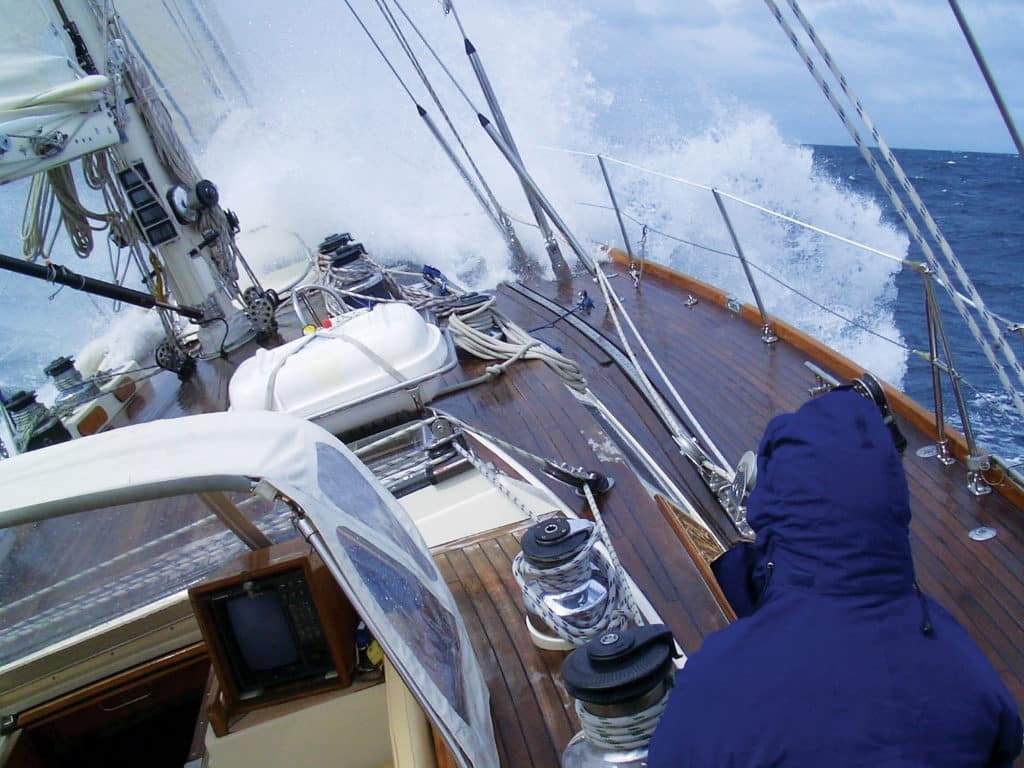
Storm tactics can be roughly defined as the ways to handle a storm once you’re in it. There are several proven choices, all of which intend to keep either the bow or stern pointing toward the waves. No one tactic will work best for all sailboats in all conditions. As skipper, it will be up to you to consider the best approach for your vessel, procure the right equipment, and practice with it before it’s needed.
Here we look at some active storm options that might work when conditions are still manageable and you want to actively control and steer the boat. Crew fatigue is a serious consideration when using active tactics.

Forereaching
Although not often mentioned as a tactic, it can be highly effective for combating brief squalls or moderate-duration storms. Here’s how to set up your boat for forereaching: Roll the jib away (especially if you have a large roller-furler genoa set); reef the main down to the second or third reef position; and sail on a closehauled course, concentrating on keeping the boat flat. It will be a comfortable ride, everyone will be relatively happy, and you will be making 2 to 3 knots on a close reach. Check your course over ground because increased leeway will cause your track to be much lower. This is a possibly useful tactic to claw off a lee shore. Note that not all boats will be at ease forereaching, so you’d better experiment with it ahead of time. Catamarans in particular will lurch and demonstrate much-increased leeway.
Motorsailing
Sometimes it’s necessary from a time or safety perspective to stow the jib and fire up the iron genny instead. Motorsailing lets you point high and make progress to windward. Motoring with no sails will not work well (or at all, in some cases), particularly in big seas, but a reefed mainsail will provide lateral stability and extra power. Trim the main, head up high enough to control your angle of heel, set the autopilot, and keep a lookout. Fuel consumption makes this a short-term option.
Here’s a tip: Make sure cooling water is pumping through the engine. On some sailboats, the water intake lifts out of the water when heeled. A further difficulty is that the pitching boat might stir sediment off the bottom of the fuel tank, which can, in turn, clog the fuel filter.
Running off and drogues
Sailing under storm jib and a deeply reefed mainsail or storm trysail provides the most control. If you don’t have storm sails, a reefed jib will give you the power to steer and control your boat in the waves. The boat must be steered actively to maintain control because no autopilot will be able to do this.
If excessive speed is a problem and steering becomes difficult, towing a drogue will slow the boat. A retrieval line should be set from the head of the drogue for when it is time to bring it back on board. If you don’t have a drogue, trailing warps might help slow the boat.
In a storm of longer duration, or when conditions become otherwise unmanageable, the situation might call for a skipper to consider passive storm tactics. When you are exhausted and you just want to quiet down the boat and maybe get some rest, there are other boathandling options available, depending on the sea state and the equipment you have onboard.
Heaving to can be an excellent heavy-weather tactic, though some boats fare better than others. Wouldn’t it be great if during a heavy-weather episode you could just slow everything way down? Imagine a short respite with a reduced amount of motion from the relentless pitching and pounding. A chance to regroup, make a meal, or check over the boat. Well, you can.
Heaving to allows you to “park” in open water. Hove-to trim has the jib trimmed aback (that is, to the wrong side), the reefed main eased, and the helm lashed down to leeward. The easiest way to do this is to trim the jib sheet hard and then tack the boat, leaving the sheet in place. Trimmed this way, the jib pushes the bow down. As the bow turns off the wind, the main fills and the boat moves forward. With the helm lashed down, the rudder turns the boat toward the wind. As the main goes soft, the jib once again takes over, pushing the bow down. The main refills, and the rudder pushes the bow into the wind again.
RELATED: Safety at Sea: Mental Preparations Contribute to Positive Outcomes
Achieving this balance will require some fine-tuning, depending on the wind strength, your boat design and the sails you have. You might, for example, need to furl the jib most of the way in to match the wind strength. Trimming the main will ensure that the bow is at an angle to the waves, ideally pointing 40 to 60 degrees off. Modern fin-keeled boats do not heave to as well as more-traditional full-keel designs.
When hove to, the boat won’t actually stop. It will lie, as noted, about 40 to 60 degrees off the wind, sailing at 1 or 2 knots, and making leeway (sliding to leeward). Beware of chafe. When hove to, the jib’s clew or sheet will be up against the shroud and might experience wear damage. Monitor this regularly, and change the position of the sheet occasionally. You might not want to heave to for an extended time.
Deploying a sea anchor
A sea anchor is a small parachute deployed on a line off the bow. A sea anchor helps keep the bow pointed up into the waves so the boat won’t end up beam to the seas. Light displacement boats will pitch violently in high seas, and chafe and damage might occur to the bow, so setting up a bridle and leading it aft through a snatch block will allow the boat to lie at an angle to the waves, providing a more comfortable ride. A big concern when using a sea anchor is the load on the rudder as the waves slam the boat backward. Chafe on the sea-anchor bridle is another big factor, so the bridle must be tended regularly.
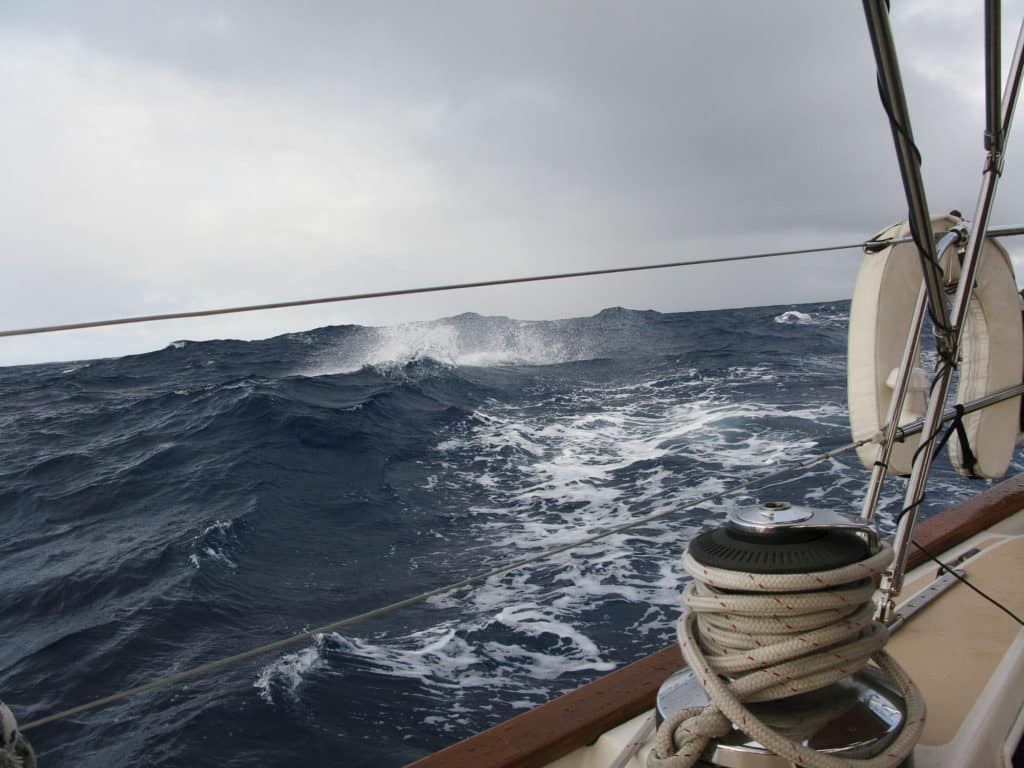
Remember, if you and your vessel are caught out in heavy-weather conditions, as a skipper, you must show leadership by setting an example, watching over your crew, offering relief and help to those who need it, and giving encouragement. Remember too, discomfort and fear can lead to fatigue, diminished performance, and poor decision-making. Don’t compromise the safety of the boat and crew to escape discomfort.
Few people get to experience the full fury of a storm. Advances in weather forecasting, routing and communications greatly improve your odds of avoiding heavy weather at sea, but you’re likely to experience it at some point, so think ahead of time about the tactics and tools available to keep your crew and vessel safe.
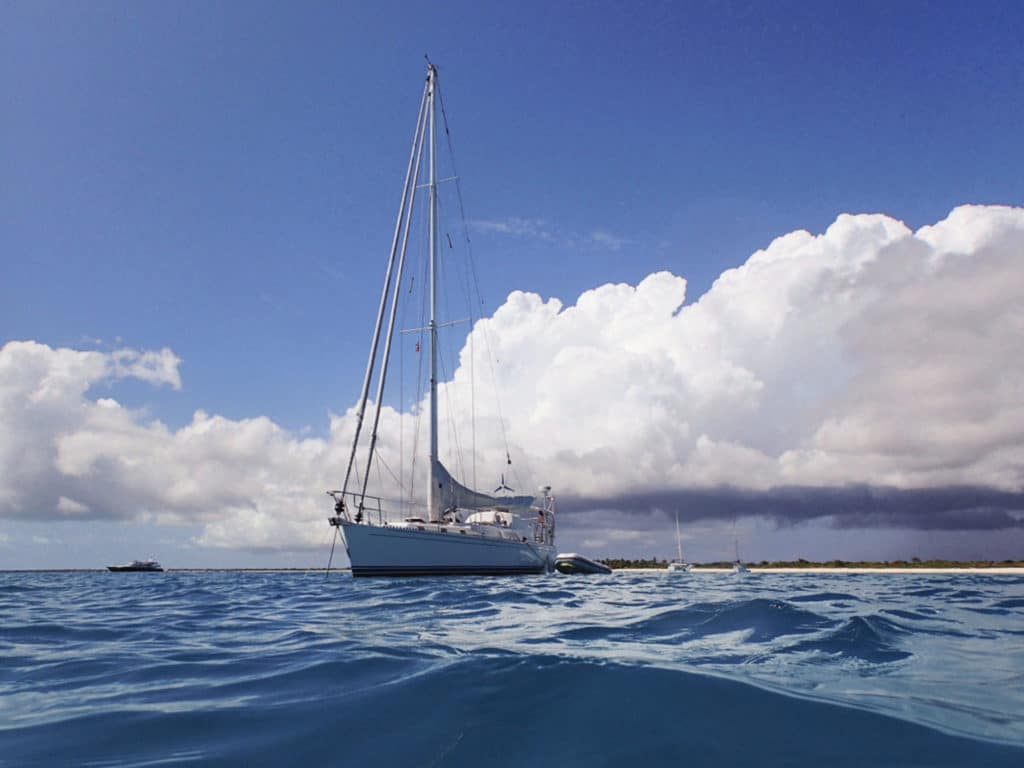
Heavy weather might not be pleasant, but it is certainly memorable, and it will make you a better sailor. Take the time to marvel at the forces of nature; realize that the boat is stronger than you think.
Happy sailing, and may all your storms be little ones!
This story is an edited excerpt from the American Sailing Association’s recently released manual, Advanced Cruising & Seamanship , by Bill Gladstone, produced in collaboration with North U. It has been edited for design purposes and style. You can find out more at asa.com.
- More: Anchoring , How To , print nov 2021 , safety at sea , seamanship
- More How To
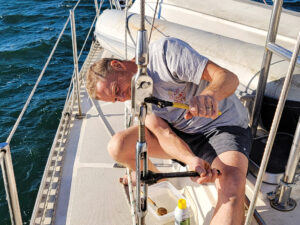
How to Rig Everything in Your Favor
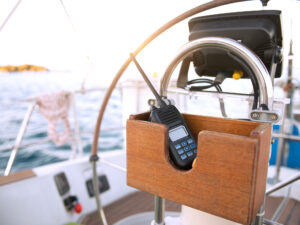
Is There a Doctor Aboard?

3 Clutch Sails For Peak Performance

It’s Time to Rethink Your Ditch Kit

Cruising the Northwest Passage

Balance 442 “Lasai” Set to Debut

A Legendary Sail

10 Best Sailing Movies of All Time
- Digital Edition
- Customer Service
- Privacy Policy
- Email Newsletters
- Cruising World
- Sailing World
- Salt Water Sportsman
- Sport Fishing
- Wakeboarding
Heavy Weather Sailing
Best Sailing Tactics for High Winds and Waves
Many sailors both beginning and experienced fear storms as the greatest danger on the water, even though more emergencies and fatalities occur during times of relative calm. Nonetheless, strong winds and high waves can wreak havoc on a sailboat and any sailor who might be caught by even a summer thunderstorm, or a longer-lasting and greater storm offshore, should know how to stay safe in heavy weather.
Storm Sailing Tactics
It's often said that boats are stronger than people, meaning your first priority is to protect yourself. Be sure to have and use the right safety gear, such as PFDs and harnesses or tethers to keep you on the boat. The boat's motion will be more severe in storm conditions and taking action early will prevent injury and prevent seasickness that can further endanger your safety. Consider the following issues and strategies for keeping the boat under control in storm conditions.
Avoiding Shallows
When the heavy weather begins or threatens, the first impulse is often to drop the sails, start up the motor and head for land. If you can safely reach a harbor and return to a dock or mooring, this may be your safest option. Be aware that wind and waves can rapidly turn shallow areas or narrow channels into a more dangerous place than open water, especially if the storm will be short-lived and it's mostly a matter of waiting it out.
Waves become steeper and more likely to break in shallow areas, making it difficult to control the boat. Consider the risks if your engine were to die and the wind rapidly blow you onto the rocks or other obstructions. If the wind is blowing toward shore, it can also be risky to attempt to anchor, because the boat may go aground if the anchor drags. It is difficult and sometimes dangerous to try to reset an anchor in storm conditions. You may have better options staying in open water and riding out the storm using the tactics described below.
As soon as the wind begins or is anticipated to increase, it's time to reef the sails. The old saying is that if you are wondering whether you should reef, then it's already past time to do so. You don't want a lot of sail up when a strong gust hits, potentially leading to capsize. It's also much easier to reef the mainsail or furl the jib while the wind is still manageable, and it can be dangerous to have to leave the cockpit to reef the main or drop the jib once the boat is being tossed or strongly heeled over by the wind.
Remember that if you are sailing downwind when the wind increases, you feel its effects less and can be shocked to see how hard it's blowing when you turn up into the wind to reef. Always pay attention and reef early. Monitor changes in the wind so that you can reef early when it's easy, rather than late, when it's difficult or dangerous. You can learn to read the wind or use an inexpensive handheld wind meter.
The following storm tactics are more applicable when offshore or nearshore and expecting the storm to last for some time.
Storm Sails
Offshore voyagers typically carry special sails for use in high winds. Regular sails can be reefed or furled only so far and still maintain an efficient shape and the fabric of regular sails is generally too light for high winds. A storm jib used with or without a trysail replacing the main generally allows one to continue sailing in stronger winds, usually on a course that minimizes the effects of waves.
Racing sailors, for example, usually have a selection of sails and may prefer to keep going rather than wait out the storm with a different tactic that would essentially stop the boat's progress. Many coastal and recreational sailors do not carry these extra sails, however, and prefer a different strategy, like heaving to.
Lying Ahull
Lying ahull simply means dropping the sails and letting the boat fare for itself, possibly while you go below to seek shelter. This strategy may work in limited situations when the waves are not too big, the boat is far enough from land and shipping channels so that it doesn't matter how far the boat drifts downwind. In some cases, it may be necessary to lie ahull to attend to an injury or simply because one is too exhausted to continue active strategies.
If the waves are large and breaking, however, there is a significant risk of the boat being rolled and capsizing because it will tend to lie broadside to the waves. Never attempt this in an open boat that would rapidly fill with water and sink; a larger boat with a closed cabin should bob back up. Still, this is seldom the preferable approach to take in a serious storm.
Using a Sea Anchor
Offshore voyagers are more likely to have invested in a sea anchor, which is like a parachute deployed underwater to keep the bow pointed into the wind and waves. Breaking waves causes less damage to the bow than from any other angle and the boat is less likely to capsize or roll when facing large waves. A sea anchor can be expensive, however, and takes time and skill to deploy. This is a strategy used for a serious storm that will last for some time, not a passing squall or thunderstorm.
Heaving to is a time-honored storm tactic preferred by many sailors. The boat is turned close to the wind, the jib (partly furled or smaller jib hoisted) is backwinded, the helm is locked into position and the boat slowly jogs along without turning broadside to the waves, as when lying ahull. This is a valuable skill for all sailors and it's a good idea to practice it in your own boat to know how best to accomplish it when needed.
An advantage of heaving to is that you don't have to stay at the helm but can go below, if it is safe to do so, or duck beneath the dodger. The boat remains pointed close enough to the wind that it is less likely to be rolled by a breaking wave. In addition, the downwind sliding motion of the hull produces a slick in the water that makes it less likely for a wave to break on the boat.
Heaving to using a sea anchor is one of the best conservative storm tactics. The anchor is adjusted off to one side to help the bow point closer to the wind than when heaving to without a sea anchor, but the boat still drifts back slightly to make a slick. World-traveling Lin and Larry Pardey's video "Storm Tactics" and the book "Storm Tactics Handbook" argues persuasively for this technique and illustrates how it is accomplished.
Running Off
The final heavy weather tactic, used by some accomplished sailors, is to run off downwind. Reduce sail as needed and in the true storm-force wind you can continue sailing downwind "under bare poles" with no sail at all. As the wind increases, the greatest danger is going too fast, even without the sail, in which case the boat may come down a large wave and bury the bow in the back of the wave in front. This may cause the boat to pitchpole end over end or otherwise capsize. To slow the boat, sailors historically trailed long, heavy lines off the stern and modern sailors can use a special drogue for that purpose.
While some sailors swear by running off, this tactic requires constant skillful steering. If the stern is not kept perpendicular to approaching waves, a wave can push the stern around to one side, causing a broach and likely capsize.
Other Resources
These brief descriptions serve only to introduce tactics for heavy weather sailing. Any boat owner who may ever be in a high winds situation, however, should be prepared to take appropriate action. At the minimum, it is important to be familiar with reefing and heaving to. Consider a good book on seamanship, such as " Chapman's Piloting & Seamanship " or " The Annapolis Book of Seamanship ".
West Wight Potter 19 Sailboat Review
The Best Boat Anchors to Fit All Types of Vessels
Learn How to Sail a Small Sailboat
The 4 Best Bass Boats
A Beginner's Guide to Sailing a Sailboat
The Five Most Common Rock Climbing Deaths
Learn the Parts of a Sailboat and How to Communicate Them
Beginner Dolphin Trolling Basics
The Beaches of Cancun and the Mayan Riviera
The 10 Best Lake and River Canoes of 2024
13 Best Beaches in Santa Barbara, California
RVer Preparedness for Lightening and Thunderstorms
The 9 Best Boat Covers of 2024
The Best Tandem Kayaks for a Smooth Ride
10 Tips for a Better, Safer Snorkeling Experience
The 9 Best Kayak Roof Racks

How to Survive Sailing in a Storm: Tips and Tricks for a Safe Voyage
The thrill of sailing on calm waters is an experience like no other, but sometimes, Mother Nature has other plans. As a sailor, it’s crucial to be prepared for the unexpected, including sailing through a storm.
The phrase “sail through the storm” may sound counterintuitive, but it refers to the actions you need to take to safely navigate stormy weather while aboard a sailing vessel.
In this comprehensive guide, we’ll explore what to do when sailing in a storm, how ships survive these tempestuous conditions, and the steps you can take to ensure your safety.
Key Takeaways Sailing in a storm is not something to take lightly. It requires careful planning, preparation, and execution. The best way to avoid sailing in a storm is to check the weather forecast regularly and plan your route accordingly. If possible, seek shelter before the storm hits or sail away from its path. If you have to sail through a storm, you need to reduce your sail area, balance your boat, steer actively, and secure everything on deck and below. There are different storm tactics that you can use depending on the wind direction, wave height, sea room, and boat type. Some of the most common ones are sailing under storm sails, running before the storm with a drogue, heaving-to, lying ahull, or anchoring. No matter what tactic you choose, you need to monitor the situation closely and be ready to adapt if necessary. You also need to take care of yourself and your crew by staying hydrated, rested, warm, and calm.
What is a Storm?
Before we dive into the details of sailing in a storm, let’s first define what we mean by a storm.
At this level, the sea is completely covered with long white patches of foam, and visibility is greatly reduced.
Of course, not all storms are created equal. Some storms are more severe than others, depending on factors such as wind direction, wind duration, air pressure, temperature, humidity, cloud cover, precipitation, lightning, thunder, etc.
Some storms are also more localized than others, meaning they affect only a small area for a short time. For example, squalls are sudden bursts of strong wind that usually last for less than an hour and can occur in clear or cloudy weather.
The most dangerous storms for sailors are tropical cyclones (also known as hurricanes or typhoons), which are large rotating systems of clouds and thunderstorms that form over warm ocean waters.
These storms can have wind speeds of over 74 knots (85 mph) and can cause massive waves, storm surges, flooding, landslides, and damage to coastal areas.
Tropical cyclones are classified into five categories based on their maximum sustained wind speed:
Tropical cyclones usually form between June and November in the Atlantic Ocean and between May and November in the Pacific Ocean.
They have different names depending on where they occur:
The best way to avoid sailing in a tropical cyclone is to stay away from its path. You can track the location and movement of tropical cyclones using satellite images, radio broadcasts, websites, apps, or other sources of information.
You can also use tools such as the Saffir-Simpson Hurricane Wind Scale or the Dvorak Technique to estimate the intensity of a tropical cyclone based on its appearance.
How to Prepare for Sailing in a Storm
The best way to deal with sailing in a storm is to prevent it from happening in the first place. This means planning your trip carefully and checking the weather forecast regularly before and during your voyage. You should also have a contingency plan in case things go wrong.
Here are some steps you can take to prepare for sailing in a storm:
Check the Weather Forecast
The weather forecast is your best friend when it comes to sailing safely. You should always check the weather forecast before you leave port and update it frequently while you are at sea. You should also pay attention to any weather warnings or alerts that may indicate an approaching storm.
There are many sources of weather information that you can use depending on your location and equipment. Some of them are:
- VHF radio: You can listen to marine weather broadcasts from local stations or coast guard services that provide information on wind speed and direction, wave height and period, sea state, visibility, precipitation, cloud cover, air pressure, temperature, and humidity. You can also request specific weather information from some stations or services using voice or digital selective calling (DSC).
- HF radio: You can receive weather fax images or text messages from various stations around the world that transmit information on synoptic charts, satellite images, wind/wave analysis, tropical cyclone warnings, etc. You need an HF radio receiver and a modem or software to decode the signals.
- NAVTEX: You can receive text messages from coastal stations that broadcast information on navigational warnings, meteorological warnings, ice reports, search and rescue information, etc. You need a NAVTEX receiver or an HF radio receiver with NAVTEX capability to receive the messages.
- NOAA National Weather Service
- NOAA National Hurricane Center
- PredictWind
- Buoyweather
- PassageWeather
- WeatherTrack
- Barometer: You can measure the air pressure using a barometer or an electronic device that has a barometer function. You can use the barometer readings to detect changes in the weather conditions. A falling barometer indicates an approaching low-pressure system that may bring bad weather. A rising barometer indicates an approaching high-pressure system that may bring good weather.
When checking the weather forecast, you should look for signs of an impending storm such as:
- A rapid drop in air pressure
- A sudden increase in wind speed or direction
- A change in cloud type or cover
- A change in temperature or humidity
- A change in visibility or precipitation
- A presence of lightning or thunder
- The presence of waterspouts or funnel clouds
You should also compare different sources of weather information to get a more accurate picture of the situation. Sometimes different sources may have conflicting or outdated information due to errors or delays in transmission or reception.
Plan Your Route
Once you have checked the weather forecast, you should plan your route accordingly. You should avoid sailing into areas where storms are likely to occur or where they may trap you against land or other obstacles. You should also have alternative destinations or safe havens in case you need to change your plans or seek shelter.
There are different tools and methods that you can use to plan your route, such as:
- Paper charts: You can use paper charts to plot your course and waypoints using a pencil, ruler, compass, and dividers. You should also have a chart table or a flat surface where you can spread out your charts and keep them dry and secure. Paper charts are reliable and easy to use, but they can be bulky, expensive, and outdated.
- Electronic charts: You can use electronic charts on your laptop, tablet, smartphone, or dedicated chart plotter device. You can also download or update your charts online or offline. Electronic charts are convenient and interactive, but they can be inaccurate, incompatible, or corrupted. They also depend on electricity and GPS signals, which may fail in a storm.
- Online tools: You can use online tools such as OpenSeaMap , SailingEurope , or FastSeas to plan your route using your web browser. You can also access various features such as weather data, nautical charts, marina information, etc. Online tools are useful and versatile, but they require an internet connection, which may not be available or reliable at sea.
When planning your route, you should consider factors such as:
- Distance: You should calculate the distance between your starting point and your destination, as well as between each waypoint along the way. You should also estimate the time it will take you to cover the distance based on your boat speed and the expected weather conditions. You should plan to sail at a comfortable and safe pace, without pushing yourself or your boat too hard.
- Direction: You should determine the direction of your course and waypoints using magnetic bearings or true bearings. You should also account for the variation and deviation of your compass due to the earth’s magnetic field and your boat’s magnetic interference. You should also adjust your course for the effects of wind, current, and leeway on your boat’s movement.
- Depth: You should check the depth of the water along your route using depth soundings or contour lines on your charts. You should also be aware of the tide levels and currents that may affect the depth of the water at different times and locations. You should avoid sailing in shallow water or near rocks, reefs, wrecks, or other hazards that may damage your boat or cause grounding.
- Destination: You should choose your destination carefully based on your preferences and needs. You should also research your destination before you arrive, such as its facilities, services, regulations, customs, culture, etc. You should also have a backup destination in case your primary one is unavailable or unsuitable.
Prepare Your Boat
Surviving a storm requires a great level of preparedness and it all begins long before setting out on a sail. As such, your chances of weathering a storm will increase if your boat is properly prepared to endure bad days on the water.
A major part of controlling your boat and the crew in a heavy storm is being prepared for the worst. This means that you should have your boat properly rigged to easily access anything in short order. Whether you can see a storm coming from far away or see it within seconds and on top of your head, the boat should be well prepared to deal with any condition.
It’s fundamental to ensure that your lifelines are secure, the lines are strong and unworn, and all the emergency gear is on board and up to date. You should also update yourself on the weather on the days you’re planning to go out though it may be inaccurate.
Some of the things you should check and prepare before sailing include:
- Hull integrity : Check for any cracks, leaks, or damage on the hull that could compromise its strength or water tightness. Repair any defects or reinforce any weak spots as needed.
- Rigging : Check all the standing rigging (mast, shrouds, stays) and running rigging (halyards, sheets) for any signs of wear or damage. Replace any frayed or broken lines or fittings. Lubricate any moving parts such as blocks or winches. Make sure all the lines are neatly coiled and secured to prevent tangling or tripping.
- Sails : Check all your sails for any tears or holes that could worsen in high winds. Repair any damage or replace any worn-out sails as needed. Make sure you have at least one set of storm sails (storm jib and trysail) on board that are easy to hoist and lower. Reefing lines should be ready to use at any time.
- Engine : Check your engine for any issues that could affect its performance or reliability. Change the oil and filter if needed. Check the fuel level and quality. Make sure you have enough spare fuel on board. Test the engine before leaving the dock to make sure it starts and runs smoothly.
- Batteries : Check your batteries for any corrosion or damage that could affect their capacity or charge. Make sure they are fully charged before leaving the dock. Test all your electrical systems (lights, instruments, radios) to make sure they work properly.
- Bilge pumps : Check your bilge pumps for any clogs or malfunctions that could prevent them from working effectively. Make sure they are wired correctly and have enough power supply. Test them before leaving the dock to make sure they pump water out of the bilge.
- Emergency gear : Check all your emergency gear for any damage or expiration dates that could affect their usefulness or safety. Make sure you have enough life jackets, harnesses, tethers, liferaft, EPIRB, VHF radio, distress flares, fire extinguishers, first aid kit, etc. on board, and that they are easily accessible and visible. Make sure everyone knows how to use them properly.
Prepare Yourself
Your boat is not the only thing that needs to be prepared for sailing in a storm. You also need to prepare yourself mentally and physically for the challenge. You need to be aware of the risks and consequences of sailing in a storm and be ready to face them. You also need to take care of your health and well-being during the storm.
Here are some steps you can take to prepare yourself for sailing in a storm:
You need to learn as much as you can about sailing in a storm before you encounter one. You need to read books, articles, blogs, forums, etc. that provide information, advice, tips, tricks, stories, etc. about sailing in a storm.
You also need to watch videos, podcasts, webinars, etc. that show demonstrations, explanations, interviews, testimonials, etc. about sailing in a storm.
You also need to take courses, workshops, seminars, etc. that teach skills, techniques, strategies, etc. about sailing in a storm. Some examples of learning resources are:
- Storm Tactics Handbook by Lin and Larry Pardey
- Sailing in Storms by Sailing La Vagabonde
- Podcast by The Boat Galley
- Heavy Weather Sailing Course by NauticEd
You need to practice your skills and techniques for sailing in a storm before you face one. You need to practice sailing in different wind and wave conditions and try different storm tactics.
You also need to practice using your gear and equipment and test their functionality and reliability. You also need to practice communicating with your crew and other boats or shore stations and test their availability and clarity.
The best way to practice sailing in a storm is to sail in moderate weather conditions that simulate some aspects of a storm, such as strong winds, choppy waves, low visibility, etc.
You should avoid sailing in extreme weather conditions that may endanger your safety or damage your boat. You should also avoid sailing alone or without proper supervision or assistance.
When practicing sailing in a storm, you should follow these steps:
- Choose a suitable location that has enough sea room and no obstacles or hazards.
- Check the weather forecast and choose a time that has favorable conditions for practicing.
- Inform someone on shore about your plan and expected return time.
- Prepare your boat and yourself as if you were sailing in a real storm.
- Sail out of the harbor and head into the wind and waves.
- Try different storm tactics such as reefing, heaving-to, running with a drogue, etc.
- Use your gear and equipment such as storm sails, life jackets, VHF radio, etc.
- Communicate with your crew and other boats or shore stations using voice or signals.
- Monitor the situation closely and be ready to adapt if necessary.
- Sail back to the harbor when you are done practicing or when the conditions change.
You need to rest well before sailing in a storm because you may not get much sleep during the storm. You need to sleep at least eight hours before leaving port and take naps whenever possible while at sea.
You also need to avoid alcohol, caffeine, or drugs that may affect your sleep quality or alertness.
Sleeping well before sailing in a storm will help you:
- Reduce fatigue and stress and improve mood and motivation
- Enhance memory and learning and improve decision-making and problem-solving
- Boost immunity and healing and prevent illness and injury
You need to eat well before sailing in a storm because you may not have much appetite during the storm. You need to eat balanced meals that provide enough calories and nutrients to sustain your energy and health.
You also need to avoid spicy or greasy foods that may cause indigestion or nausea.
Eating well before sailing in a storm will help you:
- Maintain blood sugar and blood pressure levels and prevent hypoglycemia or hypertension
- Support muscle and bone strength and prevent weakness or injury
You need to hydrate well before sailing in a storm because you may lose a lot of fluids through sweating, vomiting, or diarrhea during the storm. You need to drink plenty of water or electrolyte drinks that can replenish your hydration and electrolyte levels.
You also need to avoid alcohol, caffeine, or carbonated drinks that may dehydrate you or upset your stomach.
Hydrating well before sailing in a storm will help you:
- Prevent dehydration and heatstroke and improve thermoregulation and cooling
- Maintain blood volume and circulation and prevent hypotension or shock
- Support kidney and liver function and prevent infection or toxicity
How to Sail Through a Storm
If you have done everything you can to prepare for sailing in a storm, but you still find yourself in one, don’t panic. You need to stay calm and focused and follow some basic principles and procedures to sail safely through the storm.
Here are some steps you can take to sail through a storm:
Reduce Sail Area
The first thing you need to do when sailing in a storm is to reduce your sail area. This will reduce the wind pressure on your boat and make it easier to control and balance.
You need to reef your sails as soon as possible, before the wind gets too strong and makes it difficult or dangerous to do so. You also need to furl or stow any unnecessary sails, such as spinnakers, genoas, or staysails.
The amount of sail area you need to reduce depends on the wind speed, the wave height, the boat type, and your comfort level.
As a general rule, you should reef your sails when the wind speed reaches 15 knots (17 mph) and reduce them further for every 5 knots (6 mph) increase.
You should also reef your sails when the wave height reaches 1 meter (3 feet) and reduce them further for every 0.5 meters (1.5 feet) increase.
You should always reef your mainsail first, then your headsail. This will keep your boat balanced and prevent weather helm (when the boat wants to turn into the wind) or lee helm (when the boat wants to turn away from the wind). You should also reef your sails evenly and symmetrically, without leaving any loose or flapping parts.
If you have storm sails on board, you should hoist them when the wind speed reaches 40 knots (46 mph) or more. You should lower your regular sails completely and secure them on deck or below.
You should hoist your storm jib just forward of the mast and your storm trysail on a separate track on the mast or on the boom.
Balance Your Boat
The second thing you need to do when sailing in a storm is to balance your boat. This will reduce the heel angle and rolling motion of your boat and make it more stable and comfortable.
You need to adjust your sail trim, your weight distribution, and your ballast system (if you have one) to achieve a balanced boat.
The sail trim is how you set the angle and shape of your sails relative to the wind direction and strength. You need to trim your sails so that they are not too tight or too loose, but just right.
You also need to trim your sails so that they are not too full or too flat, but just right. A well-trimmed sail will have a smooth and even curve along its luff (front edge) and leech (back edge), without any wrinkles or creases.
The weight distribution is how you arrange the weight of your crew and gear on board. You need to distribute your weight so that it is not too far forward or too far aft, but just right.
You also need to distribute your weight so that it is not too far to windward or too far to leeward, but just right. A well-distributed weight will keep your boat level and centered, without any pitching (up-and-down motion) or yawing (side-to-side motion).
The ballast system is how you use water tanks or movable weights to adjust the stability of your boat. You need to use your ballast system so that it is not too full or too empty, but just right.
You also need to use your ballast system so that it is not too far forward or too far aft, but just right.
A well-used ballast system will increase the righting moment (the force that keeps your boat upright) and decrease the capsizing moment (the force that tips your boat over).
Steer Actively
The third thing you need to do when sailing in a storm is to steer actively. This will help you avoid being hit by breaking waves or being pushed off course by gusts of wind.
You need to steer your boat so that it is not too close or too far from the wind direction, but just right. You also need to steer your boat so that it is not too fast or too slow, but just right.
The best way to steer actively is to use a combination of visual cues and instruments. You need to look at the wind indicator (such as a Windex ) on top of your mast or on your sail to see where the wind is coming from.
You also need to look at the waves around you to see where they are going and how big they are. You also need to look at the compass on your dashboard or on your wrist to see what direction you are heading.
You also need to listen to the sound of the wind in your ears and feel its pressure on your face and body. You also need to listen to the sound of the water against your hull and feel its movement under your feet and seat.
You also need to listen to the sound of your sails flapping or luffing and feel their tension on your hands.
You also need to use instruments such as GPS, AIS, radar, autopilot, etc. to see where you are, where other boats are, where obstacles are, etc.
You also need to use instruments such as a speedometer, tachometer, anemometer, etc. to see how fast you are going, how fast your engine is running, how fast the wind is blowing, etc.
You should steer actively using small and smooth movements of the helm or tiller to keep your boat on course and speed.
You should avoid steering aggressively using large or jerky movements of the helm or tiller that may cause your boat to lose control or speed.
Choose Your Storm Tactic
The fourth thing you need to do when sailing in a storm is to choose your storm tactic. This will help you cope with the wind and wave conditions and reduce the risk of damage or injury.
You need to choose a storm tactic that suits your boat type, your crew’s ability, and your situation. You also need to have the right equipment and skills to execute your storm tactic.
There are different storm tactics that you can use, such as:
Forereaching
This is when you sail close-hauled with reduced sail area and maintain a slow but steady speed into the wind and waves. This tactic is good for short-duration storms or when you need to stay close to your position. It is also good for boats that have good upwind performance and can handle steep waves. The advantages of this tactic are:
- It keeps the boat stable and balanced
- It reduces the impact of breaking waves
- It allows you to change course or tack if needed
The disadvantages of this tactic are:
- It can be tiring and uncomfortable for the crew
- It can cause excessive leeway and drift
- It can expose the boat to wind shifts or gusts
Running off
This is when you sail downwind with reduced sail area and let the wind and waves push you away from the storm center. This tactic is good for long-duration storms or when you have enough sea room to run. It is also good for boats that have good downwind performance and can handle following seas. The advantages of this tactic are:
- It keeps the boat fast and agile
- It reduces the apparent wind speed and noise
- It allows you to outrun the storm or reach a safe haven
- It can be risky and challenging for the crew
- It can cause broaching or surfing
- It can expose the boat to breaking waves or rogue waves
This is when you stop the boat by setting the sails and rudder in opposite directions and creating a slick of turbulent water that acts as a brake. This tactic is good for extreme storms or when you need to rest or wait. It is also good for boats that have a balanced sail plan and a deep keel. The advantages of this tactic are:
- It keeps the boat calm and steady
- It reduces the stress and fatigue of the crew
- It allows you to conserve fuel and water
- It can be difficult and dangerous to set up or resume sailing
- It can cause drifting or leeway
Lying ahull
This is when you drop all sails and let the boat drift freely with no steerage. This tactic is good for last-resort situations or when you have no other option. It is also good for boats that have a strong hull and a low profile. The advantages of this tactic are:
- It keeps the boat simple and passive
- It requires no effort or skill from the crew
- It allows you to abandon ship if needed
- It keeps the boat vulnerable and unpredictable
- It increases the risk of damage or injury
- It offers no control or direction
Survive the Storm
The fifth and final thing you need to do when sailing in a storm is to survive the storm. This means that you need to do whatever it takes to keep yourself, your crew, and your boat alive and intact until the storm passes. You need to monitor the situation constantly and be ready to adapt or change your plan if necessary. You also need to communicate with your crew and other boats or shore stations and seek help if needed.
Here are some tips to help you survive the storm:
Stay calm and positive
The most important thing you need to do when sailing in a storm is to stay calm and positive. Panic and despair will only make things worse and cloud your judgment.
You need to trust your boat, your crew, and yourself and believe that you can make it through the storm. You also need to encourage and support your crew and keep their morale high.
You can use humor, music, games, or stories to lighten the mood and distract from the stress.
Stay alert and aware
The second most important thing you need to do when sailing in a storm is to stay alert and aware. Complacency and negligence will only increase the danger and reduce your chances of survival.
You need to watch the wind, the waves, the clouds, and the horizon for any signs of change or improvement. You also need to check your boat, your gear, your instruments, and your crew for any signs of damage or injury.
You also need to listen to weather updates, distress calls, or safety messages on your radio or phone.
Stay safe and secure
The third most important thing you need to do when sailing in a storm is to stay safe and secure. Injury and damage will only worsen the situation and compromise your recovery.
You need to wear your life jacket, your harness, and your helmet at all times and clip yourself to a strong point on the boat. You also need to secure all loose items on deck or below and close all hatches and ports.
You also need to avoid going overboard, getting hit by flying objects, or falling down.
Stay warm and dry
The fourth most important thing you need to do when sailing in a storm is to stay warm and dry. Hypothermia and dehydration will only weaken your body and mind and impair your performance.
You need to wear waterproof and breathable clothing that can protect you from the wind, rain, spray, and cold. You also need to drink plenty of water or electrolyte drinks that can replenish your hydration and electrolyte levels.
Stay fed and rested
The fifth most important thing you need to do when sailing in a storm is to stay fed and rested. Hunger and fatigue will only lower your energy and health and affect your decision-making and problem-solving.
You need to eat balanced meals that provide enough calories and nutrients to sustain your energy and health. You also need to sleep at least eight hours before leaving port and take naps whenever possible while at sea.
Frequently Asked Questions
Here are some of the most frequently asked questions about sailing in a storm:
To sail through the storm means to overcome a difficult or challenging situation with courage and resilience. It can also mean enduring or surviving a storm at sea.
Ships survive storms by following some of the same principles as sailboats: reducing speed, balancing weight, steering into or away from the wind and waves, using stabilizers or ballast tanks, and seeking shelter or open water as needed.
Yes, you should lower sails in a storm, or at least reduce sail area by reefing or switching to storm sails. This will help you control your boat better and prevent damage from high winds.
Sailing ships do different things in a storm depending on their size, type, design, crew, equipment, and situation. Some of the common things they do are: reefing sails, switching to storm sails, running before the storm, heaving-to, lying ahull, forereaching, etc.
You steer a ship in a storm by using your rudder and sails (or engine) to adjust your course and speed according to the wind and wave direction. You should try to avoid sailing on a reach across tall breaking waves, as they can roll your ship over. You should also try to sail away from the storm’s path, especially its dangerous semicircle.
Sailing in a storm is one of the most challenging and rewarding experiences that a sailor can have. It requires a lot of preparation and skill to sail safely through a storm and survive its fury. It also requires a lot of courage and resilience to face the storm and overcome its fear.
By following the steps outlined in this article, you can increase your chances of sailing in a storm successfully and enjoy its thrill. You can also learn valuable lessons and gain confidence from sailing in a storm that will make you a better sailor.
Remember, the best way to deal with a storm is to avoid it if possible, prepare for it if inevitable, and survive it if necessary.
Happy sailing! ⛵️🌊⚡️🌬️🌈
Saiful Emon is the founder and editor of Sun Sea Skis , a sailing blog for adventure seekers. He loves sailing, traveling, and sharing his experiences with others. He also writes about fitness, wellness, business, and marketing in his spare time!
How to Prevent and Treat Common Sailing Injuries
Don’t let your sailboat sink: tips and tricks to avoid capsizing, leave a comment cancel reply.
Save my name, email, and website in this browser for the next time I comment.
- Dockage & Storage
- Hurricane Plans
- Newsletter Archive
- Weather & Tides
- Reservations & Facility
- Marina Amenities
- Reviews & Acknowledgements
- Ready-To-Go Valet Service
- Mobile Marine Services
- Winter Storage
- Boatyard Services
- New Boat Sales
- Dockominium Sales
- Residences at Red Brook Harbor Club
- Reservations
Tips on Surviving a Thunderstorm on Your Boat
Our friends at Boating magazine recently wrote an excellent article on “Surviving Lightning Strikes While Boating.” We thought much of it was worth sharing, so we’ve excerpted the article here.
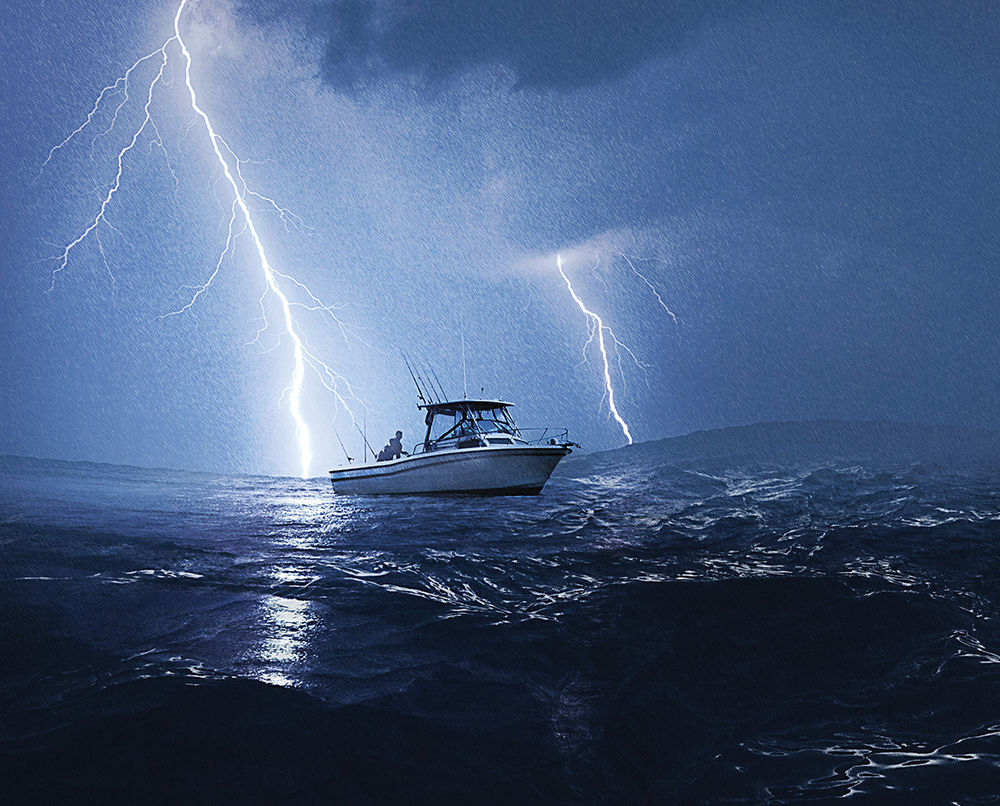
A strategy of boating only on sunny, cloudless days may work well in places like Idaho and California, but that would mean almost never using the boat in places such as Florida, Louisiana and much of New England where storms boil up and move in quickly on hot summer days. Boaters should track VHF, Internet and television weather reports and make responsible decisions about whether to go boating depending on the likelihood of storms. Short-term forecasts can actually be fairly good at predicting bigger storms, but small, localized storms might not be reported. This is when knowing how to read the weather yourself can come in handy.
Lightning strikes typically occur in the afternoon. A towering buildup of puffy, cotton-white clouds that rise to the customary flat “anvil” top is a good indication to clear the water and seek shelter — or move out of the storm’s path if possible. That’s if the storm is at least somewhat off in the distance (most storms are about 15 miles in diameter and can build to dangerous levels in fewer than 30 minutes). If lightning and thunder are present, just count the seconds between the lightning and corresponding thunder and then divide by 5 — this will provide a rough estimate of how many miles away the storm is.
A storm that builds directly overhead might be less obvious until those pretty white clouds that were providing some nice shade moments ago turn a threatening hue of gray as rain dumps on you and the wind starts to howl or, worse yet, boom with thunder and lightning that are right on top of each other. Now is the time for a mad dash to the dock and shelter if close by. Like the National Weather Service says: “When thunder roars, go indoors!” If out on open water or too far from shore and shelter, it’s time to hunker down and ride it out.
Even though getting caught in a storm is not always avoidable, there’s still plenty that boaters can do to minimize the chance of a strike and lessen injury and damage if there is a strike. We all learn in grade school that lightning seeks the highest point, and on the water that’s the top of the boat — typically a mast, antenna, Bimini top, fishing rod in a vertical rod holder or even the tallest person in an open boat. If possible, find a protected area out of the wind and drop anchor. If the boat has an enclosed cabin, people should be directed to go inside and stay well away from metal objects, electrical outlets and appliances (it’s a good idea to don life jackets too). Side flashes can jump from metal objects to other objects — even bodies — as they seek a path to water. Lowering antennas, towers, fishing rods and outriggers is also advised, unless they’re part of a designated lightning-protection system. Some boaters also like to disconnect the connections and power leads to their antennas and other electronics, which are often damaged or destroyed during a strike or near strike.
Under no circumstances should the VHF radio be used during an electrical storm unless it’s an emergency (handhelds are OK). Also, be careful not to grab two metal objects, like a metal steering wheel and metal railing — that can be a deadly spot to be if there’s a strike. Some boaters opt to steer with a wooden spoon and keep their other hand in a pocket if forced to man the helm during a storm, while others like to wear rubber gloves for insulation.
An open boat like a runabout is the most dangerous to human life, since you are the highest point and most likely to get hit if the boat is struck. If shore is out of reach, the advice is to drop anchor, remove all metal jewelry, put on life jackets and get low in the center of the boat. Definitely stay out of the water and stow the fishing rods. If all goes well, the storm will blow past or rain itself out in 20 to 30 minutes. It’s best to wait at least 30 minutes until after the last clap of thunder to resume activities.
Knowing what to do in a storm and having the best lightning-protection system installed on the boat is by no means a guarantee that lightning won’t strike. The immediate checklist for a direct hit is very short:
1. Check for unconscious or injured persons first. If they’re moving and breathing, they’ll likely be OK. Immediately begin CPR on unconscious victims if a pulse and/or breathing is absent — there’s no danger of being shocked by someone just struck by lightning.
2. In the meantime, have someone check the bilges for water. It’s rare, but lightning can blow out a transducer or through-hull — or even just blow a hole in the boat. Plug the hole, get the bilge pumps running, work the bail bucket or whatever it takes to stay afloat. An emergency call on the VHF is warranted if the situation is dire. If the radio is toast, break out the flare kit.
If there are no injuries and no holes or major leaks below, just continue to wait it out. Once the danger has passed, check the operation of the engine and all electronics. Even a near strike can fry electronics and an engine’s electronic control unit, cutting off navigation, communication and even propulsion. Some boaters stash charged handheld VHF and GPS units and a spare engine ECU in the microwave or a tin box for this very reason. These makeshift Faraday cages have saved equipment.
Obvious damage will need to be assessed and set right. Even those lucky enough to come away completely unscathed with no apparent damage should have a professional survey done just to be sure. Minor damage to through-hulls can result in slow leaks, and all manner of electrical wackiness can emerge — sometimes much later. It’s best to catch these issues right away and get that information to the insurance folks for coverage.
You can read the full article HERE .
- Share on Facebook
- Share on Twitter
- Share on Pinterest
- Share on Google+
- SAFETY TIPS
- SAFETY QUIZ

- Safety Tips
How to Survive Lightning Storms While Boating
- By Mike Telleria
- July 7, 2017

Powerful, dangerous, highly unpredictable — all are common descriptions of lightning storms. A direct strike that results only in ringing ears and a few roasted electronics would be considered lucky. Unlucky would be through-hulls blown out, a sunk boat or worse — possibly serious injury or death.
Many powerboaters like to think that they’ve got the speed to simply outrun or get out of the way of lightning storms, or they figure they’re safe if they go boating only when it’s clear and sunny. That’s an attitude aided by the low odds of a boat being struck by lightning, which BoatU.S. pegs at about one out of 1,000 boats in any given year. No worries, right, mate?
Wrong. Engines can malfunction; big lightning storms can leave no room to escape; sunny mornings can turn into dark, threatening afternoons. If yours is the only boat in the area during a lightning storm, the odds of being struck go way up, leaving you and your crew vulnerable to millions of volts raining down from the skies. While manufacturers can build in a degree of protection, lightning protection begins with boaters being informed and prepared to take action in the event of a thunderstorm or actual strike. You should know the following techniques and strategies.
Timing A strategy of boating only on sunny, cloudless days may work well in places like Idaho and California, but that would mean almost never using the boat in places such as Florida, Louisiana and much of the Midwest. For example, most of Florida — the Sunshine State — has at least 70 to 80 thunderstorm days per year, with some parts having more than 100 thunderstorm days per year (with increased activity during the summer months).
Absolutely, boaters should track VHF, Internet and television weather reports and make responsible decisions about whether to go boating depending on the likelihood of lightning storms. Short-term forecasts can actually be fairly good at predicting bigger storms, but small, localized storms might not be reported. This is when knowing how to read the weather yourself can come in handy. (The U.S. Power Squadrons offers great weather courses for boaters, and there are many books that cover the basics.)
Lightning strikes typically occur in the afternoon. (Florida estimates 70 percent occur between noon and 6 p.m.) A towering buildup of puffy, cotton-white clouds that rise to the customary flat “anvil” top is a good indication to clear the water and seek shelter — or move out of the storm’s path if possible. That’s if the storm is at least somewhat off in the distance (most storms are about 15 miles in diameter and can build to dangerous levels in fewer than 30 minutes). If lightning and thunder are present, just count the seconds between the lightning and corresponding thunder and then divide by 5 — this will provide a rough estimate of how many miles away the storm is.
A storm that builds directly overhead might be less obvious until those pretty white clouds that were providing some nice shade moments ago turn a threatening hue of gray as rain dumps on you and the wind starts to howl or, worse yet, boom with thunder and lightning that are right on top of each other. Now is the time for a mad dash to the dock and shelter if close by. Like the National Weather Service says: “When thunder roars, go indoors!” If out on open water or too far from shore and shelter, it’s time to hunker down and ride it out.
Caught! Boaters who have been struck by lightning often begin their stories with “I was caught in this storm … ” before they share their miraculous or harrowing tales of survival and destruction (BoatU.S. has a number of first-person storm stories archived online: boatus.com/seaworthy/swthunder). Even though getting caught in a storm is not always avoidable, there’s still plenty that boaters can do to minimize the chance of a strike and lessen injury and damage if there is a strike.
We all learn in grade school that lightning seeks the highest point, and on the water that’s the top of the boat — typically a mast, antenna, Bimini top, fishing rod in a vertical rod holder or even the tallest person in an open boat. If possible, find a protected area out of the wind and drop anchor. If the boat has an enclosed cabin, people should be directed to go inside and stay well away from metal objects, electrical outlets and appliances (it’s a good idea to don life jackets too). Side flashes can jump from metal objects to other objects — even bodies — as they seek a path to water.
Lowering antennas, towers, fishing rods and outriggers is also advised, unless they’re part of a designated lightning-protection system. Some boaters also like to disconnect the connections and power leads to their antennas and other electronics, which are often damaged or destroyed during a strike or near strike.
Under no circumstances should the VHF radio be used during an electrical storm unless it’s an emergency (handhelds are OK). Also, be careful not to grab two metal objects, like a metal steering wheel and metal railing — that can be a deadly spot to be if there’s a strike. Some boaters opt to steer with a wooden spoon and keep their other hand in a pocket if forced to man the helm during a storm, while others like to wear rubber gloves for insulation.
An open boat like a runabout is the most dangerous to human life during lightning storms, since you are the highest point and most likely to get hit if the boat is struck. If shore is out of reach, the advice is to drop anchor, remove all metal jewelry, put on life jackets and get low in the center of the boat. Definitely stay out of the water and stow the fishing rods.
If all goes well, the storm will blow past or rain itself out in 20 to 30 minutes. It’s best to wait at least 30 minutes until after the last clap of thunder to resume activities.
Hit! Knowing what to do in a storm and having the best lightning-protection system installed on the boat is by no means a guarantee that lightning won’t strike. The immediate checklist for a direct hit is very short:
1. Check for unconscious or injured persons first. If they’re moving and breathing, they’ll likely be OK. Immediately begin CPR on unconscious victims if a pulse and/or breathing is absent — there’s no danger of being shocked by someone just struck by lightning.
2. In the meantime, have someone check the bilges for water. It’s rare, but lightning can blow out a transducer or through-hull — or even just blow a hole in the boat. Plug the hole, get the bilge pumps running, work the bail bucket — whatever it takes to stay afloat. An emergency call on the VHF is warranted if the situation is dire. If the radio is toast, break out the flare kit.
If there are no injuries and no holes or major leaks below, just continue to wait it out. Once the danger has passed, check the operation of the engine and all electronics. Even a near strike can fry electronics and an engine’s electronic control unit, cutting off navigation, communication and even propulsion. Some boaters stash charged handheld VHF and GPS units and a spare engine ECU in the microwave or a tin box for this very reason. These makeshift Faraday cages have saved equipment.
Obvious damage will need to be assessed and set right. Even those lucky enough to come away completely unscathed after lighting storms, with no apparent damage should have a professional survey done just to be sure. Minor damage to through-hulls can result in slow leaks, and all manner of electrical wackiness can emerge — sometimes much later. It’s best to catch these issues right away and get that information to the insurance folks for coverage.
Write the Check! On many levels, robust insurance coverage plays a huge role in your lightning-protection plan. Knowing how to avoid lighting storms and read the weather are certainly important, being ready for action in the event of a storm or strike is crucial, and an upfront investment in lightning protection can lessen destruction. When it comes to dealing with the aftermath of a damaging strike, however, extensive lightning strike coverage can’t be beat.
Take it from a luxury trawler owner who sustained more than $1 million in damage from a strike: “Boat insurance turns out to be the best investment we have made in the past 10 years!” he said. “We will never again grumble about writing a check for an insurance premium.”
The U.S. Coast Guard is asking all boat owners and operators to help reduce fatalities, injuries, property damage, and associated healthcare costs related to recreational boating accidents by taking personal responsibility for their own safety and the safety of their passengers. Essential steps include: wearing a life jacket at all times and requiring passengers to do the same; never boating under the influence (BUI); successfully completing a boating safety course; and getting a Vessel Safety Check (VSC) annually from local U.S. Coast Guard Auxiliary, United States Power Squadrons(r), or your state boating agency’s Vessel Examiners. The U.S. Coast Guard reminds all boaters to “Boat Responsibly!” For more tips on boating safety, visit www.uscgboating.org .
- More: Boating Safety , Emergency Procedures , Safety Tips
- More Safety Tips

Safe Boating Tips for Rental Customers

What’s the Difference Between a Life Jacket and a PFD?
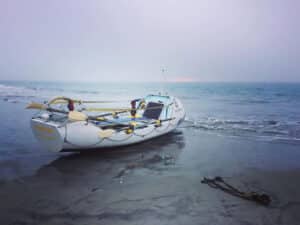
The Pocket-Sized Beacon That Could Save Your Life

A Boating Dad’s Guide To Navigation

PWC Safety Tips

Emergency Cut-Off Switch Link Requirements and Options
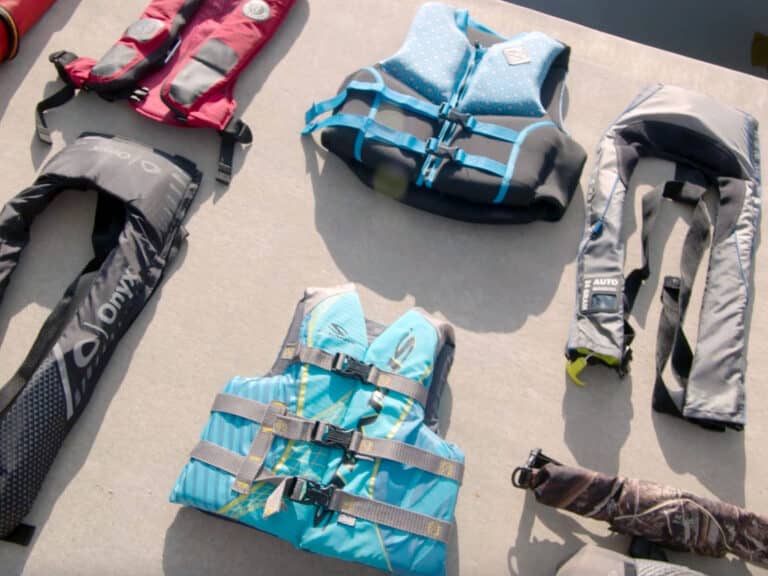
Inflatable Life Jackets: Styles and How They Work
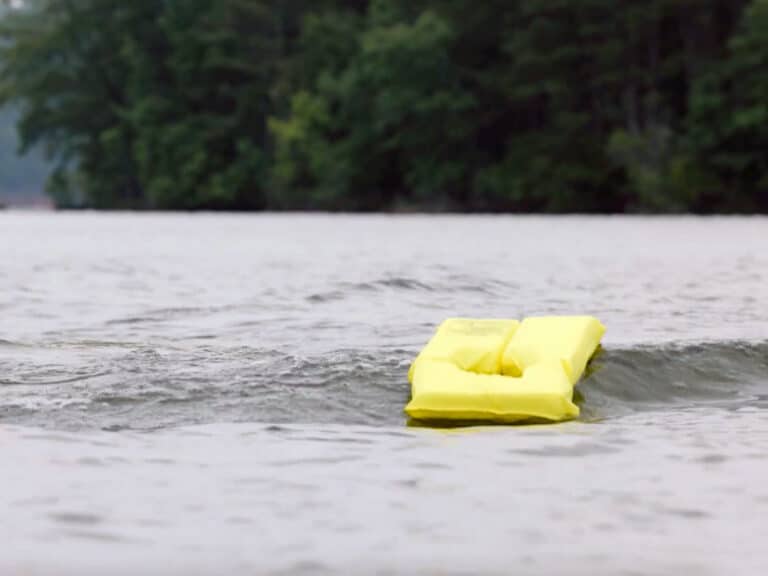
Penny Wise, Lifetime Foolish
- Privacy Policy
- Safety Quiz
- Cruising World
- Sailing World
- Salt Water Sportsman
- Sport Fishing
- Wakeboarding

Complete Guide to Storm Sails

Last Updated by
Daniel Wade
June 15, 2022
Storm sails are popular safety measures that help you retain control of your boat in high winds. They also reduce the risk of knockdown.
In this article, we'll cover the most common types of storm sails and their uses. Additionally, we'll go over storm sail materials, cost, sizing, and tips from the sailing community. You'll also learn when (and how) to deploy storm sails at sea.
Storm sails are durable and compact sails designed for use in rough weather. They're smaller than regular mainsails and headsails. The most common kinds of storm sails are the trysail and the storm jib. Storm sails can be deployed alone or in pairs.
The information contained in this article was sourced from expert sailors and storm sail manufacturers. Additionally, we sourced technical specifications from reviewers and users of storm sails.
Table of contents
What are Storm Sails?
Storm sails are small and durable headsails and mainsails designed for use in rough weather. They are a fraction of the size of typical mainsails and headsails, and they attach to the vessel using a multi-point tie system.
Storm sails are almost always triangular regardless of what kind of vessel they're deployed on, which includes storm sails designed for gaff-rigged sailboats. This is because a three-pointed sail is durable and easy to deploy at the base of the mast. Three connection points are easier to deal with than four, and storm sails don't require the use of top spars.
Storm sails are typically bright orange in color to distinguish them from other canvas aboard the vessel. Additionally, high visibility material makes it easier to see the boat in dangerous conditions. This is especially useful in emergencies, and it helps avoid collisions with other vessels.
Storm sails are stronger than the rest of the sails aboard most vessels. They are designed to stand up against gale-force winds and heavy ocean spray. Most storm sails can be deployed rapidly without completely removing the mainsail or headsail.
How do Storm Sails Work?
The concept and function of a storm sail is simple. A storm sail is essentially just a reefed version of your headsail or mainsail. Storm sails provide propulsion in high winds, which is essential if you want to keep control of the boat.
Storm sails are useful because they are smaller than the smallest configuration of your typical sail setup. In other words, they give you a smaller sail plan than you could have achieved by reefing. During dangerous storm conditions, this could be the difference between a controllable boat and a knockdown.
Types of Storm Sails
Most vessels that carry storm sails have one for the forward sail plan and one for the after sail plan. This typically includes a trysail for replacing the mainsail and a storm jib for replacing the headsail. In some cases, vessels opt to carry only a single storm sail as an easy precautionary measure.
Vessels that only carry a single storm sail generally opt for a storm jib, as it can be easier and safer to rely on a headsail during foul weather conditions. Additionally, it frees up the mainsail for precise adjustments, as it's easier to reef and trim from the cockpit. The downside of carrying only a storm jib is that it requires someone to trek to the bow of the boat during hazardous conditions.
In addition to trysails and storm jibs, there are many sub-varieties of storm sails available today. Next, we'll cover a few of the most popular storm sail types and their intended uses.
Basic Storm Sails for Emergencies
Basic no-frills storm sails are available for typical cruising boats to use in emergencies. These simple, often brightly colored Dacron sails are easy to rig and compact for long-term storage. They are triangular and often flat, which makes them ideal for quick deployment.
They are the most affordable type of storm sail and often considered 'universal fit' for boats within a certain size range. In other words, you probably won't have to custom-order a basic storm sail setup for your production fiberglass cruising sloop.
Basic storm sails often come in a convenient and weatherproof storage box that's clearly marked for stowing with your other emergency gear. These are not the most efficient or durable storm sails available, but they're strong enough to improve your chances in a dangerous situation.
Racing Storm Sails
Storm sails have found a unique niche amongst some offshore racing sailors. Vessels that participate in offshore regattas in foul weather often rely on them to achieve high speeds. This is especially true in conditions that are too hazardous to deploy a standard sail plan.
There are not a whole lot of purpose-built storm sails for racing. However, many sailors who participated in ocean races choose higher-quality and more controllable storm sails. That said, ocean racers often choose storm sails with unique shapes and characteristics.
Racing storm sails are usually slightly larger than basic emergency storm sails. They often have a deeper reef and longer leech, which increases the size of the canvas and brings it closer to the deck. Additionally, these characteristics make the small sail more efficient and allow the vessel to reach higher speeds while retaining precise control.
Racing storm sails are often reinforced in key areas, which is done at the factory or after the fact by the owner. This is because they're more likely to be deployed more than once and left on extended periods. Sometimes, Racers opt to delete unreliable quick-rig features that are found on standard storm sails.
Custom Storm Sails
There are many reasons why a sailor might choose to have a custom storm sail produced. As far as cost is concerned, it's comparable to a typical custom sailmaking job. Custom storm sails can be made with unique dimensions to optimize their efficiency on a specific hull design.
Custom storm sails are sometimes produced with higher-quality materials than consumer models, which gives sailors additional peace of mind. In many cases, the unique design of some sailboats requires purpose-built storm sails.
Most sailmakers will produce storm sails upon request. However, you may have to provide additional specifications ahead of time. They can also reinforce consumer storm sails using high-quality material or make adjustments to provide a better fit for your boat.
What are Storm Sails Made Of?
Storm sails need to be strong and weather-resistant. Additionally, they need to survive long periods of storage in less-than-ideal conditions, such as in the bilge or under a deck hatch.
Modern sale materials such as Kevlar and laminates are strong, but they don't always perform well in long-term storage. As a result, storm sails are typically made with a thick sheet of good old Dacron.
Dacron is a popular type of polyester sail fabric that's found in all kinds of sailboats. The primary difference between a Dacron storm sails and run-of-the-mill sail fabric is color and thickness.
When to Use a Storm Sail
What sort of conditions warrant the use of a storm sail? This varies between boats, and also between captains and crews. But generally speaking, storm sails can be deployed in high-wind conditions when typical reefing and adjustments aren't enough.
The precise wind speed that causes you to deploy storm sail is impossible to predict without knowing your specific vessel's handling characteristics. However, storm sails are sometimes found in winds exceeding 30 or 40 knots.
If a knockdown is imminent, the best course of action is most likely maneuvering. It will be very difficult to rig a storm sail when the vessel is at extreme risk of being blown over. It's best to rig a storm sail when the boat is still under control, either by you or someone else.
How to Rig a Trysail
Storm sails rig up similarly to your regular sails. Precise installation instructions vary between boats and sail models, but you can expect to install them roughly the same way.
The luff and tack of the main storm sail (trysail) typically rig up using sheets to the spinnaker blocks on the mast. The storm sail sheet runs to a block on the deck and then to a winch, similarly to how a jib sheet would run.
How to Rig a Storm Jib
The storm headsail, or storm jib, rig up using an inner forestay or halyard. The storm jib is hanked on, and the jib sheet runs to block and winch on the deck. The storm sheet typically follows the same route as a regular job sheet.
Are Storm Sails Required?
Some sailors believe that the Coast Guard requires storm sails aboard all sailboats. This is not the case, as the USCG doesn't list storm sails on its roster of mandatory safety gear . The majority of sailboats don't (and probably won't ever) have a storm sail aboard.
While storm sails are not a legal requirement aboard sailboats, there are situations where sailors must carry them. Ocean races are an example of one such situation, as many offshore regattas mandate them. This is especially true in Northern latitudes, where rough weather and gale-force winds are commonplace. Most of these organizations don't require sailors to use them; they just require sailors to have them.
How Much do Storm Sails Cost?
Storm sails are typically affordable, at least compared to other emergency gear, such as automatically inflating lifeboats. Storm sail prices vary based on material quality, thickness, and size. Below, we'll cover the price and specifications of a typical storm sail as an example.
Our example model from National Sail and costs $640 . It's a conventional hank-on storm jib, which is the most common type. It has a luff of 28 inches, a leech of 22.5 inches, and a foot of 11.9 inches. It has an overall weight of 9 pounds. Based on its size, this model is designed for a boat around 40 to 50 feet in length.
As you can see, storm sails are relatively affordable, even for large boats. The prices you can expect to pay for a typical 30-foot cruising vessel are between $200 and $350, depending on the quality and thickness of the cloth.
Storm Sail Sizes
It's essential to find the right size storm sail for your boat. Storm sails vary in both dimensions and fabric weight (or material thickness). Most storm sail manufacturers produce trysails and storm jibs for vessels between 20 and 60 feet in length.
Are Storm Sails Necessary for Offshore Cruising?
The debate about the necessity of storm sails has been raging for years. The jury is still out whether sailors should keep one aboard. Some people swear by them, and others dismiss them as a needless complication when reefing and handling would suffice.
It comes down to your personal experience and judgment. Storm sails work, and there are many instances where they've been deployed and likely helped save vessels from knockdown or foundering.
That said, sailors rightfully note that they can be very difficult (and even dangerous) to deploy during storm conditions when captain and crew effort would be more useful trying to handle the vessel.
Storm Sail Use and Preparation
It's essential to practice with storm sails in windy conditions before relying on them in truly dangerous situations. Go out on a windy day and practice deploying and controlling your storm sails. Put a plan in place to get them up quickly and safely.
Make sure to wear a life jacket and harness when deploying storm sails or moving around the boat in rough weather. Ensure that you have a place to attach your harness along the way, especially in areas that you need to stand to rig your storm sails.
Also, make sure to find harness attachment points on both sides of the mast, as you never know what side the boat will be heeling when you need to deploy your storm sails. Once you're confident that you can deploy and control your storm sails quickly and safely, you'll be ready to rely on them as an additional safety measure in rough weather.
Should I Buy Storm Sails?
So, should you buy a set of storm sails? Again, the answer depends on your location, sailing conditions, and personal experience. If you live in an area where rough weather is common or if you intend to embark on an offshore race, it's worth considering a set of storm sails. For the price, storm sails are a cheap insurance policy for hazardous weather.
Related Articles
I've personally had thousands of questions about sailing and sailboats over the years. As I learn and experience sailing, and the community, I share the answers that work and make sense to me, here on Life of Sailing.
by this author
Most Recent

What Does "Sailing By The Lee" Mean?
October 3, 2023

The Best Sailing Schools And Programs: Reviews & Ratings
September 26, 2023
Important Legal Info
Lifeofsailing.com is a participant in the Amazon Services LLC Associates Program, an affiliate advertising program designed to provide a means for sites to earn advertising fees by advertising and linking to Amazon. This site also participates in other affiliate programs and is compensated for referring traffic and business to these companies.
Similar Posts

How To Choose The Right Sailing Instructor
August 16, 2023

Cost To Sail Around The World
May 16, 2023

Small Sailboat Sizes: A Complete Guide
October 30, 2022
Popular Posts

Best Liveaboard Catamaran Sailboats
December 28, 2023

Can a Novice Sail Around the World?
Elizabeth O'Malley

4 Best Electric Outboard Motors

How Long Did It Take The Vikings To Sail To England?

10 Best Sailboat Brands (And Why)
December 20, 2023

7 Best Places To Liveaboard A Sailboat
Get the best sailing content.
Top Rated Posts
Lifeofsailing.com is a participant in the Amazon Services LLC Associates Program, an affiliate advertising program designed to provide a means for sites to earn advertising fees by advertising and linking to Amazon. This site also participates in other affiliate programs and is compensated for referring traffic and business to these companies. (866) 342-SAIL
© 2024 Life of Sailing Email: [email protected] Address: 11816 Inwood Rd #3024 Dallas, TX 75244 Disclaimer Privacy Policy
Best Plunderstorm Skills for a Solo Victory in Patch 10.2.6
Best offensive skills for plunderstorm, storm archon, holy shield, best utility skills for plunderstorm, steel traps, fade to shadow, quaking leap, best skill combos for plunderstorm, best offensive skill combos for plunderstorm.
- Fire Whirl + Rime Arrow
- Fire Whirl + Storm Archon
- Fire Whirl + Holy Shield
Best Utility Skill Combos for Plunderstorm
- Steel Traps + Fade to Shadow
- Steel Traps + Quaking Leap
- Steel Traps + Repel
- Repel + Quaking Leap
- Repel + Fade to Shadow
- Fade to Shadow + Windstorm
- Quaking Leap + Windstorm
- Repel + Windstorm
Comment by papatranq
Comment by tsuyoiayakashi.
cringe to support meta gaming, I would delete this article and write no more like it !
Comment by Daemer
min maxing a limited time event that isn't even yet available worldwide, the community is a clownfest
Comment by Kryonyx
Can't wait for the wowhead weekly "BIS Plunderstorm Abilities" list.
Comment by Gleem
Oh my god, gamers, notorious for optimizing the fun out of video games, have once again optimized the fun out of a video game. Who could have predicted this? Seriously though, the difference in quality between powers isn't even close. I literally had this exact setup by my third match, it was so obvious. The power imbalance is such that not playing optimally is a pretty huge disadvantage, lol. But yeah, if you guys don't want to play online games with min/maxers, sadly your only real choice is to... not play online games.
Comment by duffdog7576
Should write an article about controller player and how this is the beginning of WoW on consoles. Swear this is how the game is going to exist in the future.
Comment by Malruned
I just got my first win with a rank 4 fire whirl, it let me get so many double kills by jumping people busy dueling. Will probably be nerfed but hey I got the achievement, exploit early and often boys.
Comment by SinR
Can't wait for the wowhead weekly "BIS Plunderstorm Abilities" list. Coming Soon: WoWHead Article showing the coolest 1v1 victories. and the same article the next week. and the week after that. And that. AND THEN ANOTHER ONE THE NEXT WEEK. Gotta get that Ad Revenue somehow :)
Comment by HeBeard
min maxing a limited time event that isn't even yet available worldwide, the community is a clownfest The rep is a huge grind and winning gives substantially more than placing even close to top.
Comment by Vyvian
Is it really necessary to min/max day 1 of a casual event?
Comment by Kalados
whining in these comments is unbelievable and hilarious, touch grass, i'm having a blast. Skill issue
Comment by BustingBrig
I'm going to wait until the increase the reputation earned on these events. It's not fun to wait for the game to start to only get bad RNG and get killed by someone else who got the good ability. There needs to be a minimum reward payout to those who participate.
Comment by WolfQueen
min maxing a limited time event that isn't even yet available worldwide, the community is a clownfest The rep is a huge grind and winning gives substantially more than placing even close to top. This. I've been at it for 2 hours now and barely out of Renown 3.
Comment by leeroy1010
Comment by razz0r65.
min maxing a limited time event that isn't even yet available worldwide, the community is a clownfest What did you expect? This is how it's been since TBC, only reason we did not do it earlier is cause of lack of info classic is evidence of that get used to it or leave for another game. This game will always be min maxed to high hell, all this constant &*!@#ing about min maxing or add-ons or whatever. Just quit playing it's never ever going away just constant moaning go out touch some grass. Or don't just accept the game is not for you and move on with your life
Comment by takasinners
Predictable.
min maxing a limited time event that isn't even yet available worldwide, the community is a clownfest The rep is a huge grind and winning gives substantially more than placing even close to top. I can get around 500 rep with a pretty efficient spawn as long as there's no competition (something that's... surprisingly easy to do). I can hit 500 rep in about 3 minutes. If I push through the rest of the match which can take a while (people hide until the last minute when there's nowhere to go), I'll get around 800 rep. It's FAR easier to intentionally throw after you blitz collecting gold, and it's way more time efficient. You leave after about 3 minutes and re-queue (another 2 minutes), getting around 1k per 10 minutes of farming, vs trying to win which it itself can cost over 10 minutes not including re-queues, and you likely won't get 1k rep for it. It's legit faster to play this event as a pve speedrun than it is to treat it as a pvp battle royal.
Comment by Razzileth
Putting renown into this was probably a mistake especially since they made it an oldschool blizzard grind.
Comment by Kerathras
min maxing a limited time event that isn't even yet available worldwide, the community is a clownfest The rep is a huge grind and winning gives substantially more than placing even close to top. This. I've been at it for 2 hours now and barely out of Renown 3. Oh geez, so we’re looking at something like 40 hours? If you do this for 2 hours a day that’s 3 weeks! Count me out, lol!
Comment by Oritaku77
Here is a build I went with: - lvl 10 by the end of it - Rime Arrow (lvl 4) - Divine Shield (lvl 1); if I had it higher level it would've been even smoother - That pulsing AoE frost ability around you (lvl 4) - The Blink+Vanish ability (lvl 4) - For utility I had was one of them camouflaged stealth bushes. If I found a motorcycle I would drop the bush, spawn the bike, then grab the bush to again to hold onto it. Same with other disposables like summoning a parrot to fight alongside you. IMO, a decent strat is to acquire levels quickly to outpace other players. Focus on clearing elite and normal NPCs and opening treasures. Avoid big fights unless you're at least 2 levels above your enemies. If it's a 1v1 try and be equal level at least. You'll also need to get lucky and find a good combo of abilities to use and then level it all up. Easier said than done, of course. The build I won with had just about all I needed at the moment. Spamming Rime Arrow on cooldown chips away HP at range. Followed up by the Divine Shield's explosion does good damage. Frost AoE if in a melee scuffle and vanish out when you see the enemy waste a cooldown like Fire Whirl. Played safe. As for the Stealth Bush, I got toward the middle of where the storm was approaching toward the final minute of the game and used it on top of some others. I was impossible to notice. Although, it was really luck on my side. The storm closed on the golden large altar within Stormgarde toward the main garrison. Everyone had to enter the city from the eastern gate and loop around through the storm to get there. I did so first before anyone else and that essentially is what sealed my win. Anyone around me trying to evade the storm I'd hit with an ability then ensure I broke line of sight by stealthing. So I waited in stealth and... a lvl 3 tauren shows up. It's me, lvl 10, versus a lvl 3 that was seeking to win by attrition. Turned 'em into a pile hamburger and got the W.
In mere seconds, an NJ home went from livable to a flooded mess. A boat rescued the family

Jodi Klein, a Delran mother of two, was relaxing in bed around midnight on Jan. 9. She had just finished packing for a trip to Mexico the following day, when Mother Nature had a different plan for her.
A storm-triggered tidal flood took over her house in a matter of seconds.
Instead of taking a plane to Mexico, Klein had to board a rescue boat along with her daughter, her wheelchair-bound son, and their three dogs.
“Like a waterfall. That's what it sounded like. Like a waterfall behind my head,” Klein remembered.
“I laid down finally after packing at 11 o'clock and I heard the water start rushing in my crawlspace so I jumped back up, put the sump pump on and started running,” she said.
She called 9-1-1 and rushed to save important things by placing them on top of high tables and furniture.
A lot of water rushed in fast. Up to 5 feet of water entered her home’s crawl space, around 4 inches on the house’s first floor, and some 36 inches in the backyard.
The inundation rendered Klein’s house inhabitable. And her two vehicles, including a wheelchair-accessible van, were totaled.
“I’m in big trouble. I’m in big, big trouble,” she said.
Without a place to stay, Klein had to stay in a hotel while she could find a house she could rent temporarily. With a car she borrowed from a friend, she dropped off and picked up her son at the school bus stop.
After a week looking, Klein found an Airbnb rental that allows dogs with wheelchair accessiblilty. The rental cost $3,000 a month, and she is paying for it out-of-pocket and with the donations she has gotten from a fundraiser through GoFundMe .
“It's a mess. It's really a mess. Nobody in my township has been able to provide any resources to help me, so I've been paying out of pocket,” she said.
Klein's house in Delran sits where the Delaware River and the Rancocas Creek meet, an area known for recurrent coastal flooding.
“It's been an ongoing issue over the years with flooding sometimes, but never like this,” said Klein, who has lived in the same place for 25 years.
The flooding on the night of Jan. 9 was worse than Hurricane Sandy flooding. It actually broke the record for how high it rose, the township confirmed.
Delran Mayor Gary Catrambone said the township coordinated with the Community Emergency Response Teams and the Red Cross to provide assistance with clean up and counseling residents on available resources. The Red Cross, for instance, has offered temporary housing to those displaced by the flood.
The Federal Emergency Management Agency reached out to the township offering to buy some of the properties in areas were the flooding issue is expected to persist, Catrambone said.
Families in Delran who need assistance with their insurance or requesting federal help can reach out to the township.
Why are floods common in Delran?
"There were a number of issues there. There is no easy fix, or we would have done it already," Catrambone said.
Delran got its name from a combination of Delaware River and Rancocas Creek, both waterways that meet up in the municipality. Besides those waterways, there are underground aquifers, some at an underground height that surpasses the bottom of home basements.
On top of that, the Delaware river is tidal, meaning that its level is responsive to the ocean tide. When it rains, the river crests as any other river would normally do.
But "(If the river) crests at the time when the tide is high, that's when we have these problems," Catrambone said.
More: Jersey Shore expected to have more high tide flooding days this winter
Years ago, a berm was built to mitigate water runoff, but it wasn't enough. Now, the township is finalizing a contract with the U.S. Army Corps of Engineers, a federal agency the township believes capable of fixing the problem.
But some residents just don't want to be around water anymore. While looking for an Airbnb, Klein made sure none was close to a body of water.
“I don’t want to be anywhere near water,” she said.
Carnival Cruise ship catches fire after possible lightning strike
The cruise line said damage to the ship is "more than we first thought" and will require immediate repair to stabilize the funnel. cruises scheduled to depart from port canaveral on march 25th and march 29th have been canceled..
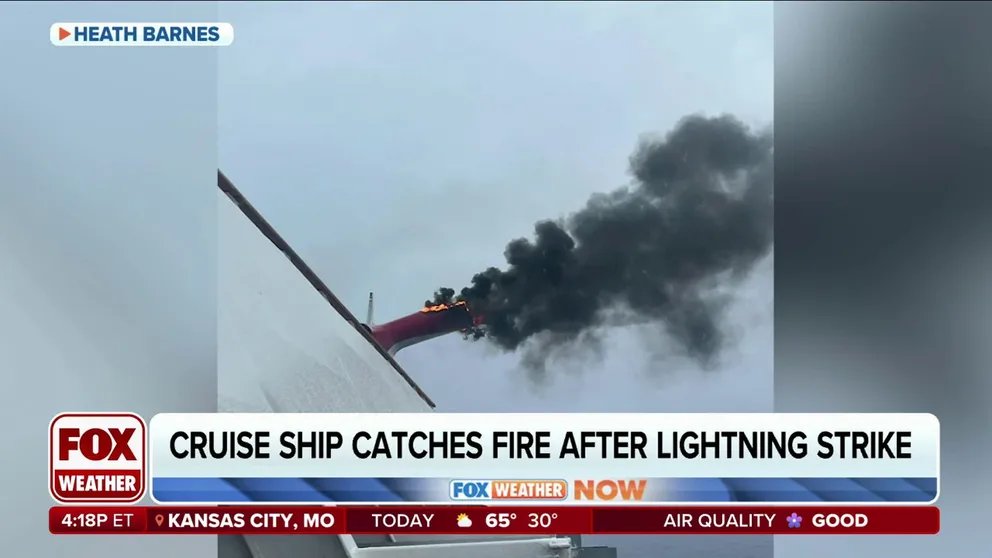
Heath Barnes was a passenger on the Carnival Freedom ship when the boat's exhaust funnel caught fire during a thunderstorm. The ship is back at Port Canaveral for repairs.
PORT CANAVERAL, Fla. – The Carnival Freedom ship caught fire Saturday near the Bahamas after passengers reported a lightning strike on the boat during a thunderstorm .
Carnival Cruise Line said the crew reported a fire on the port side of the ship's exhaust funnel around 3:15 p.m. Saturday. The ship was 20 miles off Eleuthera Island in the Bahamas, sailing to Freeport after being unable to dock at Princess Cay due to weather conditions.
"Our onboard team acted quickly to contain and put out the fire," Carnival Cruise Line said. "While we continue to investigate multiple eyewitness reports of a lightning strike, our technical team completed a thorough assessment during the ship’s visit to Freeport on Sunday."
LIGHTNING FATALITIES WERE SECOND LOWEST ON RECORD IN 2023, SAFETY COUNCIL SAYS
Around the time of the fire, radar showed a storm cell over the area and a lot of lightning activity.
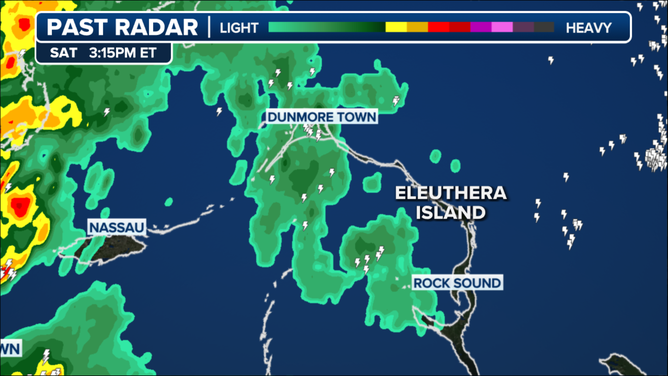
Radar at 3:15 p.m. on March 23 when a Carnival Cruise ship was possibly hit by lightning.
(FOX Weather)
Multiple passenger videos show flames and dark smoke billowing from the exhaust funnel as rain continues to pour onto the deck.
Passenger Heath Barnes said the ship was supposed to dock at Princess Cay on Saturday about 9 a.m., but passengers were told that the boat would continue to Freeport due to strong winds .
During the afternoon, the rain returned, and passengers reported hearing loud thunder and then seeing the smoke. Soon after, guests were told to remain in their cabins.

Smoke and flames coming from the exhaust funnel of the Carnival Freedom cruise ship on Saturday, March 23, 2024.
(@breezebreeze_ via Storyful)
"Why is our tail on fire?" someone can be heard saying in the video recorded by Barnes. "That's not good, y'all."
On Monday, Carnival Freedom returned to Port Canaveral , where guests disembarked.
The cruise line said damage to the ship is "more than we first thought" and will require immediate repair to stabilize the funnel. Cruises scheduled to depart from Port Canaveral on March 25th and March 29th have been canceled. All guests on the canceled trips will receive a full refund and a 100% future cruise credit.
FOX Business reported that the same cruise ship caught on fire in 2022 after being struck by lightning.
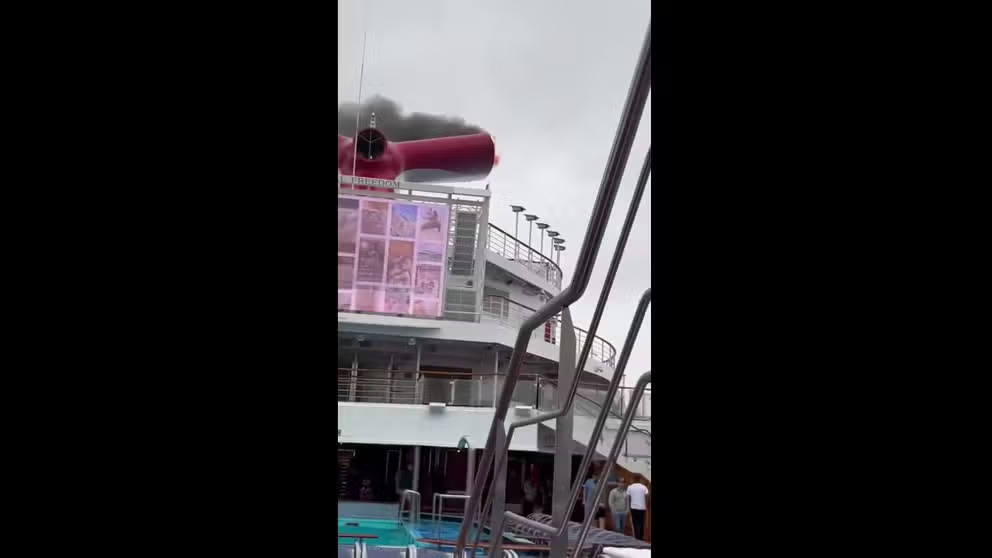
Carnival Freedom cruise ship on fire
Video shows smoke and flames coming from the Carnival Freedom exhaust funnel on Saturday after a possible lightning strike. (video credit: Credit: @breezebreeze_ via Storyful)
Another video recorded on Saturday by X user @breezebreeze showed the fire on the ship.
"Carnival Freedom on fire AGAIN!!" they wrote on X.
- Extreme Weather
- Thunderstorms
Disappointing photos show what it's actually like to go on a cruise
- I took a seven-day voyage on one of the largest cruise ships in the world , my first cruise ever.
- I found the reality of cruising didn't match my expectations from social media and promotional ads.
- I spent much of my time battling crowds, waiting in lines, and sitting on hot tour buses.

I booked my first-ever cruise aboard Royal Caribbean's Wonder of the Seas in April 2022. The seven-day Caribbean voyage on a mega-ship took me round-trip from Fort Lauderdale, Florida, to port stops in Honduras, Mexico, and the Bahamas. I expected breathtaking views of the world between relaxing swimming and sunbathing sessions.
But my experience didn't quite meet my expectations.
Instead, I sunbathed in a loud, crowded pool area when I was lucky enough to find a chair. I spent more time waiting in lines than I had anticipated, and I saw much of the world from behind other people's heads.
Here's an overview of the most disappointing aspects of my cruise, from getting to the port to sailing across the region
The disappointment started before I was even on the cruise.
Since I don't live near my cruise's departure city, my trip began with a flight and a budget hotel room near my departure port in Fort Lauderdale, Florida.
When I arrived at my port city's airport, I waited 45 minutes for a hotel shuttle to pick me up.
This was the first of many crowded bus rides during my trip. Looking back, I wish I had called a cab — especially since the next morning, I piled into a hot bus with several other cruise guests as I headed to the port.
There was a long line to get inside the cruise terminal, and I should have known by this point that I'd stand in many more lines during my cruise.
Inside the cruise terminal , there was another long line to get through security. While I waited, I chuckled to myself as I read signs that said, "Adventure begins here."
Once aboard the ship, I was excited to view the ocean as we sailed away, but I was blocked by tall, thick glass and couldn't find a place to stand.
My obstructed view of the ship leaving Fort Lauderdale made me feel as frustrated as standing behind tall patrons at a concert.
The ship was so large that I got lost several times during my stay.
But I found the maps on each floor to be helpful.
As I explored the ship, I was surprised that even a mega-ship could feel overcrowded.
While people seemed to enjoy themselves, many communal decks looked and felt like crowded malls.
The outdoor decks had 19 pools, plunge pools, and whirlpools accessible to guests. These spaces were crowded throughout the day. And even though there were rules against saving chairs with towels, I saw plenty of people doing it, so finding a spot to relax was stressful.
A Royal Caribbean representative told Business Insider crew members might remove items from lounge chairs after 30 minutes. Still, they must also consider families and groups who may be in the pool or going to the restroom when enforcing rules like these and must use their best judgment.
There were crowds and lines virtually everywhere I went.
From the buffet to activities like water slides and mini-golf, I felt like I spent more time waiting in line than enjoying the ship. For example, I waited in line for three hours to play a round of laser tag that was less than 20 minutes long.
At port stops, I waited in lines to go through security every time I left and returned to the ship. I found this less annoying than the other wait times since it made me feel safer.
The lines continued at each port, crowded with others excited to begin their tours.
I often had to battle through crowds just to find signs for my excursions.
It was exciting to explore new places at each stop, though some of this exploration was from the window of another hot bus.
A Royal Caribbean representative told BI the cruise line worked with local tour operators for its excursions, so air conditioning standards varied.
And when I was finally doing the cool thing I booked, like walking across a suspension bridge amid the treetops, my view was sometimes blocked once more by everyone else who booked the tour, too.
I hoped to capture an empty image of this majestic jungle bridge, but it wasn't possible without losing my tour crew.
According to a crew member I overheard, roughly 5,000 other people were aboard the ship, so I understand why the cruise felt so crowded.
I think that if I were to book a less crowded cruise next time, I might enjoy it more.
- Main content

- Newsletters
WEATHER ALERT
A special weather statement and a wind advisory in effect for Buchanan and Grayson Regions
Philippines lodges its 'strongest protest' against china over a water cannon assault in disputed sea.
By Jim Gomez
Associated Press
MANILA – The Philippines lodged its “strongest protest” against Beijing on Monday and summoned a senior Chinese diplomat over a water cannon assault by the Chinese coast guard that injured Filipino navy crew members and heavily damaged their boat in the disputed South China Sea, officials said.
In response, China warned that relations were at a crossroads and the Philippines should choose a prudent path forward.
Recommended Videos
Two Chinese coast guard ships hit a Philippine navy-operated supply boat with water cannons Saturday in the latest and most serious confrontation between the rival Asian claimants near the disputed Second Thomas Shoal , which is surrounded by Chinese vessels in a bid to dislodge Philippine forces from there.
The repeated high-seas confrontations since last year have sparked fears of a larger conflict that could put China and the United States on a collision course. . The U.S. has warned repeatedly that it’s obligated to defend the Philippines — its oldest treaty ally in Asia — if Filipino forces, ships or aircraft come under an armed attack, including in the South China Sea.
The United States, the European Union, Japan, Australia and about 16 other countries have expressed support to the Philippines and the rule of law, according to the Department of Foreign Affairs in Manila.
China accused Philippine vessels of “intruding” into Chinese waters. Foreign Ministry spokesperson Lin Jian said that the actions of the Chinese coast guard were “legitimate, professional and restrained” and that China would "continue to take resolute measures to safeguard its territorial sovereignty and maritime rights and interests.”
The Chinese Embassy in Manila issued a statement by the Chinese coast guard that warned the Philippines against “playing with fire."
Philippine Foreign Undersecretary Theresa Lazaro in a phone call with her Chinese counterpart expressed “the Philippines’ strongest protest against the aggressive actions undertaken by the China coast guard and Chinese maritime militia against the rotation and resupply mission undertaken by the Philippines,” the Department of Foreign Affairs said in a statement.
Chinese Vice Foreign Minister Chen Xiaodong told Lazaro that relations between their countries are at a crossroads and that the Philippines must act prudently in deciding which path to follow, a statement from the Chinese side said.
He accused the Philippines of provoking incidents at Second Thomas Shoal and attempting to transport supplies without China’s permission to an illegally beached ship in a bid to achieve long-term occupation of the reef, the statement said.
The Philippines separately summoned a senior Chinese diplomat in Manila to convey its protest and demand that Chinese ships immediately leave the waters around Second Thomas Shoal, which lies in the Philippines’ exclusive economic zone, and for China to stop violating international law.
Philippine defense, security and foreign affairs officials convened a meeting Monday to discuss new steps to deal with what they say is China’s unacceptable and provocative actions in the South China Sea. Their recommendations would be submitted to President Ferdinand Marcos Jr. and were not immediately released to the public.
Second Thomas Shoal has been occupied by a small contingent of Philippine navy and marines on a marooned warship since 1999, but has been surrounded by Chinese coast guard and other vessels in an increasingly tense standoff. It’s the second time the Philippine supply boat has been damaged by water cannon in March.
The U.S. lays no claims to the busy seaway, a key global trade route, but has deployed Navy ships and fighter jets in what it calls freedom of navigation operations that have challenged China's claims to virtually the entire South China Sea. Beijing says the strengthening of U.S. alliances in Asia, including with the Philippines, is aimed at containing China and threatens regional stability.
Aside from China and the Philippines, Vietnam, Malaysia, Taiwan and Brunei also have overlapping claims in the resource-rich and busy waterway. Beijing has refused to recognize a 2016 international arbitration ruling that invalidated its expansive claims on historical grounds.
Copyright 2024 The Associated Press. All rights reserved. This material may not be published, broadcast, rewritten or redistributed without permission.
Click here to take a moment and familiarize yourself with our Community Guidelines.
10 News @ 7 : Mar 25, 2024
How to save on your digital subscriptions, 10 news @ 6 : mar 25, 2024, 10 news @ 5:30 : mar 25, 2024, pulaski co. first responders help battle shenandoah valley wildfires.
Six more bodies are found days after a boat of Rohingya refugees capsized off Indonesia
Local authorities say six more bodies of Rohingya refugees have been found at sea off Indonesia after a boat with more than 150 people aboard capsized last week
BANDA ACEH, Indonesia -- Six more bodies of Rohingya refugees have been found at sea off Indonesia after a boat with more than 150 people aboard capsized last week, local authorities said Monday.
The bodies of the six women were found off the coast of Aceh province, search and rescue officials said in a statement. Five bodies were found over the weekend.
The United Nations refugee agency confirmed with survivors that the women had been on their boat, staff member Faisal Rahman said.
The agency has said the boat carrying Rohingya Muslims left a refugee camp in Bangladesh but capsized on Wednesday. Fishermen and search and rescue workers rescued 75 people on Thursday after they huddled overnight on the boat's overturned hull.
U.N. agencies on Friday said at least 70 were feared missing or dead.
About 1 million of the predominately Muslim Rohingya live in Bangladesh as refugees from Myanmar . They include about 740,000 who fled a brutal counterinsurgency campaign in 2017 by Myanmar’s security forces, who were accused of committing mass rapes and killings.
The Rohingya minority in Myanmar faces widespread discrimination. Most are denied citizenship.
Indonesia, like Thailand and Malaysia, is not a signatory to the United Nations’ 1951 Refugee Convention and is not obligated to accept them. However, the country generally provides temporary shelter to refugees in distress.
Tarigan reported from Jakarta.
Top Stories

Trump appears to blame Israel for antisemitism, says Israel 'made a very big mistake'
- 3 hours ago

Diddy's Los Angeles, Miami homes raided by federal agents
- 4 hours ago

Trump election interference case picks back up after Fani Willis disqualification bid
- Mar 25, 2:31 PM

Pregnant Amish woman was shot in head, 3-year-old son saw her killer

Zoo releases final necropsy results on Flaco the owl's death
Abc news live.
24/7 coverage of breaking news and live events

IMAGES
VIDEO
COMMENTS
When in the thick of a lightning storm, sailboat masts appear to be hit all the time. However, it is not true that they do. Many times, sailors caught in the middle of a thunderstorm are completely unaffected. At the same time, the water in their immediate vicinity is impacted dozens of times. When you're sailing on a monohull sailboat, you ...
The rules encompass your sailboat's storm sail, so keep these in mind when using the sail: Cut the luff by almost half (40 percent) when raising a reefed mainsail instead of a trysail. Measure the foretriangle to height squared. Then, ensure your staysail, also known as a heavy-weather jib, doesn't exceed that height squared by more than 13 ...
The "anvil" points in the direction the storm is moving. Boating Magazine Boating in a Thunderstorm is Bound to Happen at Some Point. A strategy of boating only on sunny, cloudless days may work well in places like Idaho and California, but that would mean almost never using the boat in places such as Florida, Louisiana and much of the Midwest.
If you must stay in your boat, the Coast Guard recommends that you: Ensure all riders are wearing their life jackets. Seat guests on the floor in the center of the boat. Turn on running lights. Keep bilges empty. Move toward shore at the minimum speed that allows forward motion. Hit waves at a 45-degree angle.
The following is a safe boating message from the National Safe Boating Council and the National Weather Service. Thunderstorms can be a mariner's worst nightmare. They can develop quickly and create dangerous wind and wave conditions. Thunderstorms can bring shifting and gusty winds, lightning, waterspouts, and torrential downpours which can ...
However, lightning strikes are uncommon. The most dangerous factor in thunderstorms for sailors are unpredictable changes in wind direction and unexpected wind gusts. It is recommended to avoid sailing during storms in general, if at all possible. There's a lot of myth and legend surrounding electrical storms and sailboat masts.
Most sailors worry about sailing in lightning to some extent, writes Nigel Calder. After all, going around with a tall metal pole on a flat sea when storm clouds threaten doesn't seem like the best idea to most of us.. In reality, thunder storms need plenty of energy, driven by the sun, and are much less frequent in northern Europe than in the tropics.
Reefing. One of the first steps to take in any sailboat when the weather picks up is to reef the sails. It's unlikely that a storm will go from 0 knots to 60 (though obviously this can happen!) so as the wind builds, so should the reefs in your sails. Reefing is simply making the sail area smaller.
To sail in a storm: Prepare the sailboat for a storm. Monitor the weather conditions. Adjust the sailboat to stabilize the vessel in the storm. Maintain communication with the coast guard. The number one priority when sailing in a storm is safely navigating through the water during these bad weather conditions. 1.
Check Your Boat before Sailing. Surviving a storm requires a great level of preparedness and it all begins long before setting out on a sail. As such, your chances of weathering a storm will increase if your boat is properly prepared to endure bad days on the water. A major part of controlling your boat and the crew in a heavy storm is being ...
Sail under storm jib and deeply reefed mainsail or storm trysail. This approach provides the most control. Sails give you the power to steer and control your boat in the waves. Run before the storm with the stern toward the waves, perhaps towing a drogue to slow the boat. This tactic requires a lot of sea room, and the boat must be steered ...
Take a fix and plot it on a paper chart. Update your log using dead reckoning. Avoid touching metal around the boat, such as shrouds and guardrails. A nearby strike will be blindingly bright. Sit ...
On some sailboats, the water intake lifts out of the water when heeled. A further difficulty is that the pitching boat might stir sediment off the bottom of the fuel tank, which can, in turn, clog the fuel filter. Running off and drogues. Sailing under storm jib and a deeply reefed mainsail or storm trysail provides the most control.
Remember, that you need a good head start if you have a 25-knot boat and the storm is moving at 40 knots. Also remember that lightning sometimes strikes as far as five miles ahead of an approaching storm — in perfectly clear, sunny conditions. Don't bet that you're in a safe area becaue the dark clouds are still on the horizon.
Heaving to using a sea anchor is one of the best conservative storm tactics. The anchor is adjusted off to one side to help the bow point closer to the wind than when heaving to without a sea anchor, but the boat still drifts back slightly to make a slick. World-traveling Lin and Larry Pardey's video "Storm Tactics" and the book "Storm Tactics ...
Prepare Your Boat. Surviving a storm requires a great level of preparedness and it all begins long before setting out on a sail. As such, your chances of weathering a storm will increase if your boat is properly prepared to endure bad days on the water. A major part of controlling your boat and the crew in a heavy storm is being prepared for ...
If shore is out of reach, the advice is to drop anchor, remove all metal jewelry, put on life jackets and get low in the center of the boat. Definitely stay out of the water and stow the fishing rods. If all goes well, the storm will blow past or rain itself out in 20 to 30 minutes. It's best to wait at least 30 minutes until after the last ...
Safety should be a part of any boating excursion, whether it's a long or short trip. Following safety protocols is especially important when it comes to inclement weather, as thunderstorms are one of the most dangerous adversaries to boaters. In fact, it is currently estimated that one in every thousand boats gets struck by lightning each year.
It's always a worry when you splash back into the water after doing some work on a boat. And living with lightning and thunderstorms at anchor doesn't make i...
If shore is out of reach, the advice is to drop anchor, remove all metal jewelry, put on life jackets and get low in the center of the boat. Definitely stay out of the water and stow the fishing rods. If all goes well, the storm will blow past or rain itself out in 20 to 30 minutes.
June 15, 2022. Storm sails are popular safety measures that help you retain control of your boat in high winds. They also reduce the risk of knockdown. In this article, we'll cover the most common types of storm sails and their uses. Additionally, we'll go over storm sail materials, cost, sizing, and tips from the sailing community.
During the 2019 Espoo-Suursaari offshore sailing race, a line squall forms out of the blue right on top of us. We manage to get the spinnaker down, but unfor...
Yacht in Storm | Sailing Wild WavesThe most common Yacht fall into storms and hurricanes in the western Atlantic. The most dangerous area is located between ...
The storm closed on the golden large altar within Stormgarde toward the main garrison. Everyone had to enter the city from the eastern gate and loop around through the storm to get there. I did so first before anyone else and that essentially is what sealed my win. Anyone around me trying to evade the storm I'd hit with an ability then ensure I ...
A storm-triggered tidal flood took over her house in a matter of seconds. Instead of taking a plane to Mexico, Klein had to board a rescue boat along with her daughter, her wheelchair-bound son ...
PORT CANAVERAL, Fla. - The Carnival Freedom ship caught fire Saturday near the Bahamas after passengers reported a lightning strike on the boat during a thunderstorm. Carnival Cruise Line said the crew reported a fire on the port side of the ship's exhaust funnel around 3:15 p.m. Saturday. The ...
But she found the boat to be too crowded, the lines too long, and the tour buses too hot. A vertical stack of three evenly spaced horizontal lines. A magnifying glass. It indicates, "Click to ...
In a two-month seminar for Taiwan's navy, facing imminent Chinese invasion, Ukraine's 18-foot, explosives-laden drone boats have wreaked havoc on the Russia's Black Sea Fleet, ramming and ...
The Philippines has lodged its "strongest protest" against Beijing over a water cannon assault by the Chinese coast guard that injured Filipino navy crew members and heavily damaged their boat ...
Local authorities say six more bodies of Rohingya refugees have been found at sea off Indonesia after a boat with more than 150 people aboard capsized last week ... US braces for major storm, 16 ...